The Hollywood Bowl
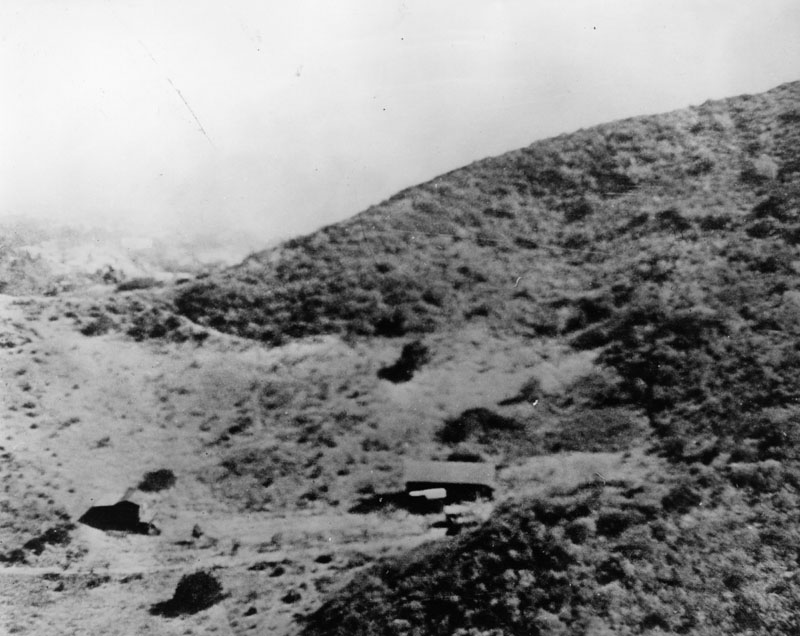 |
|
| (1919)* - View of the large hillside on which the Bowl would be built. There are two or three small wooden buildings at center on a part of the hill that has been cleared of trees. The hillside at left is still wooded and in the distance at left, parts of the city of Hollywood are visible. The property was acquired in three separate parcels "the entry Pepper Tree Lane ( from a postman and his wife); the parking lot, called Daisy Bell, from Mrs. Hershey; and the balance, including the Bowl itself, from a carpet cleaning company. The building in the photo belonged to the carpet cleaning company". |
Historical Notes Although people often think the name Hollywood Bowl refers to the dome-shaped band shell on the stage, it is actually a reference to the natural bowl-shaped area surrounded by the Hollywood Hills formerly known as the Daisy Dell. The 59 acre Bolton Canyon site was originally purchased in 1919 by the Theatre Arts Alliance Inc. for $47,500 to build a community park and art center. They originally called it "The Park". |
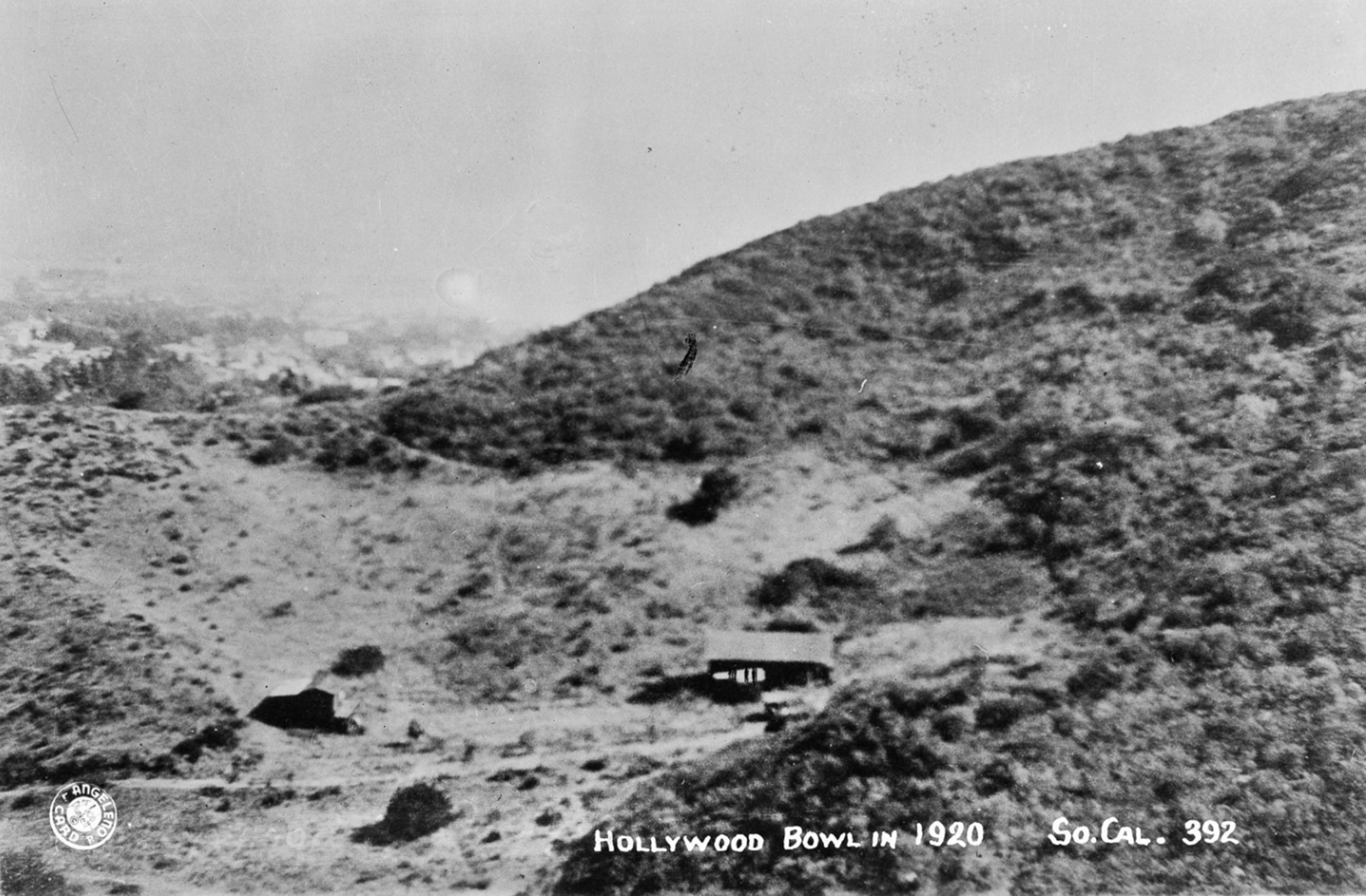 |
|
| (1920)* – Postcard view showing Bolton Canyon, the future site of the Hollywood Bowl. At the time, the canyon was also known as Daisy Dell, a popular picnic spot nestled in the scenic Cahuenga Pass. Photo from the Ernest Marquez Collection |
Historical Notes Christine Wetherill Stevenson, president of Theatre Arts Alliance, wanted the Alliance to focus on religious productions such as the Pilgrimage Play. When her partners objected to limiting the site's use to religious productions, she sold them her share of the property and built the theater across the street that became the Pilgrimage Play Theatre (later the John Anson Ford Amphitheatre) to host her show. Christine Stevenson was an heiress of the Pittsburgh Paint Company. A 32-foot-high steel cross, at 2580 Cahuenga Boulevard was erected in 1923 to the memory of Miss Stevenson. |
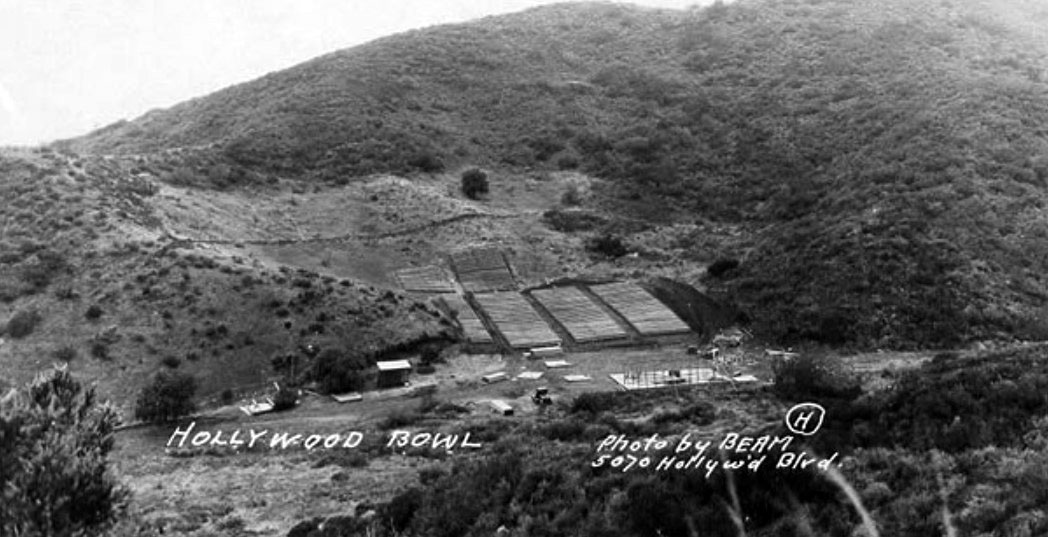 |
|
| (1921)* – Postcard view showing stage construction and benches at the Hollywood Bowl. |
Historical Notes In 1921, wooden benches were installed on the natural hillsides of Bolton Canyon for early performances. When the Hollywood Bowl officially opened on July 11, 1922, the audience continued to sit on these benches. |
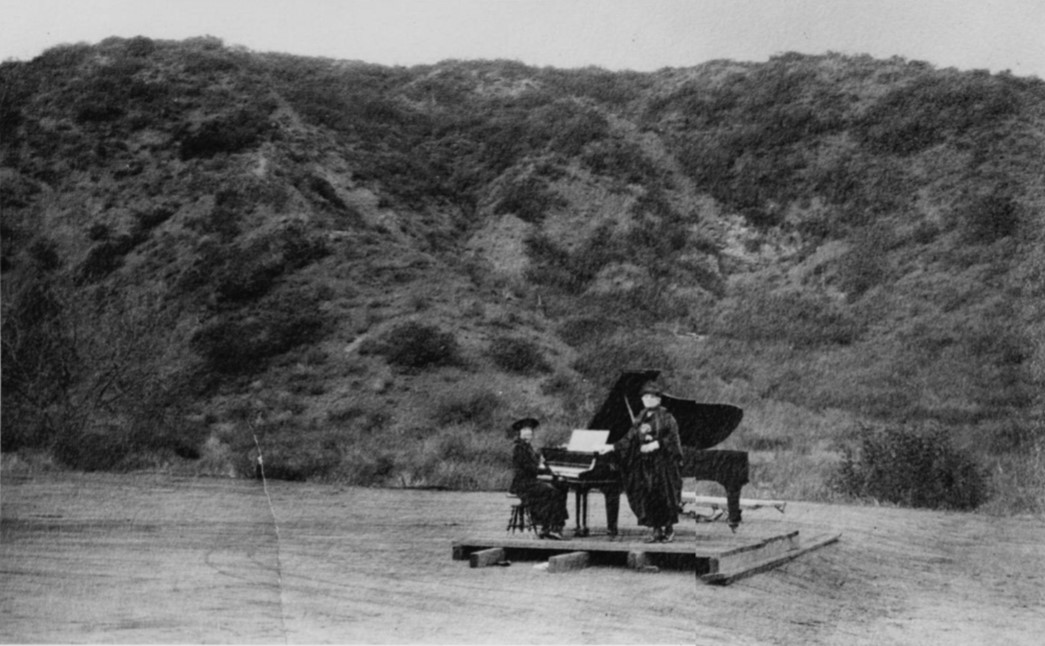 |
|
| (1920)* - The first known performance in Daisy Dell (now the Hollywood Bowl). Gertrude Ross and Anna Ruzena Sprotte on a simple stage in the bowl-shaped canyon. |
Historical Notes In 1920, Soprano Anna Ruzena Sprotte and composer/pianist Gertrude Ross trucked in a piano to test the acoustics from a platform at the bottom of the hill to figure out how best to situate the stage. This is the first known performance in Daisy Dell. In 1920, Community Park and Art Association was established, replacing the Theatre Arts Alliance. Artie Mason Carter, secretary of the Association, lead the effort to develop community support of the proposed theatre. In 1920, the site was first referred to as the "Hollywood Bowl." |
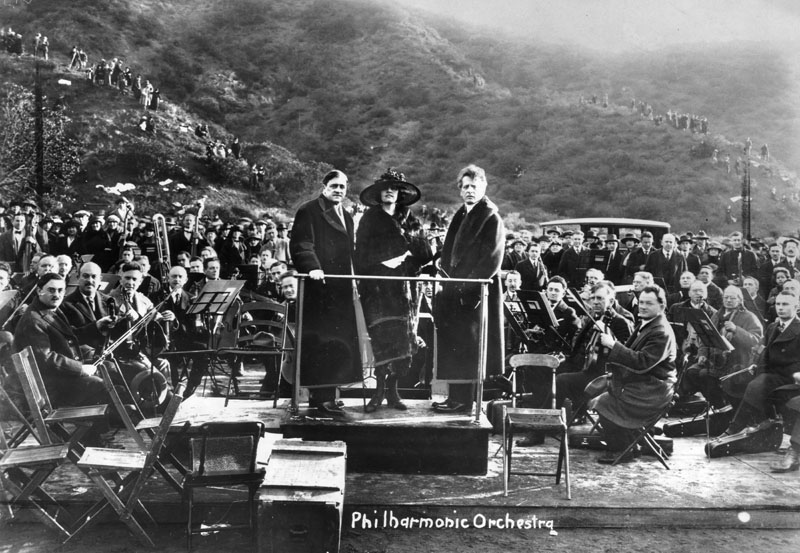 |
|
| (1921)* - First Easter sunrise service in the Bowl. Photo captions reads: "L.A. Philharmonic greets dawn at Hollywood Bowl's first Easter service." |
Historical Notes: In 1921, the Los Angeles Philharmonic performed its first Easter Sunrise Service at the Hollywood Bowl site in a program presented from a small wooden platform. Eight-hundred people filled the site’s wooden benches; the rest of the attendees settled themselves on blankets among the hillside’s weeds and grass. |
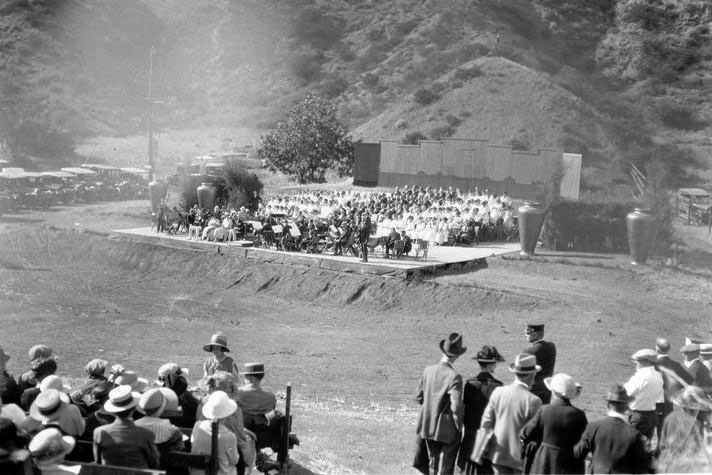 |
|
| (1921)* – An orchestra performing on a wood stage at the Hollywood Bowl with what appears to be a choir behind it. Note how the stage is positioned on top of a dirt mound. |
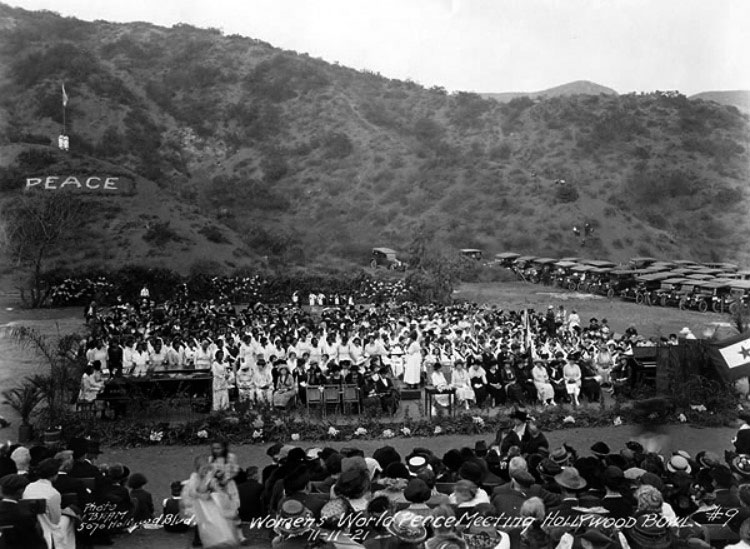 |
|
| (1921)* – View of the Women’s World Peace Meeting on November 21, 1921. |
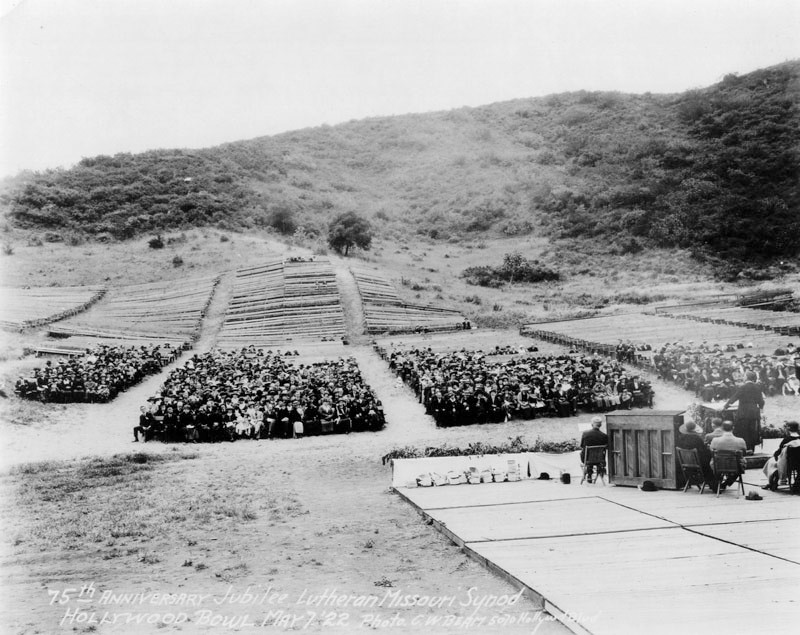 |
|
| (1922)* - Hundreds of attendants sit in wooden benches for the 75th Anniversary Jubilee, Lutheran Missouri Synod held at the Hollywood Bowl on May 7, 1922. |
LA Philharmonic Orchestra
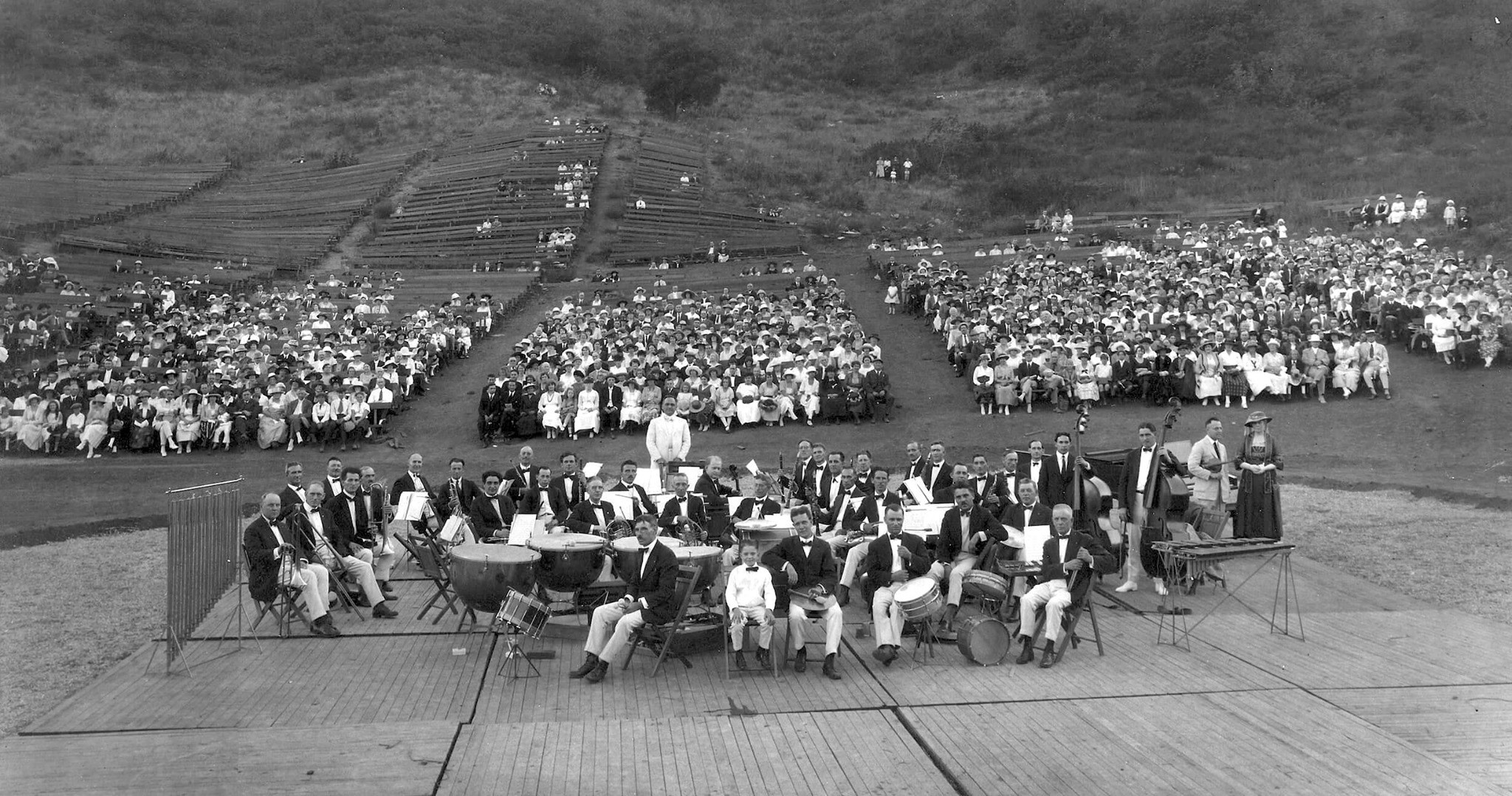 |
|
| (1921)* – Panoramic view showing the Los Angeles Philharmonic playing in the Daisy Dell at soon-to-be Hollywood Bowl. |
Historical Notes The Los Angeles Philharmonic played a concert at Daisy Dell on August 28, 1921. Within a year of this photo being taken, the temporary-looking stage those musicians are sitting on will be replaced by the first incarnation of the Hollywood Bowl.* |
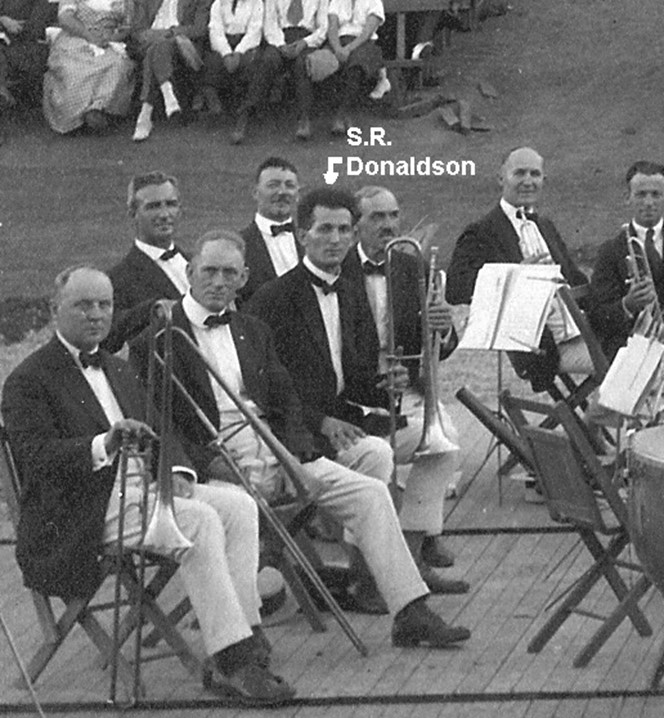 |
|
| (1921)* – Blow-up view of previous photo showing S.R. Donaldson holding the trombone playing in the LA Philharmonic Orchestra. Photo was submitted by his son, Bill Donaldson. Photo courtesy of Martin Turnbull |
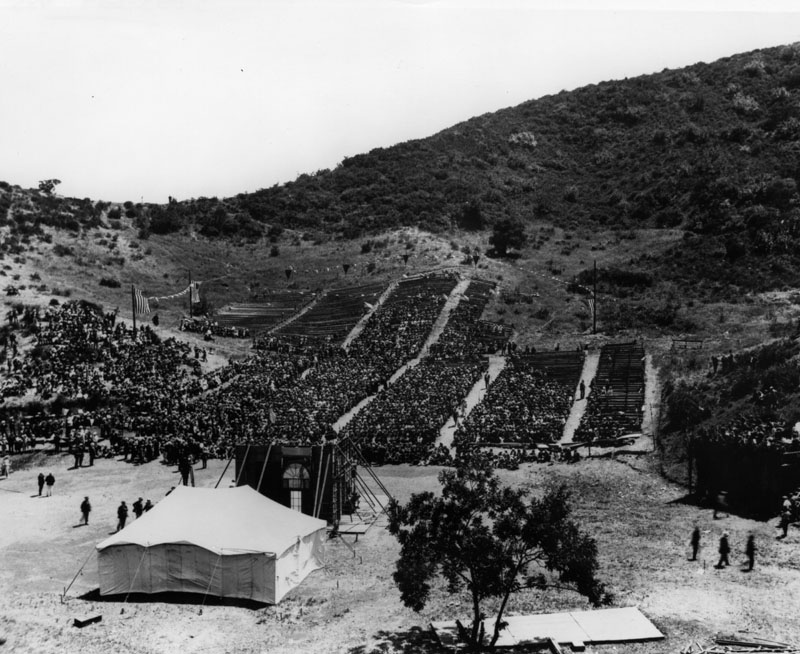 |
|
| (ca 1921)* - View of a Rotary Club meeting held at the Hollywood Bowl. |
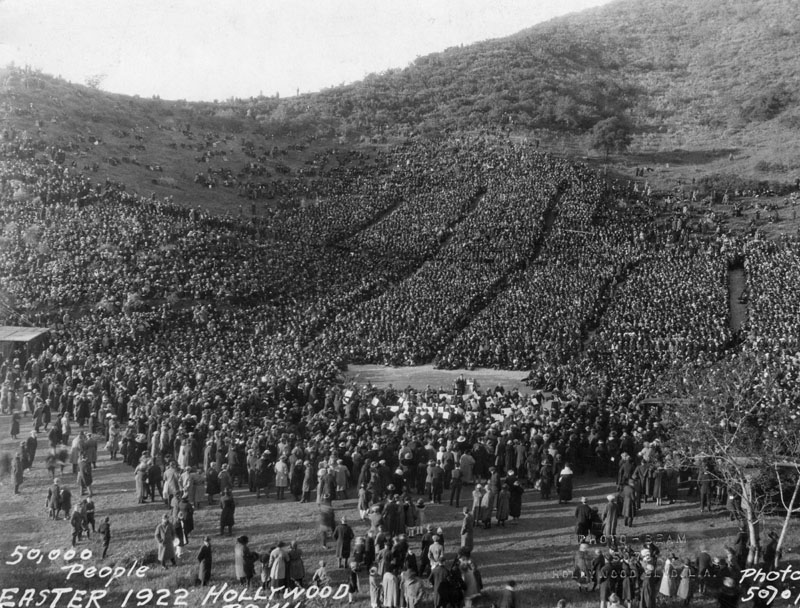 |
|
| (1922)* - Around 50,000 people gathered for the Easter sunrise service in the Hollywood Bowl. An even larger crowd was expected there on Easter morning when the Los Angeles Philharmonic Orchestra played for the worshipers. The Hollywood Bowl would officially be opened four months later on July 11, 1922. |
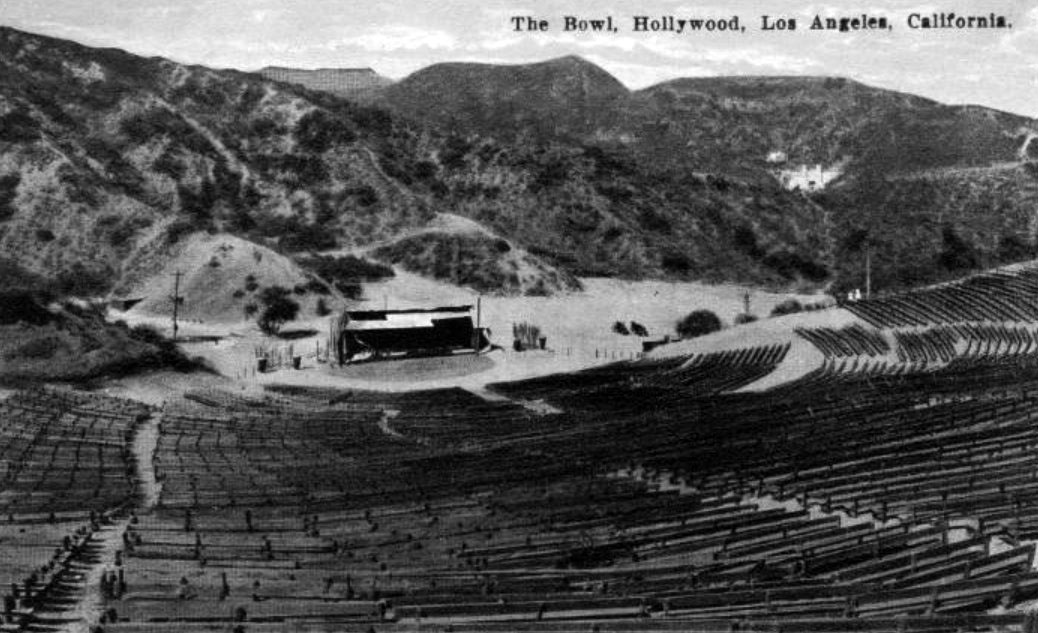 |
|
| (1922)* – Postcard view of the Hollywood Bowl showing its new covered wooden stage. The large open space to the right is a parking lot. In the upper center-right can be seen the Pilgrimage Play Theatre (later John Anson Ford Theatre). |
Historical Notes The Pilgrimage Amphitheatre was built in 1920. The author, Christine Wetherill Stevenson, believed the rugged beauty of the Cahuenga Pass would provide a dramatic outdoor setting for The Pilgrimage Play. Together with Mrs. Chauncey D. Clark, she purchased this land along with that on which the Hollywood Bowl now sits. A wooden, outdoor amphitheater was built on this site and the play was performed by noted actors every summer from 1920 to 1929, until the original structure was destroyed by a brush fire in October 1929. In 1976, the Pilgrimage Theatre was renamed the John Anson Ford Theatre in honor of the late L.A. County Supervisor's significant support of the arts. |
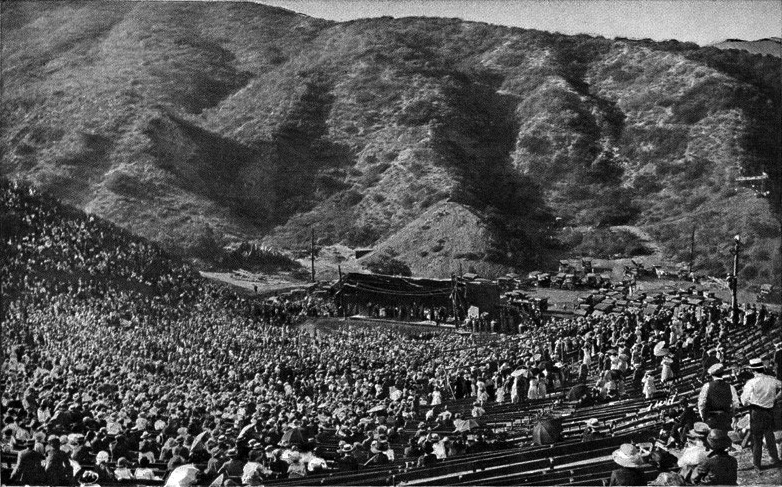 |
|
| (ca. 1922)* – The Hollywood Bowl is filled with spectators as a performance is under way under the makeshift stage housing. |
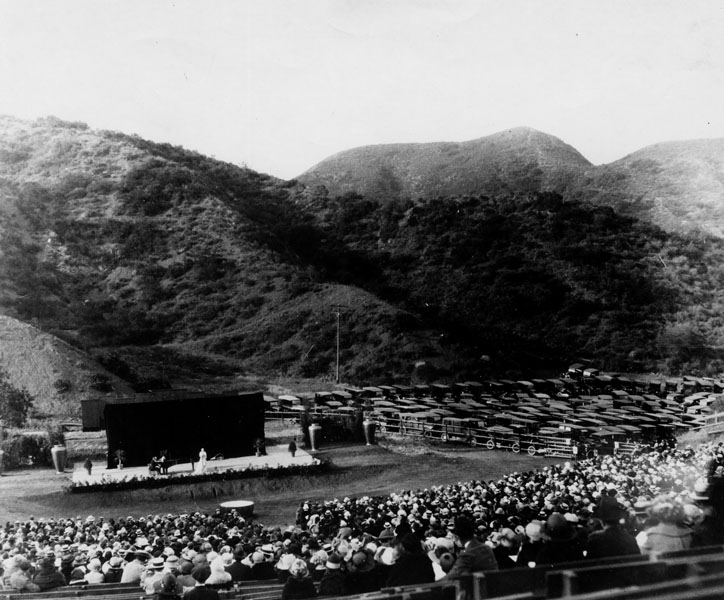 |
|
| (ca. 1922)* - Concert by Rosa Paniella at the Hollywood Bowl prior to its official opening. Note the full parking lot to the right of the stage. |
Historical Notes Before the establishment of an official season, Daisy Dell (now Hollywood Bowl) was used for presentations of choral programs, pageants, Shakespeare plays, and band concerts. Most of the proceeds were used to fund the Bowl's first concert season. |
LA Philharmonic 1st Season at the Bowl
 |
|
| (July 11, 1922)* - Hollywood Bowl at first Symphony Under the Stars. This was the "Bowl's" official opening and was on the site of a natural amphitheater formerly known as the Daisy Dell. |
Historical Notes On July 11, 1922, with the audience seated on simple wooden benches placed on the natural hillsides of Bolton Canyon, conductor Alfred Hertz and the Los Angeles Philharmonic inaugurated the first season of music under the stars at the Hollywood Bowl. The Bowl was very close to its natural state, with only makeshift wooden benches for the audience, and eventually a simple awning over the stage. |
.jpg) |
|
| (ca. 1923)* - View looking toward the stage from an upper row of seats. The stage of the Hollywood Bowl is shown at center, bordered on each side by columns. Curved rows of bleacher-like seats sit to the left of the camera, while in front of it are rows of box seats. A group of several people stands in the front rows of the center and right sections of seats. |
Historical Notes The first 150 box seats were built in front of the bench seating sections in 1923. |
 |
|
| (1920s)* - View showing a concert at the Hollywood Bowl. Spectators in the rear seats have their umbrellas open. The stage was embellished with classical designs including Greek columns, pergolas and urns. The Pilgrimage Play Theatre is seen in the distance (upper-right) |
Historical Notes The Hollywood Bowl has been the summer home of the Los Angeles Philharmonic, since its official opening in 1922. Tickets were 25 cents. |
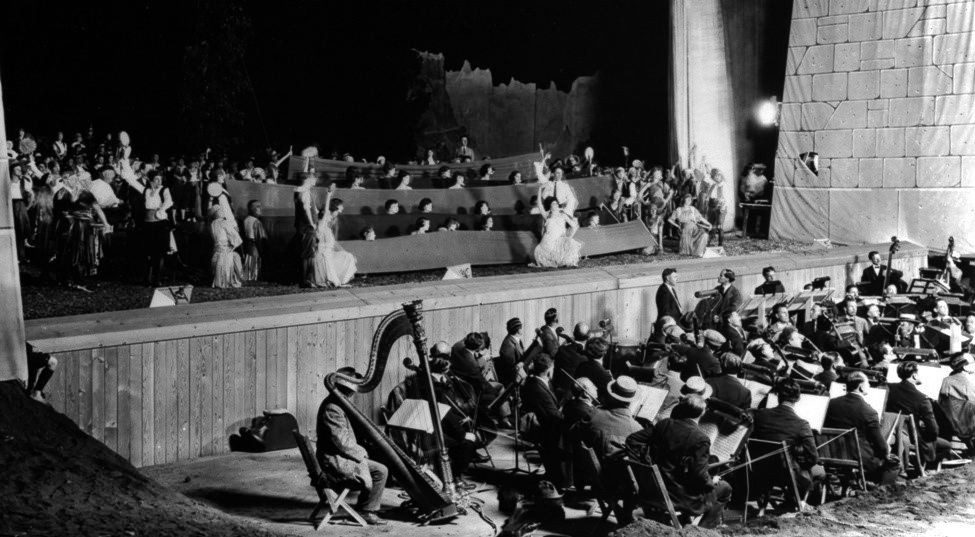 |
|
| (1922)* - A pre-season performance of Bizet's Carmen is presented; the evening's proceeds are used to pay for the Hollywood Bowl's first seats. |
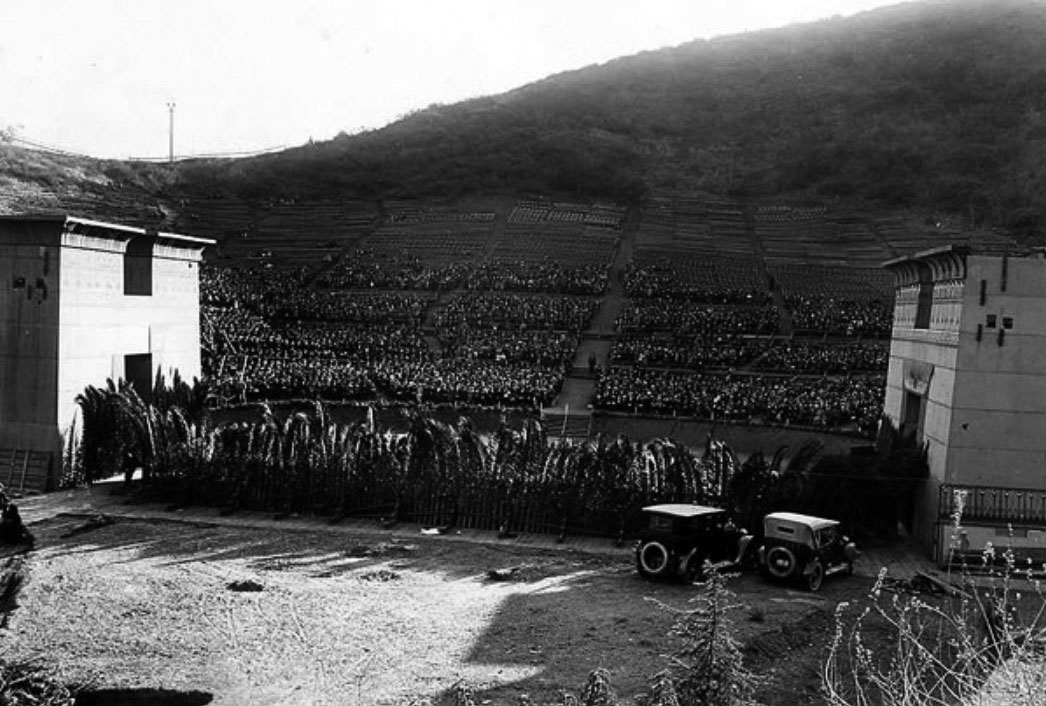 |
|
| (1922)* – View from behind the stage. Note how the seating area has been expanded. |
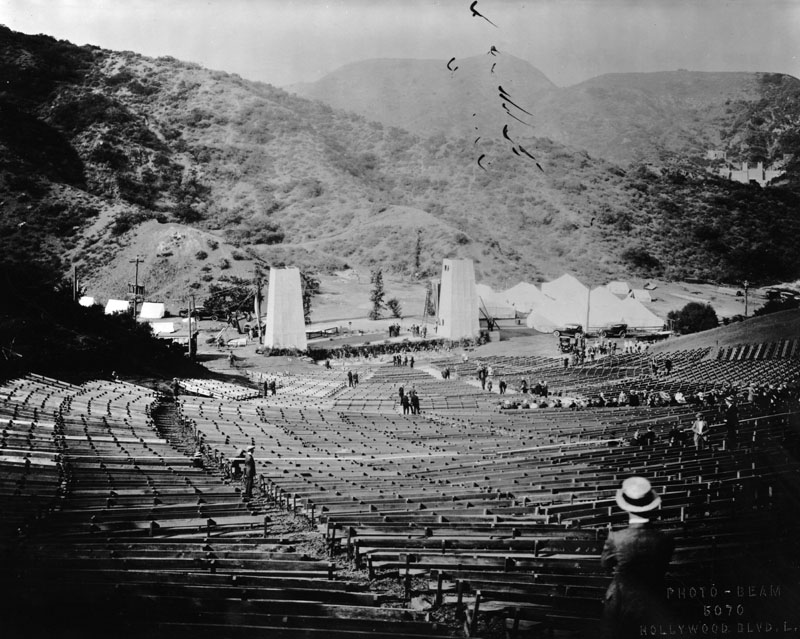 |
|
| (1923)* - View of the Hollywood Bowl as seen from the top of the seating, looking down towards the stage. |
Historical Notes In 1923, the Hollywood Bowl’s first 150 boxes were built. Also in 1923, the Hollywood Bowl’s debt was paid off and the mortgage burned on the Bowl’s stage. Among the donors who helped retire the debt were perennial presidential candidate William Jennings Bryan, who made a $100 donation. |
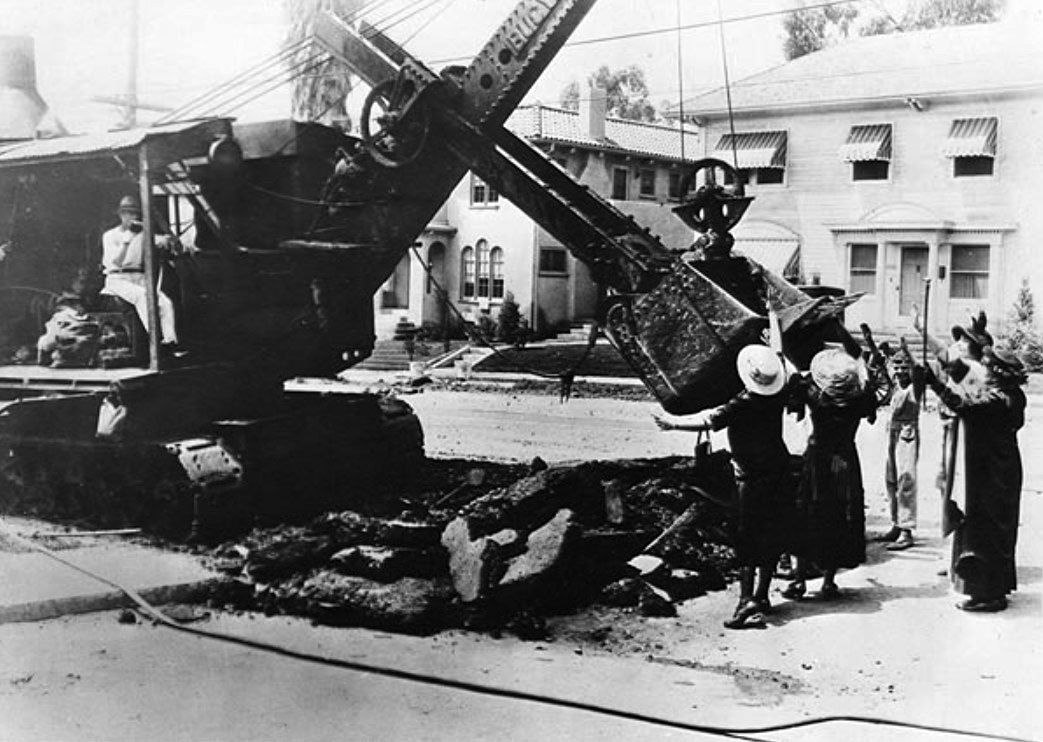 |
|
| (1923)* – Protesting roadwork on Highland Avenue. |
Historical Notes With the re-paving of Highland Avenue sure to disrupt the Hollywood Bowl’s season, Bowl leader Artie Mason Carter took to the streets to protest the city’s work. She and another woman manned “battle positions” in rocking chairs (with their knitting) in the middle of Highland Avenue and refused to allow crews to break up the street. The result? Paving was rescheduled for the 1923 Bowl’s off-season. |
* * * * * |
Pepper Tree Lane (aka Bowl Road)
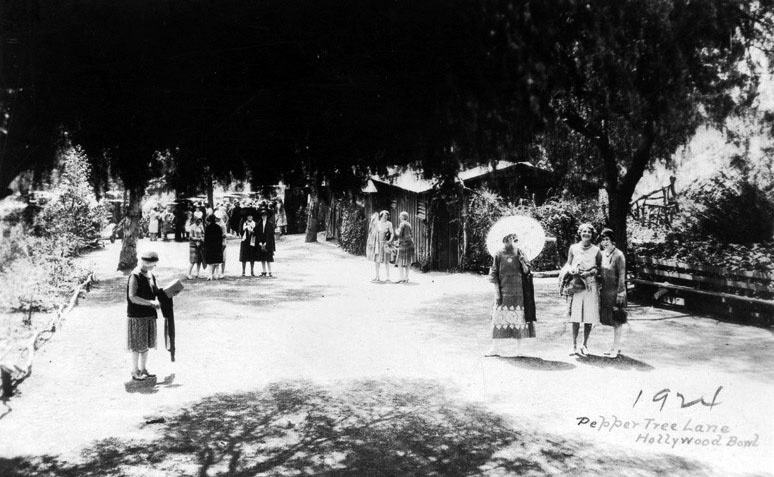 |
|
| (1924)* – Postcard view showing several groups of women standing on Pepper Tree Lane, the entrance pathway to the Hollywood Bowl. |
Historical Notes In 1924, the Hollywood Bowl land and property was deeded to the County of Los Angeles to safeguard the Bowl for future generations. The Hollywood Bowl Association was established as the theatre's governing organization. The main road leading to the Hollywood Bowl in the 1920s was known both as "Pepper Tree Lane" and, more informally, as the "Bowl" Road. This dirt path, lined with pepper trees and rustic wooden fences, served as the primary entrance for concertgoers arriving from Highland Avenue. The lane provided a picturesque and rural approach to the Bowl’s natural amphitheater, Daisy Dell, setting the stage for the outdoor music experience that would become a hallmark of the venue. |
.jpg) |
|
| (1924)* – View of Pepper Tree Lane, looking west, Hollywood Bowl. |
Historical Notes The rustic charm of Pepper Tree Lane and its surroundings contributed to the unique character of the Hollywood Bowl in its formative years. The road’s rural atmosphere and the open landscape around it offered a dramatic contrast to the growing city of Hollywood visible in the distance. Before later improvements and expansions, this setting helped establish the Bowl as a beloved outdoor venue, deeply connected to the natural beauty of the Hollywood Hills. |
 |
|
| (ca. 1925)* — View showing the original dirt approach to the Hollywood Bowl, known as “Bowl Road” or “Pepper Tree Lane.” Shaded by pepper and eucalyptus trees and lined with rustic wooden fencing, this winding path led from Highland Avenue to the Bowl’s natural amphitheater, originally known as Daisy Dell. Modest homes, including those of the site’s early caretakers, appear in the background. Photo from the Ernest Marquez Collection. |
Historical Notes The above photo of Pepper Tree Lane/Bowl Road shows a handful of houses and small wooden buildings in the background. Among these was the modest home built by H. Ellis Reed and his father, the original caretakers who discovered and helped develop the site. Other structures were remnants from previous landowners, including a carpet cleaning company whose property was later incorporated into the Bowl grounds. These simple homes and outbuildings dotted the hillsides, reflecting the area’s sparse development at the time |
 |
|
| (2025)* - Pepper Tree Lane. Photo courtesy of the Hollywood Bowl 100. |
Historical Notes Today, Pepper Tree Lane remains the main pedestrian approach to the Hollywood Bowl, guiding visitors from Highland Avenue up to the venue’s Main Plaza and entrance gates. While modernized with enhanced lighting and landscaping, the lane still preserves its historic role as a scenic transition from the city into the Bowl’s natural amphitheater. Mature trees line the walkway, and at its base stands the Hollywood Bowl Museum, welcoming guests and providing a sense of the site’s rich cultural legacy. Though the rustic fences and dirt road of the 1920s are gone, Pepper Tree Lane continues to embody the spirit of arrival and anticipation, serving as both a functional path and a symbolic gateway to one of Los Angeles’s most iconic landmarks. |
Then and Now
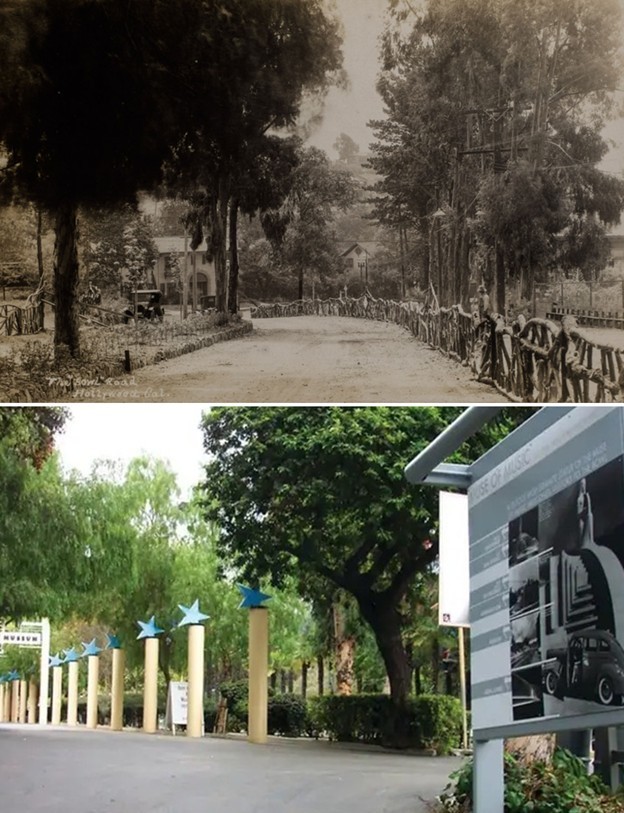 |
|
| (1925 vs. Today)* – A ‘Then and Now’ view of Pepper Tree Lane, the original dirt road leading to the Hollywood Bowl from Highland Avenue. Once shaded by pepper and eucalyptus trees and lined with rustic wooden fences, the lane has since been transformed into a paved entrance walkway marked by star-topped columns. While much has changed, this path still serves as the gateway to the Bowl’s storied amphitheater. Photo comparison by Jack Feldman. |
* * * * * |
Regrading the Hollywood Bowl: 1926 Transformation and the Lost Acoustics
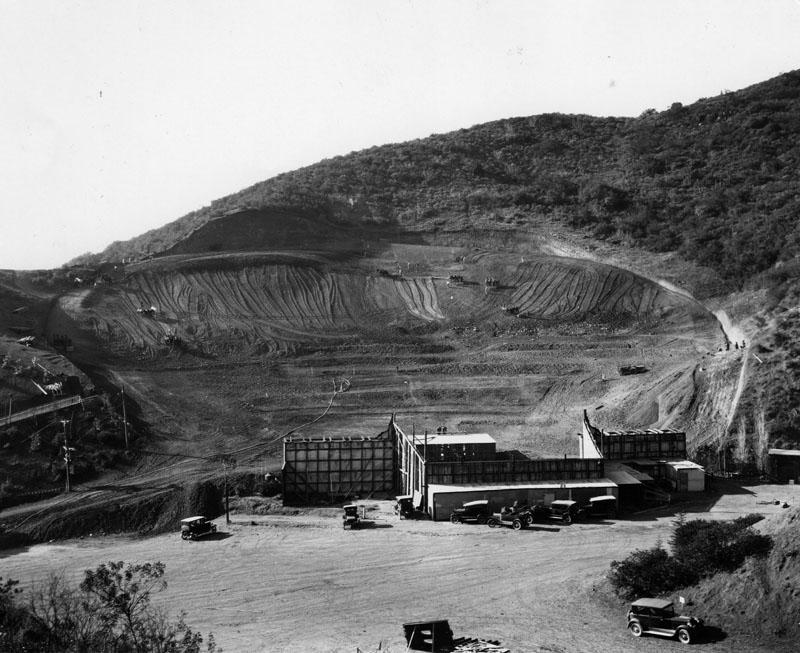 |
|
| (1926)* - The hillside is being excavated to provide increased capacity and permanent seating at the Hollywood Bowl. |
Historical Notes In 1926, a group known as the Allied Architects was contracted to re-grade the Bowl, providing permanent seating and a shell. These improvements did provide increased capacity (the all-time record for attendance was set in 1936, when 26,410 people crowded into the Bowl to hear opera singer Lily Pons), but were otherwise disappointing, as the re-grading noticeably degraded the natural acoustics. Pasadena architect and Rose Bowl designer Myron Hunt created an elliptical form for the Hollywood Bowl’s seating amphitheater. His layout features monumental stairways that reinforce the seating area’s dramatic balloon shape, which has been described as being “poised to fill with music and ascend.” |
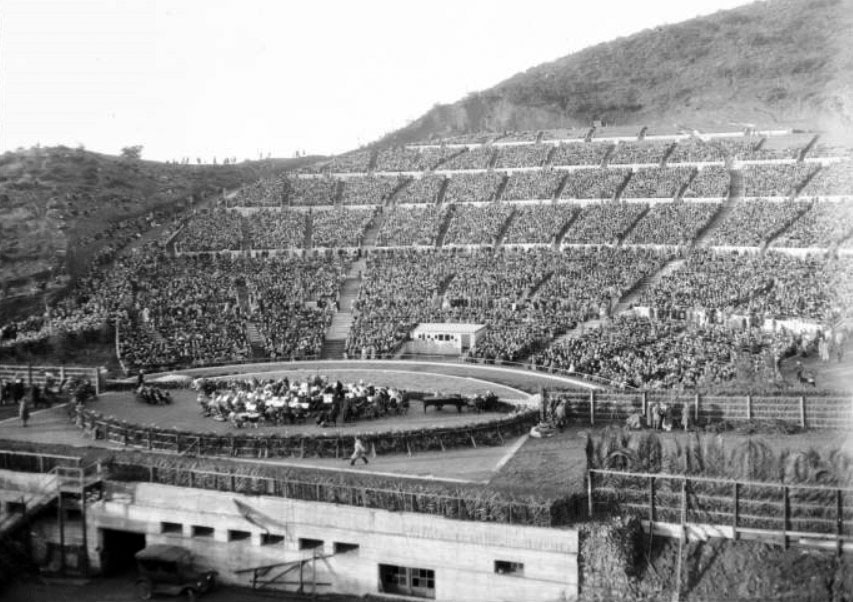 |
|
| (1926)* - View of an orchestra in the center ring of the Hollywood Bowl shortly before the first shell was built. A small orchestra is pictured at center, in the middle of an open-air circle of grass. Past them, the seats along the nearby slope are nearly all filled. In the foreground, an automobile can be seen parked below the stage. |
Historical Notes 1925 saw the first radio broadcasts from the Hollywood Bowl. The Los Angeles Philharmonic was the first major symphony orchestra in the United States to broadcast an entire concert on the radio. |
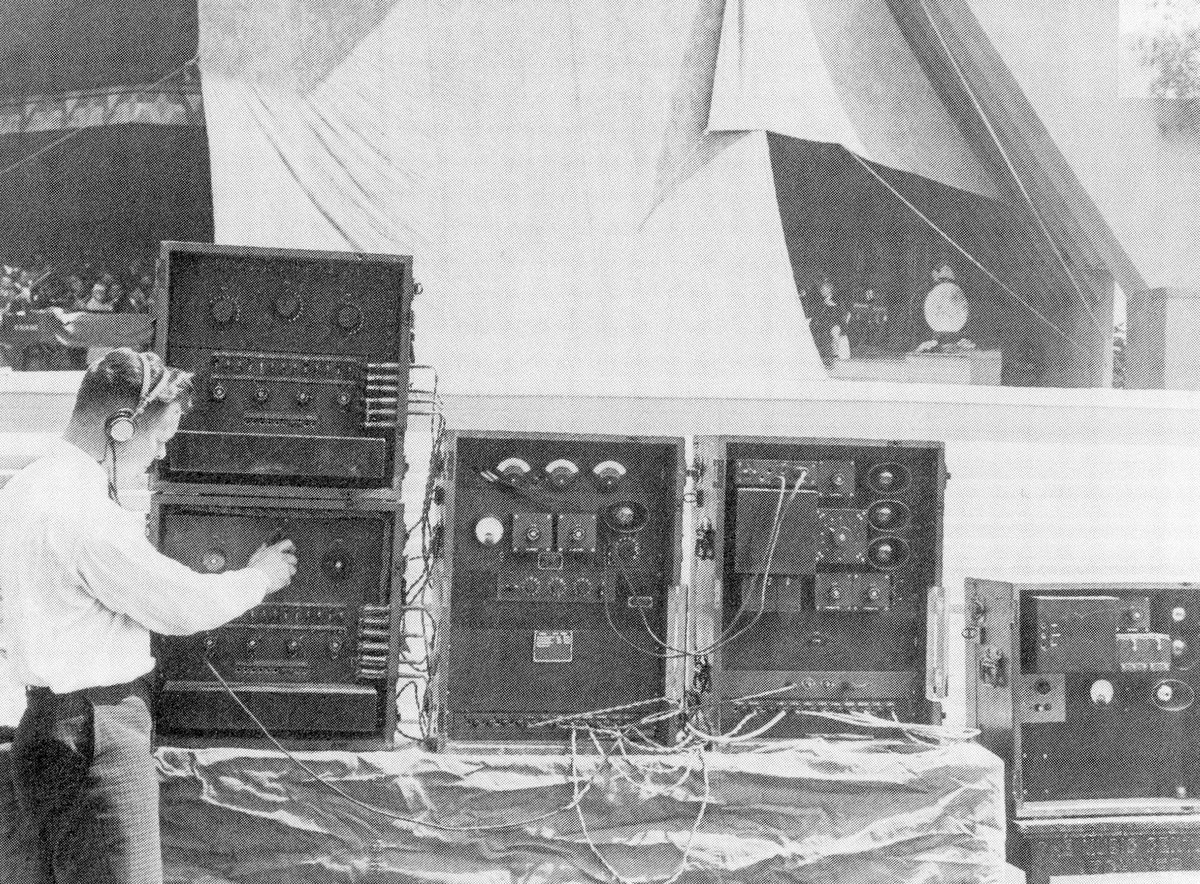 |
|
| (ca. 1926)* - The first radio broadcasts are transmitted from the Bowl. The Los Angeles Philharmonic is the first major symphony orchestra in the United States to broadcast an entire concert on the radio. |
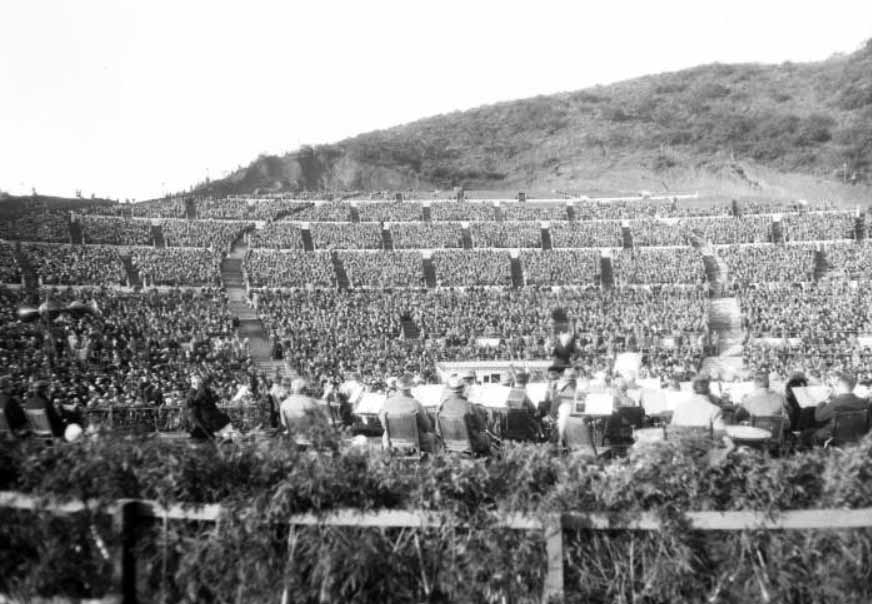 |
|
| (1926)* - View of the Hollywood Bowl, showing the symphony from behind. Plants hang over a wooden fence in the foreground while the musicians of the symphony sit and face their conductor at center. Thousands of people view the concert from the stadium seats across the background. Hills stand at the top of the seats. |
Historical Notes About 20,000 people watch the Hollywood Bowl dedication concert from new, permanent seats. The amphitheater space, deepened and filled with a concrete foundation featuring long aisles and pathways, wraps around an enlarged stage. These improvements mark the first $100,000 of a million-dollar improvement plan. |
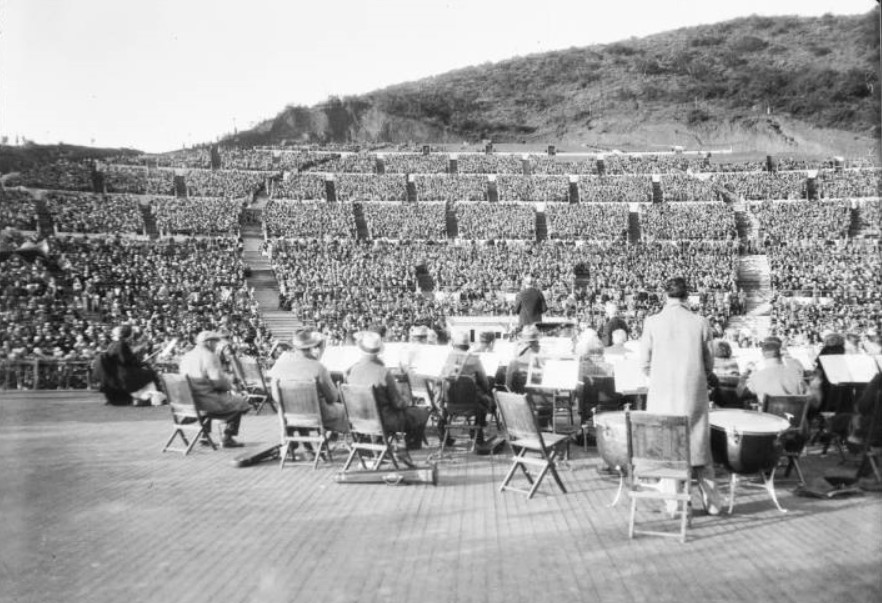 |
|
| (1926)* - The Hollywood Bowl, showing the symphony from backstage. The timpani player stands over his instrument in the right foreground. The symphony sits with their instruments at rest as they face their director at center. He faces the crowd in the background. Thousands of people sit in the stadium with a grassy hill behind them. |
Historical Notes With the completion of the Pacific Electric Railway on Highland Avenue, the Bowl became more accessible and saw an increase in attendance. |
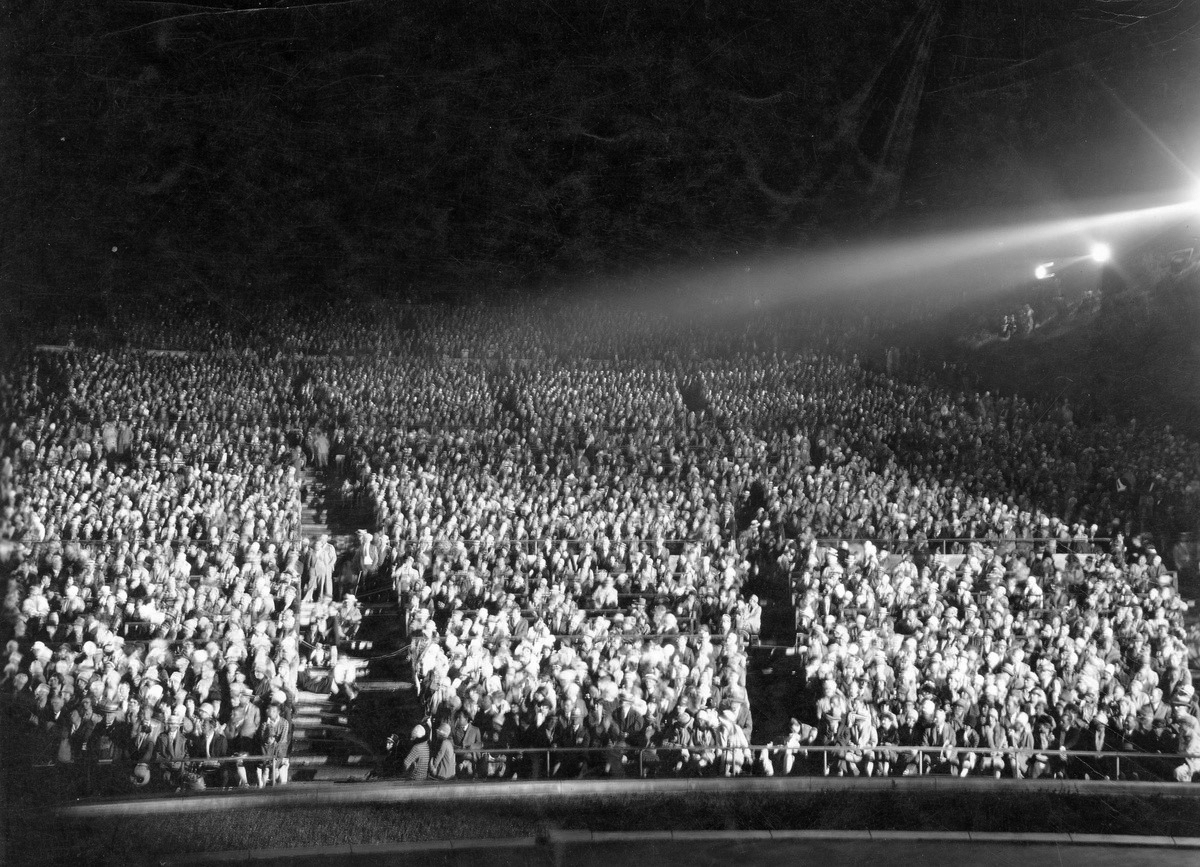 |
|
| (1926)* - Full house at the Hollywood Bowl. |
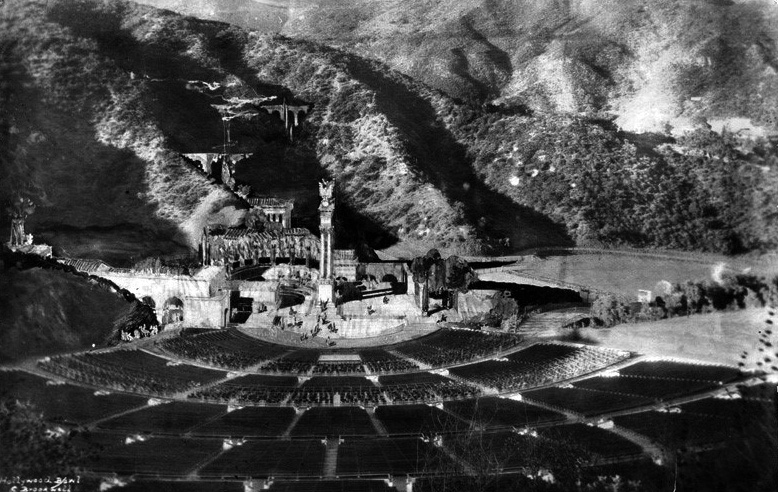 |
|
| (1926)* – View of the stage setting for "Julius Caesar.” Note how far the stage set is extended up the hillside, both behind and on the side of the Bowl. Set design by Lloyd Wright. |
Historical Notes In 1926, an elaborate performance of the play Julius Caesar was staged as a benefit for the Actors' Fund of America at the Hollywood Bowl. Caesar arrived for the Lupercal in a chariot drawn by four white horses. The stage was the size of a city block and dominated by a central tower eighty feet in height. |
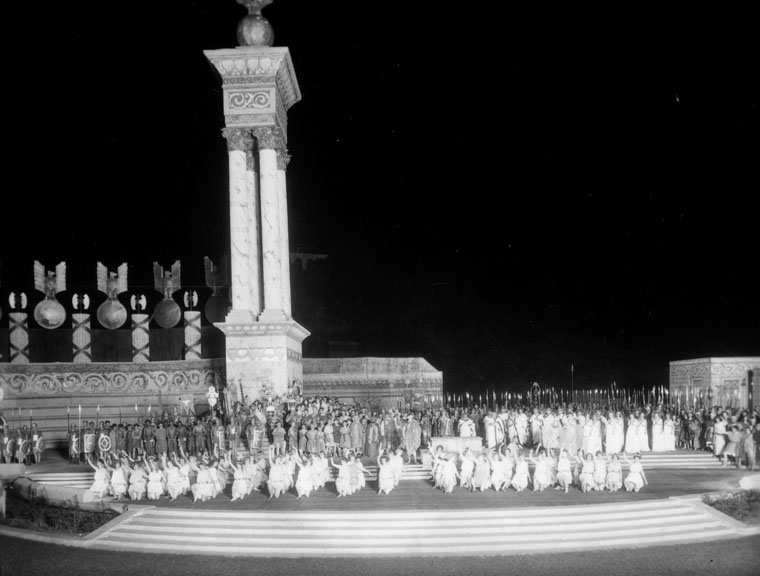 |
|
| (1926)* - Stage play of "Julius Caesar" being performed at the Hollywood Bowl. Directed by Gordon Craig. |
Historical Notes The 1926 Julius Caesar production was mainly aimed at creating work for unemployed actors. Three hundred gladiators appeared in an arena scene not featured in Shakespeare's play; a similar number of girls danced as Caesar's captives; a total of three thousand soldiers took part in the battle sequences. |
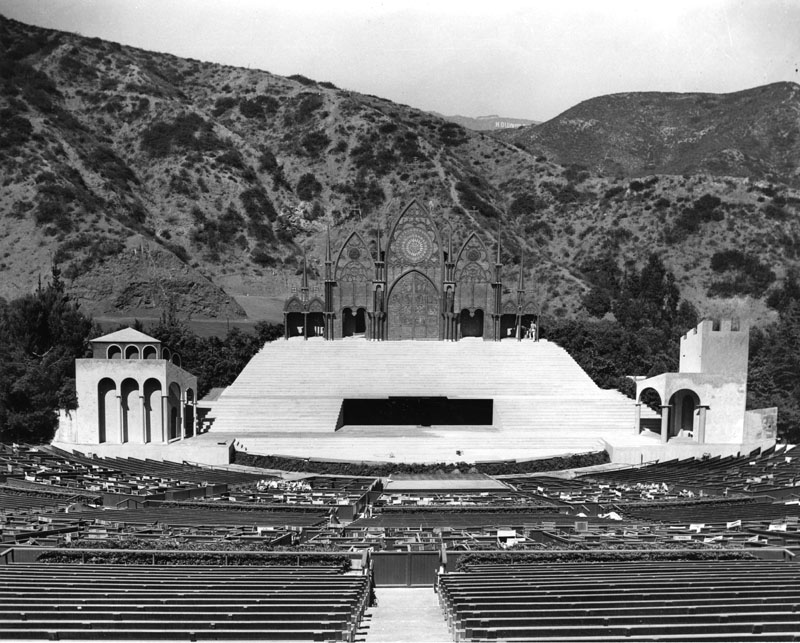 |
|
| (1926)* - Hollywood Bowl before the shell was added. In place of the shell there is an elaborate stage set. |
* * * * * |
Hollywood Bowl's First Shell
 |
|
| (1926)* - The Hollywood Bowl's first shell shortly after its completion. View is from the top of the seating area looking down towards the stage. |
Historical Notes In 1926, the first rendition of the venue’s iconic proscenium shell was built. The original shell was deemed acoustically unsatisfactory (as well as visually unfashionable, with its murals of sailing ships). It would be torn down at the end of the season. Pasadena architect and Rose Bowl designer Myron Hunt created the elliptical form for the Hollywood Bowl's seating amphitheater. His layout featured monumental stairways that reinforced the seating area's dramatic balloon shape, which was described as being "poised to fill with music and ascend." |
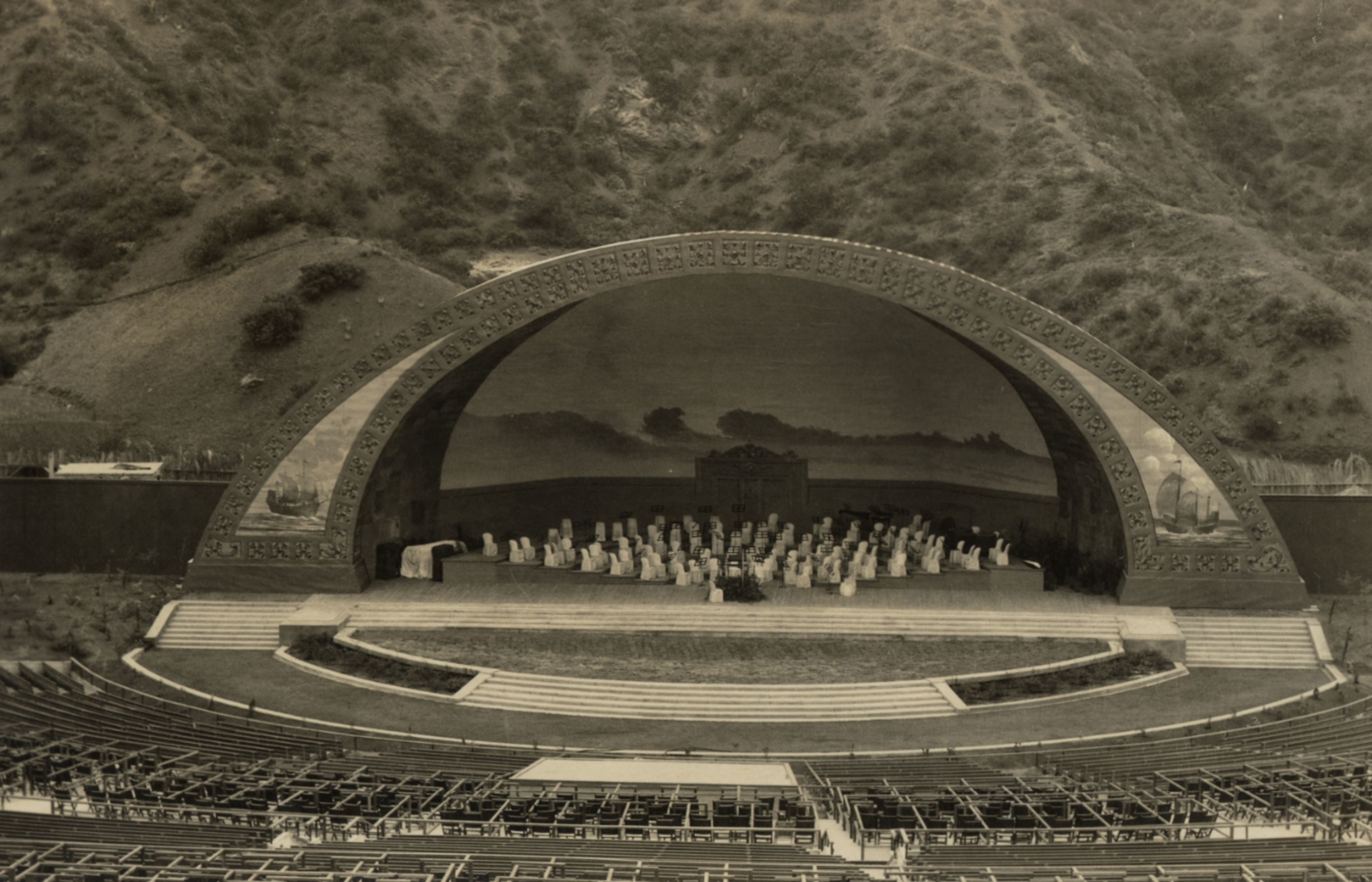 |
|
| (1926)* - The Hollywood Bowl's first shell designed by the Allied Architects Association |
Historical Notes The Hollywood Bowl's first shell designed by the Allied Architects Association was a semi-elliptical structure that aimed to preserve the view of the hillside behind it. However, it inadvertently blocked the natural resonance of the canyon, making it difficult for audiences to hear the music clearly. As a result, this initial shell only lasted for one season before being replaced. |
 |
|
| (1926)* - Close-up view showing the original Hollywood Bowl Shell. |
Historical Notes The acoustics of the first Hollywood Bowl shell, installed in 1926, were considered poor. This shell, designed by the Allied Architects Association, was deemed unacceptable both visually and acoustically. As a result, it was quickly replaced. |
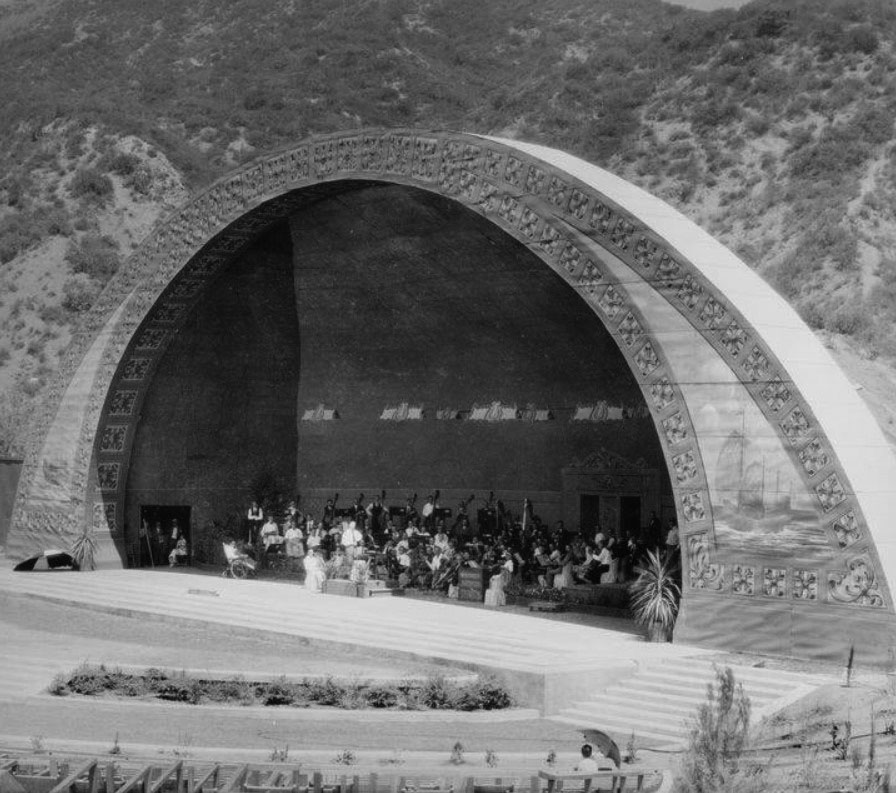 |
|
| (1926)* – Close-up view showing Hollywood Bowl’s first shell shortly after it was completed. Note the mural and designs on the front face of bowl. |
Historical Notes Before the installation of this first shell, performers at the Hollywood Bowl played in the open air on wooden platforms with canvas coverings. The introduction of the shell marked a significant change in the venue's appearance and functionality. |
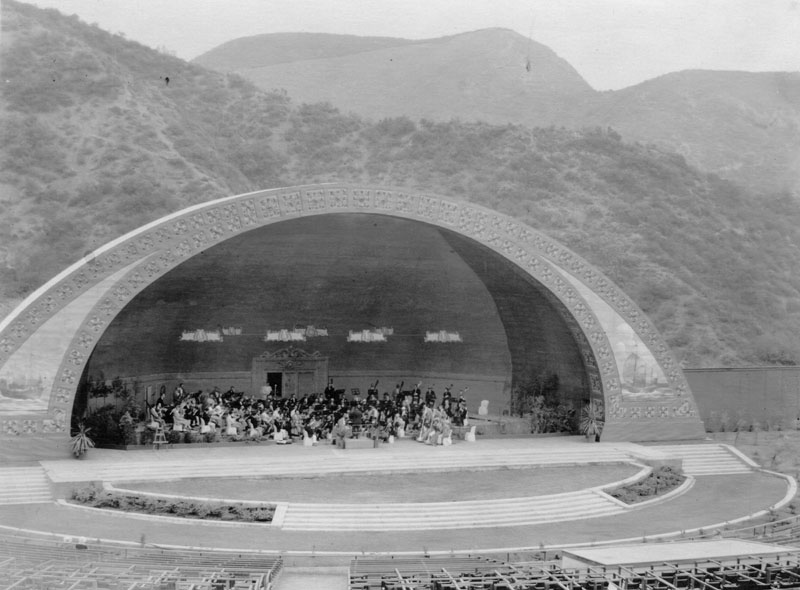 |
|
| (1926)* - Orchestra practicing at the Hollywood Bowl with its new Allied Architects Association designed shell. |
Historical Notes Both Myron Hunt and Allied Architects played important roles in the Hollywood Bowl's development, but for different aspects: Myron Hunt designed the Hollywood Bowl's amphitheater in 1926, creating the elliptical, terraced seating area that is still in use today15. Allied Architects, a separate entity, was responsible for designing and building the iconic shell structure. |
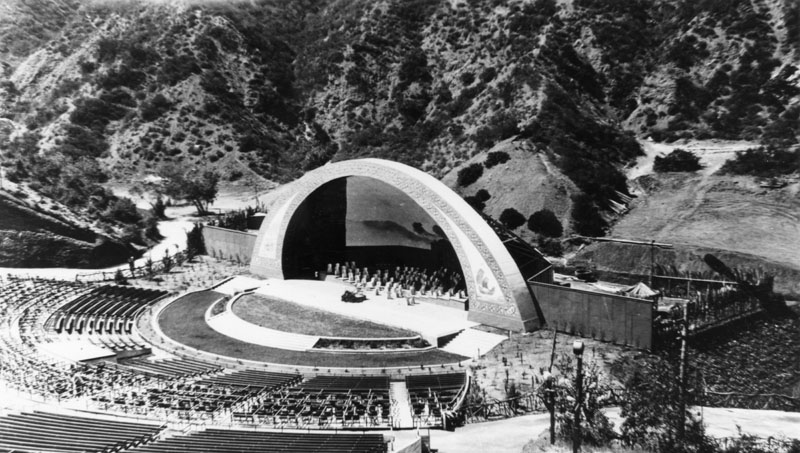 |
|
| (1926)* - Another view of the Hollywood Bowl's new shell. |
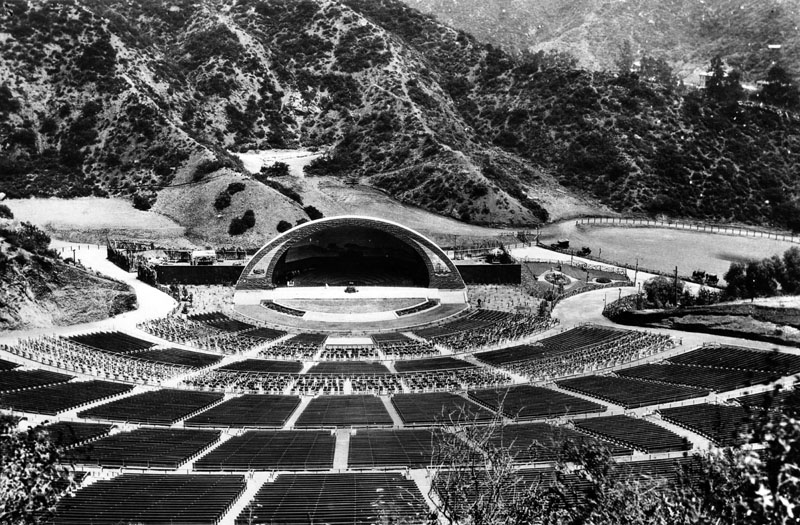 |
|
| (1926)* - View is looking from the top of the hill towards the seating and inner shell of the Hollywood Bowl. |
Historical Notes The 1926 shell was replaced in 1927 with a new design by Lloyd Wright (son of Frank Lloyd Wright). |
* * * * * |
Hollywood Bowl's 2nd Shell
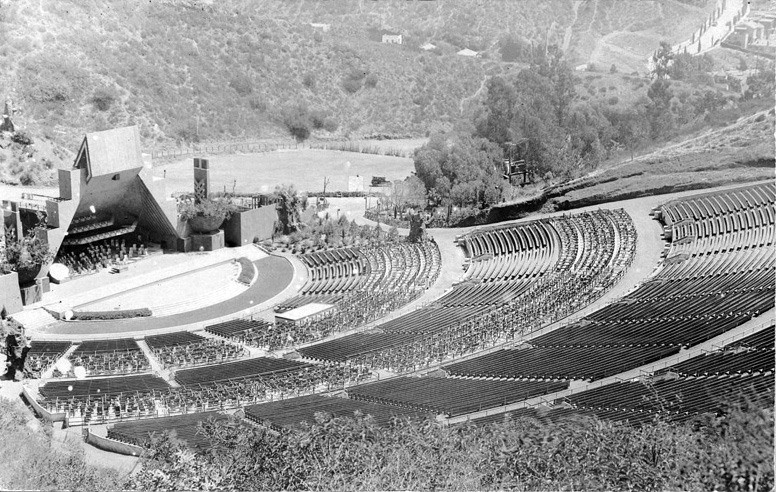 |
|
| (1927)* - View of the Pyramid-shaped shell of the Hollywood Bowl. This was the Bowl's 2nd Shell. |
Historical Notes For the 1927 season, Lloyd Wright (the son of Frank Lloyd Wright), built a pyramidal shell, with a vaguely Southwestern look, out of left-over lumber from a production of Robin Hood. This was generally regarded as the best shell the Bowl ever had from an acoustic standpoint; unfortunately, its appearance was deemed too avant-garde, and it was demolished at the end of the season. It did, however, get Wright a second chance, this time with the stipulation that the shell was to have an arch shape. |
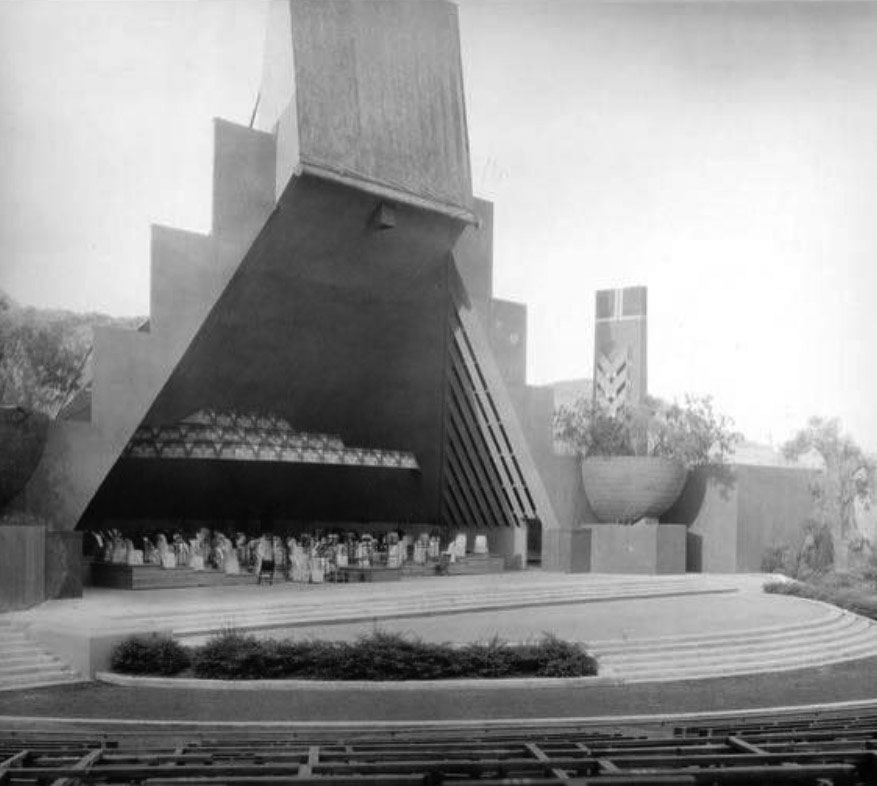 |
|
| (1927)^ – Close-up view showing Hollywood Bowl’s second shell, designed by Frank Lloyd Wright. It would last only a single season. |
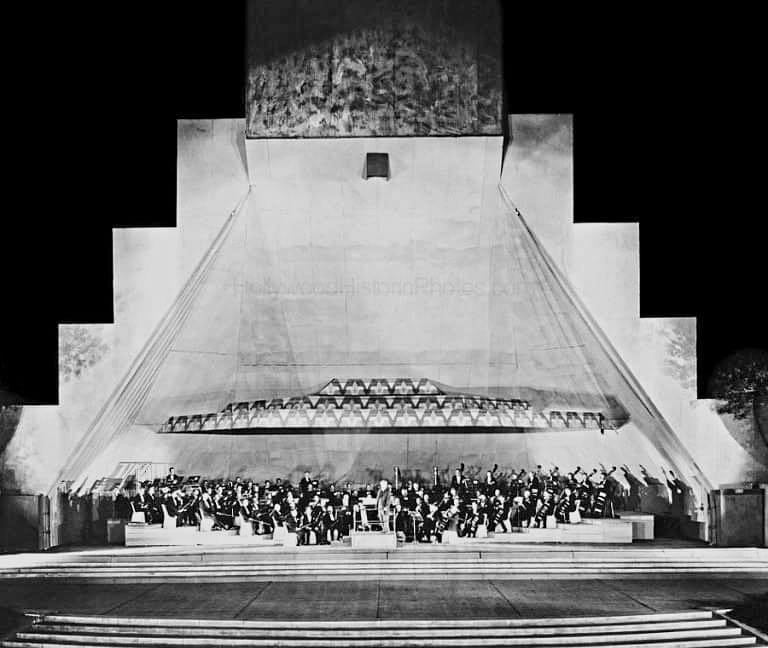 |
|
| (1927)* - Front view of Lloyd Wright's pyramidal shell which only lasted one season. It was good acoustically but people did not like the design. |
Hollywood Bowl's 3rd Shell
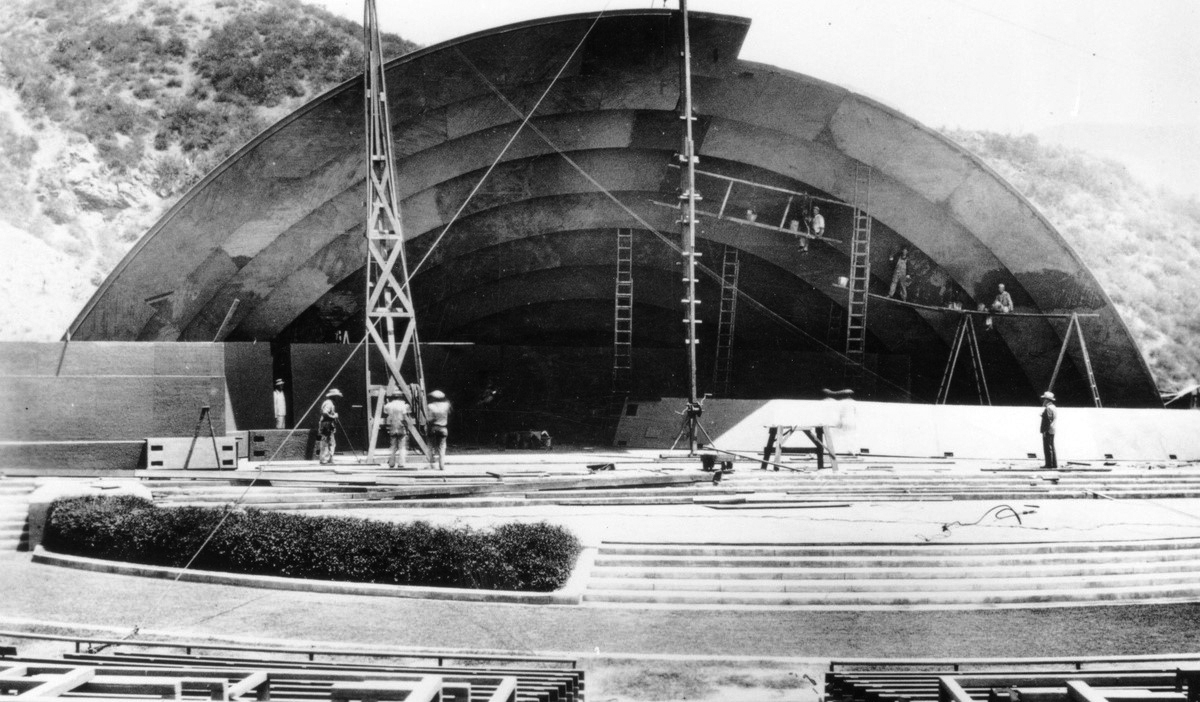 |
|
| (1928)* – View showing the construction of a new Lloyd Wright designed Bowl Shell. |
Historical Notes The Hollywood Bowl Association gave Lloyd Wright instructions to design a semi-circular shell and tackle the dual issues of acoustics and aesthetics. The shell consisted of nine concentric segmented arches, which could be "tuned" panel by panel. The shell was at the forefront of the Streamline Moderne movement and was an acoustic success. |
.jpg) |
|
| (1928)* - View of Hollywood Bowl's shell, stage, and the mountains behind it. This was the Bowl's 3rd Shell. |
Historical Notes For the 1928 season, Wright built a fiberglass shell in the shape of concentric 120-degree arches, with movable panels inside that could be used to tune the acoustics. It was designed to be easily dismantled and stored between concert seasons; apparently for political reasons this was not done, and it did not survive the winter. |
.jpg) |
|
| (1928)* - View of Hollywood Bowl's shell, stage, seating and adjacent hills with development. Built in 1928. Architect: Lloyd Wright. |
Historical Notes 1928 saw the first commercial outdoor recording of a symphony orchestra: Eugene Goosens conducting the Hollywood Bowl Orchestra (Victor Records). |
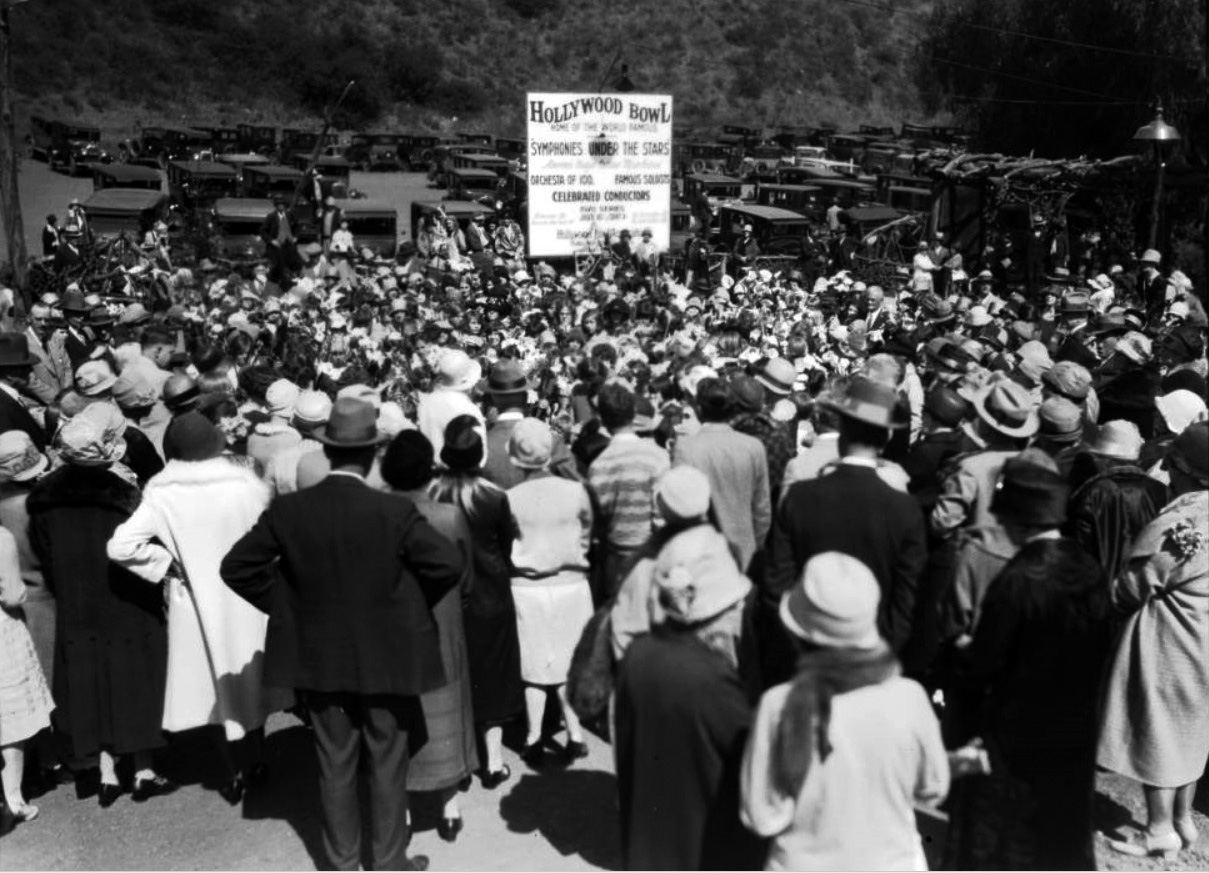 |
|
| (1928)^* – A group of adults facing an even a larger group of young ladies who appear to be holding tulips. In the background can be seen a parking lot full of cars. |
Historical Notes In the upper-center of photo is a large sign that reads: "Hollywood Bowl – Home of the World Famous 'Symphonies Under the Stars' – Orchestra of 100 – Famous Soloists – Celebrated Conductors – 1928 Series – July 10 thru Sept 1 – Admission 50 cents." |
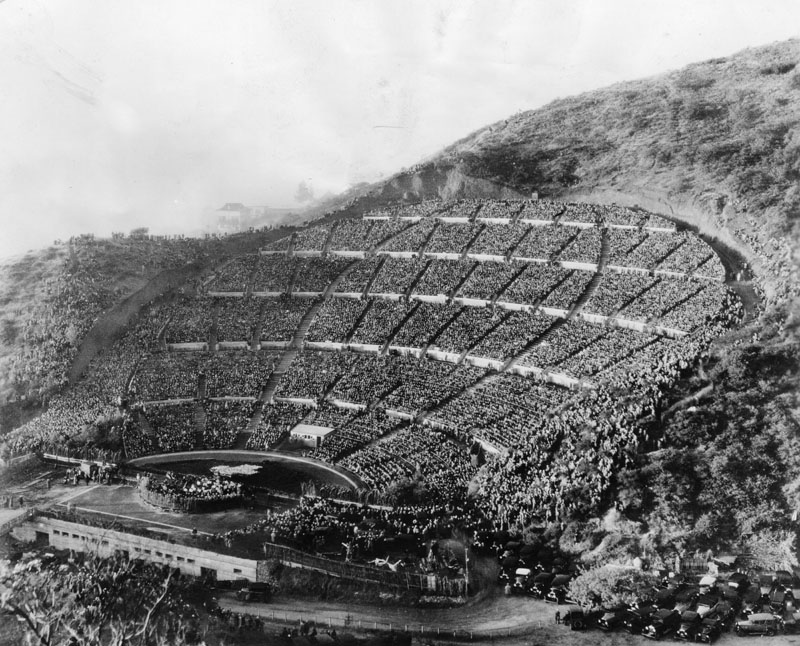 |
|
| (1928)* - Easter sunrise service in the Hollywood Bowl without the shell. |
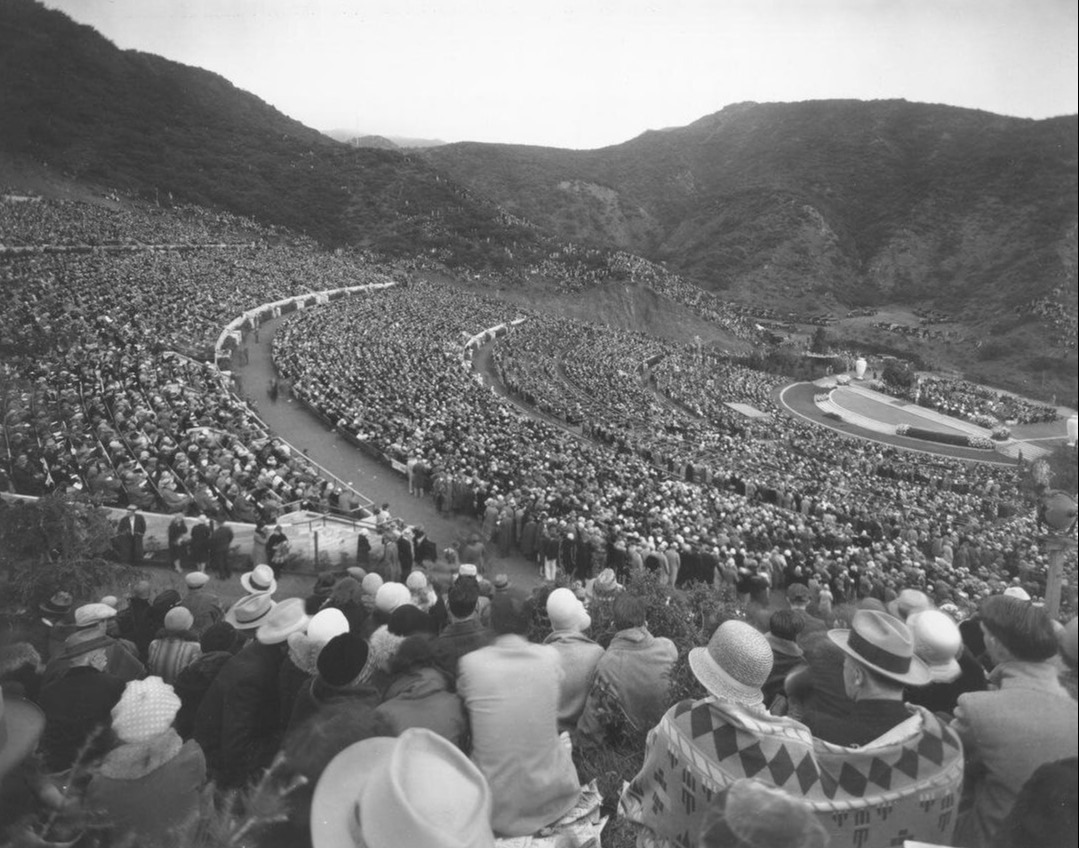 |
|
| (1929)* - The Hollywood Bowl is overflowing in this view of the 1929 Easter sunrise service. The surrounding hillside is also covered with people. |
* * * * * |
Hollywood Bowl's 4th Shell
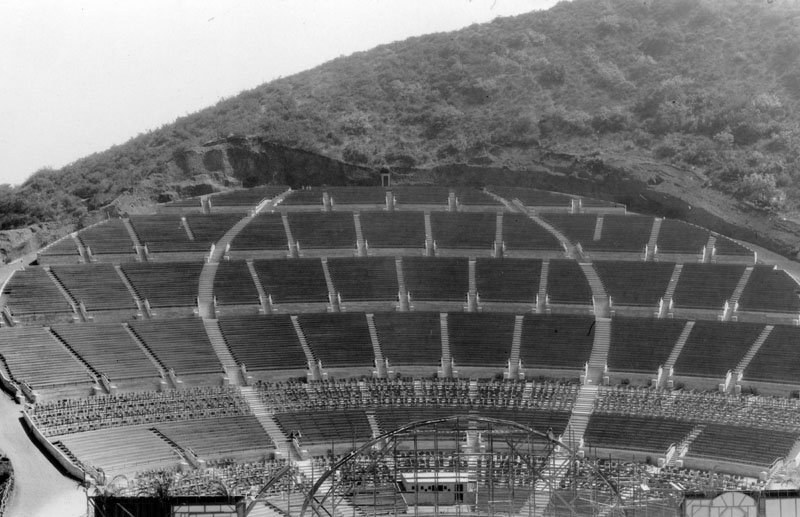 |
|
| (1929)* - Postcard view of the Hollywood Bowl during the construction of its 4th shell. |
Historical Notes For the 1929 season, Allied Architects built the shell that stood until 2003, using a transite skin over a metal frame. Its acoustics, though not nearly as good as those of the Lloyd Wright shells, were deemed satisfactory at first, and its clean lines and white, almost-semicircular arches were copied for music shells elsewhere. As the acoustics deteriorated, various measures were used to mitigate the problems, starting with an inner shell made from large cardboard tubes (of the sort used as forms for round concrete pillars) in the 1970s, which were replaced in the early 1980s by large fiberglass spheres (both designed by Frank Gehry) that remained until 2003. These dampened out the unfavorable acoustics, but required massive use of electronic amplification to reach the full audience, particularly since the background noise level had risen sharply since the 1920s. |
.jpg) |
|
| (1929)* – The steel skeletal structure for what would become Hollywood Bowl’s 4th Shell. Designed by the engineering firm of Elliot, Bowen, and Waltz and built by Allied Architects |
Historical Notes The Hollywood Bowl Shell of 1929 was a pioneering architectural design that transformed the famous Los Angeles amphitheater's acoustic and visual experience. Crafted by the Allied Architects Association, this wooden and canvas structure represented a significant upgrade from previous temporary shells, measuring 120 feet wide, 54 feet deep, and 57 feet tall. The Fourth Shell had the longest service life of any shell thus far, surviving until the end of the 2003 season. |
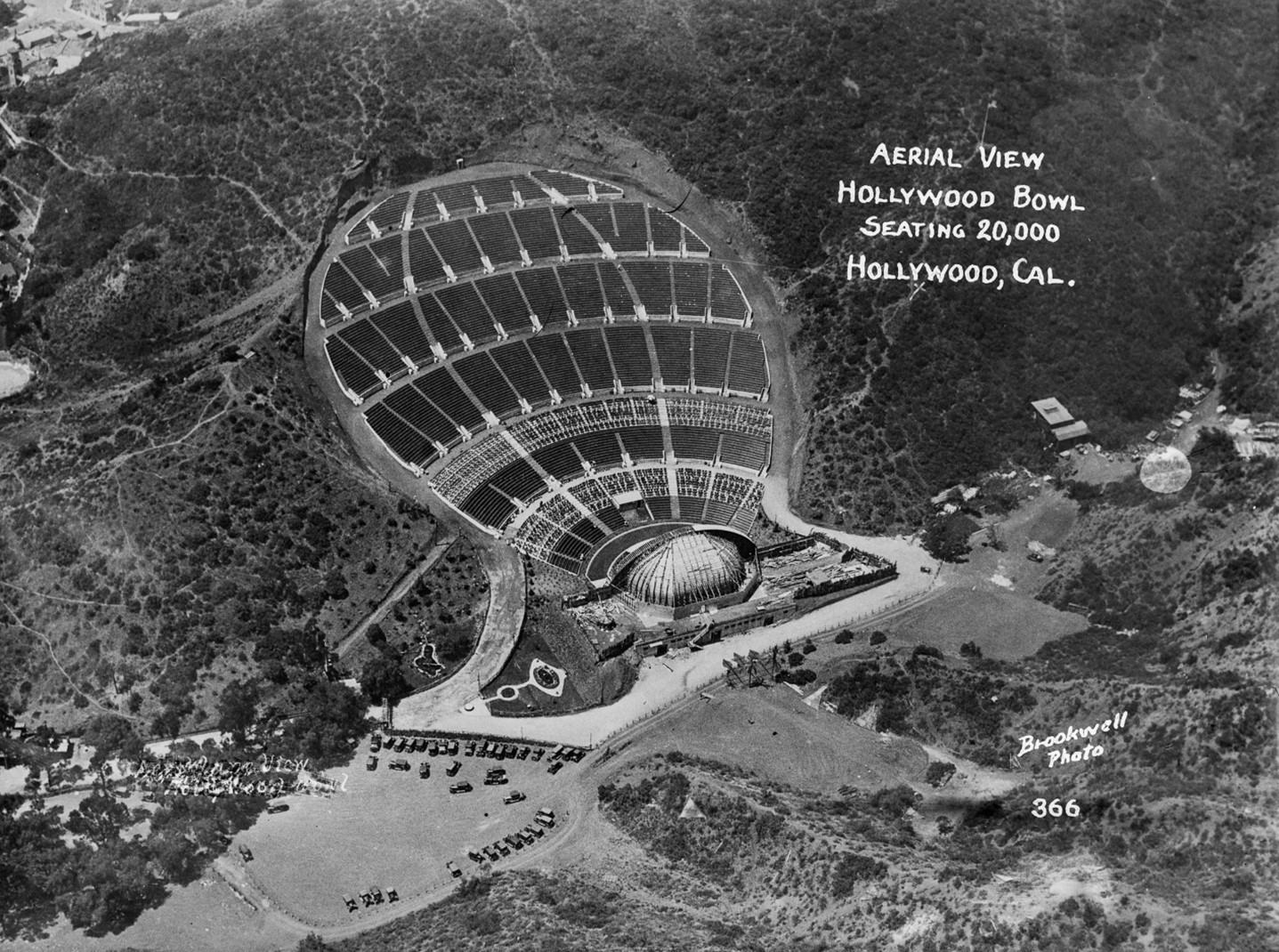 |
|
| (1929)* - Aerial view of the Hollywood Bowl amphitheater shell, seating, and parking lot, with the shell under construction. Photo from the Ernest Marquez Collection. |
Historical Notes In 1929, the Hollywood Bowl underwent a major reconstruction, highlighted by the addition of a new semi-circular shell designed by Allied Architects. This iconic structure, constructed from Transite (a blend of asbestos and concrete), cost $50,000 and, though originally intended as temporary, remained in use for 74 years until 2003. The shell, designed for portability, aimed to enhance acoustics, though some challenges persisted. The renovation also included improvements to accommodate a seating capacity of 20,000, reflecting the growing demand for performances. This transformation established the Hollywood Bowl's distinctive visual identity, recognized worldwide throughout much of the 20th century. |
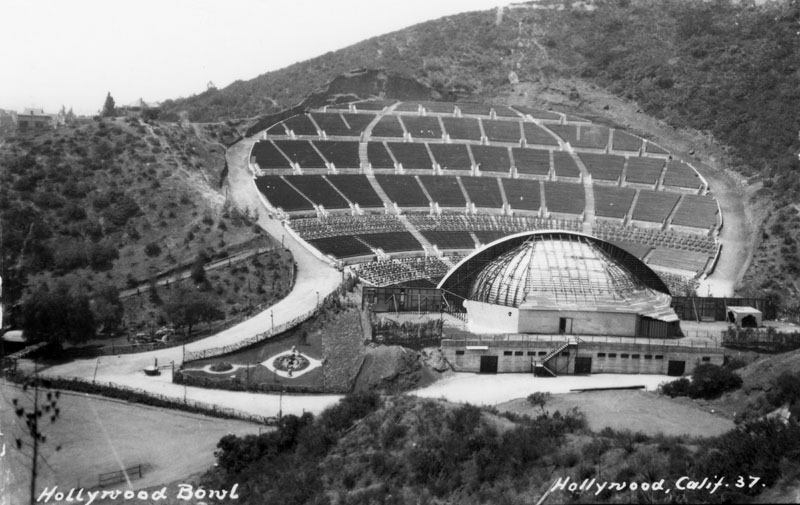 |
|
| (1929)* - View of the Hollywood Bowl as seen from behind the shell, facing the seating areas on the hillside. |
Historical Notes The appearance of the shell underwent several purely visual changes over the years, including the addition of a broad outer arch (forming a proscenium) where it had once had only a narrow rim. |
.jpg) |
|
| (1929)* – The Hollywood Bowl with its new shell under construction. Photo from the Ernest Marquez Collection. |
Historical Notes The shell's semi-circular arched design was meticulously engineered to project sound effectively across the outdoor venue, dramatically improving the audience's listening experience. Its distinctive shape quickly became an iconic symbol of the Hollywood Bowl, representing a pivotal moment in the venue's architectural and musical history. |
.jpg) |
|
| (1929)* - View is looking at the Hollywood Bowl's shell from the rear, and the seating beyond. |
Historical Notes Despite being initially conceived as a temporary structure, the 1929 shell remained in use for over seven decades. It hosted numerous memorable performances and set a new standard for outdoor performance venues. The shell's innovative design laid the groundwork for future architectural iterations, demonstrating how thoughtful acoustic engineering could enhance live musical experiences. |
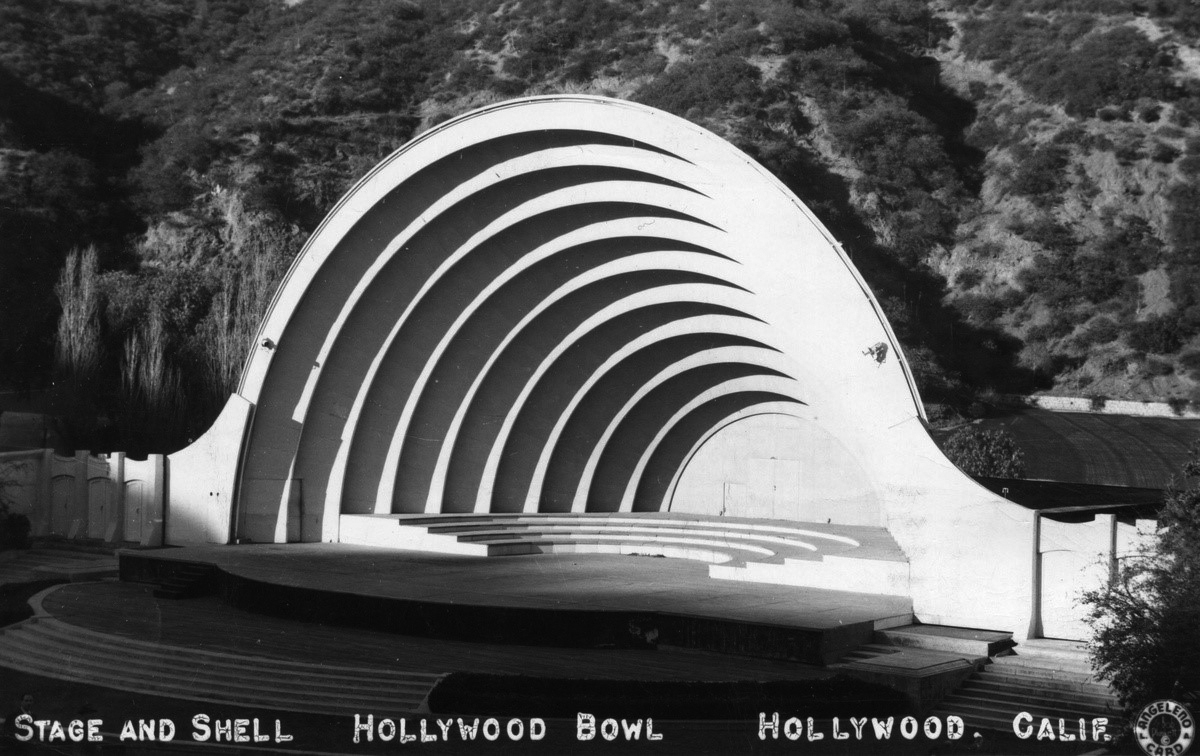 |
|
| (1929)* – Postcard view showing the newly completed Shell and Stage of the Hollywood Bowl, its 4th. |
Historical Notes Designed by the engineering firm of Elliot, Bowen, and Waltz and built by Allied Architects, this 55-ton shell became an architectural icon. The massive shell was mounted on rails which allowed it to be moved by tractors. Although this shell was ultimately replaced due to issues with acoustics and deterioration, the gracefully curved form became the signature shape of the Bowl shell. |
.jpg) |
|
| (1929)* - View of the Hollywood Bowl as seen from the top rows of bleachers. |
.jpg) |
|
| (1929)* - Close-up view of the Hollywood Bowl. An orchestra rehearses on stage under the new shell. |
Historical Notes The acoustics of the 1929 Hollywood Bowl Shell marked a significant improvement over previous designs, though they were not without challenges. Its semi-circular arched structure was engineered to project sound more effectively across the amphitheater, focusing audio towards the audience and enhancing overall audibility. The use of wood and canvas in its construction contributed to a warmer, more resonant acoustic environment. However, the shell still required additional amplification for optimal sound quality, especially for larger audiences. As an outdoor structure, its acoustics were somewhat sensitive to weather conditions, with wind and temperature changes potentially affecting sound travel and quality. Despite these limitations, the 1929 shell represented a major step forward in outdoor concert acoustics. It was part of an ongoing process of acoustic refinement at the Hollywood Bowl, with engineers and acousticians continuing to study and improve upon its design in subsequent years. |
Before and After
.jpg) |
|
| (1929) – Hollywood Bowl's fourth shell, shown before and after its completion. |
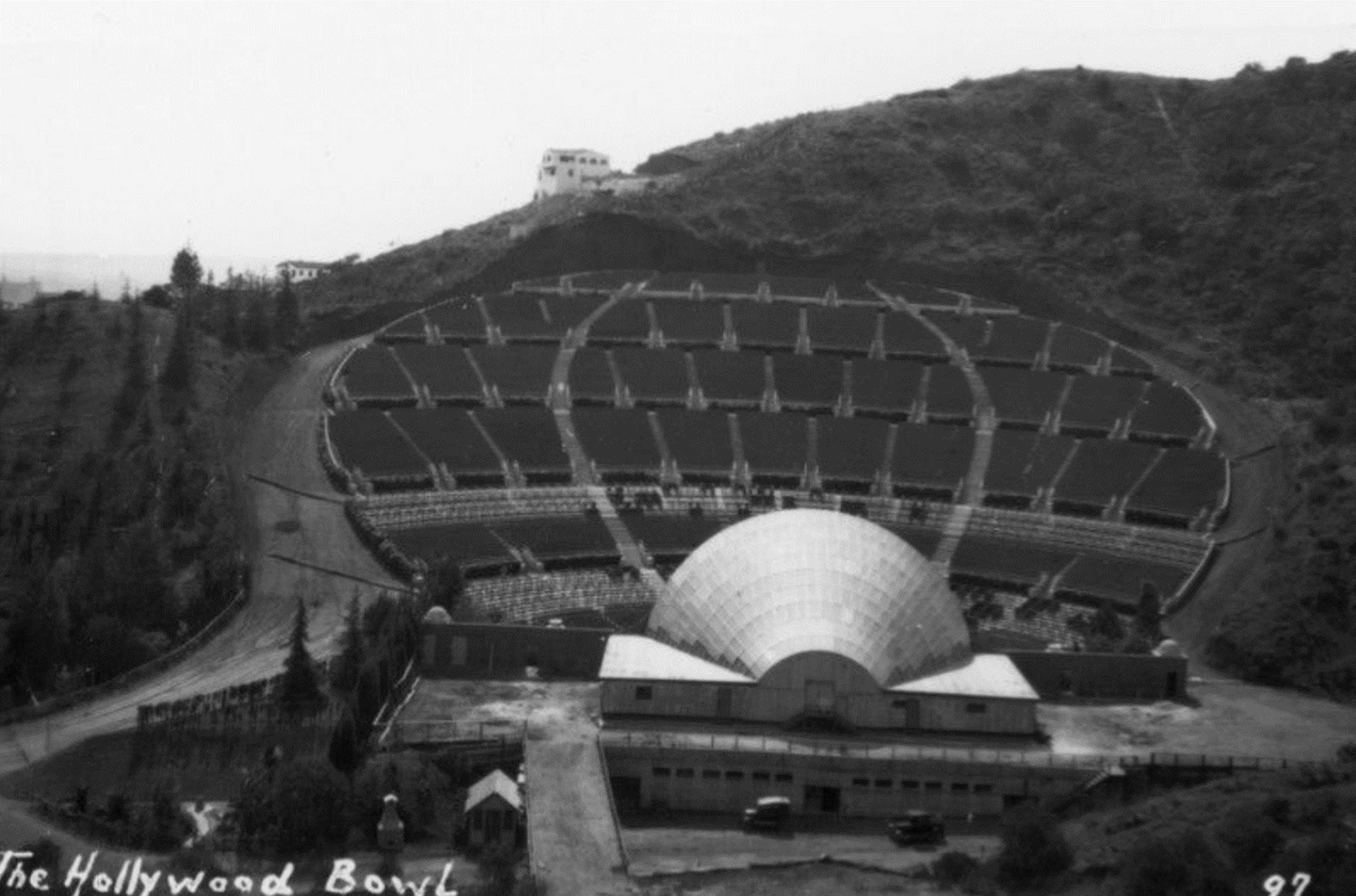 |
|
| (1929)* - The Hollywood Bowl as seen from the back of its fourth shell towards the spectator seating. Note the multi-story home on the hillside above the stands. Ernest Marquez collection. |
Historical Notes The fourth and longest-lasting shell of the Hollywood Bowl, introduced in 1929, is the most iconic and recognizable. It stood until 2004 and featured the distinctive concentric white arches that have become synonymous with the Hollywood Bowl. This design was intended to enhance the venue's natural acoustics and provide a visually striking backdrop for performances. |
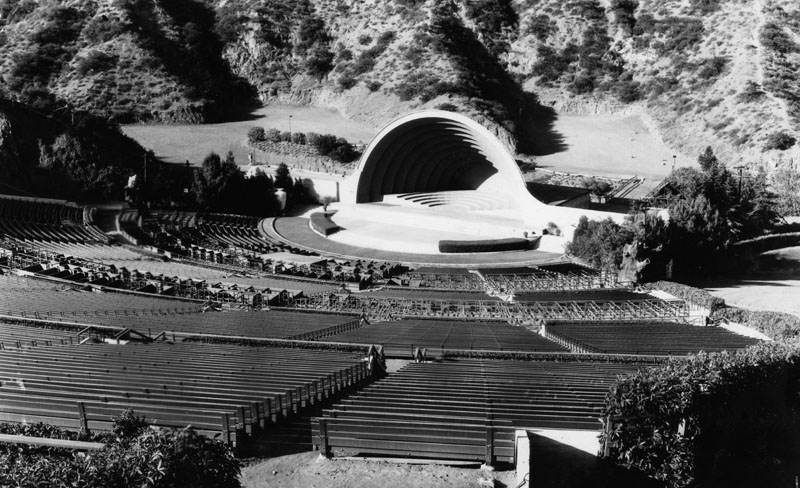 |
|
| (ca. 1930)* - View of the open-air Hollywood theatre showing the front of the slightly modified shell. |
Historical Notes In 1932,
Jascha Heifetz, considered the 20th century’s greatest violinist, made his Hollywood Bowl debut, |
Hollywood Bowl Shells (1926-1929)
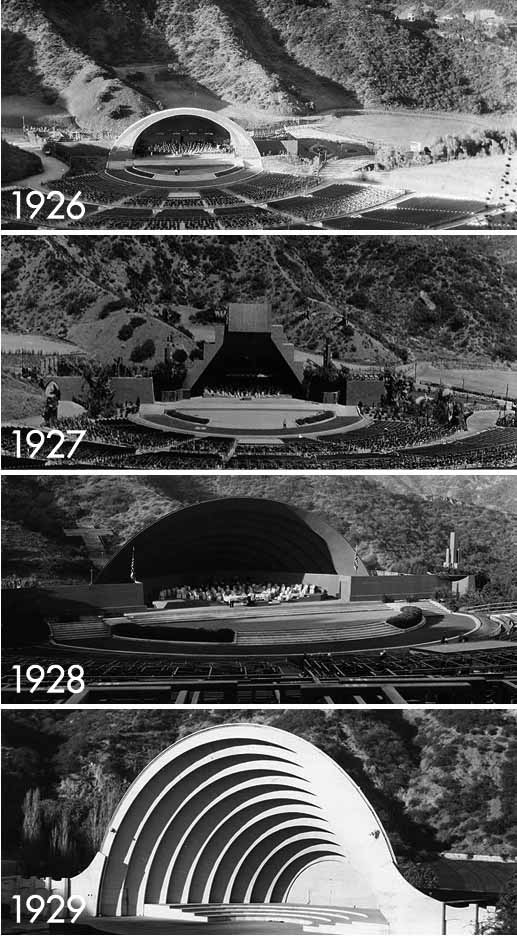 |
(1926-1929)^^* - Within a short span of 4 years, the Hollywood Bowl would see four different shell designs, all with the intent of improving the acoustics. The 1929-designed shell would last until 2003. Click HERE to see the 2004 Hollywood Bowl Shell (in use today).
|
* * * * * |
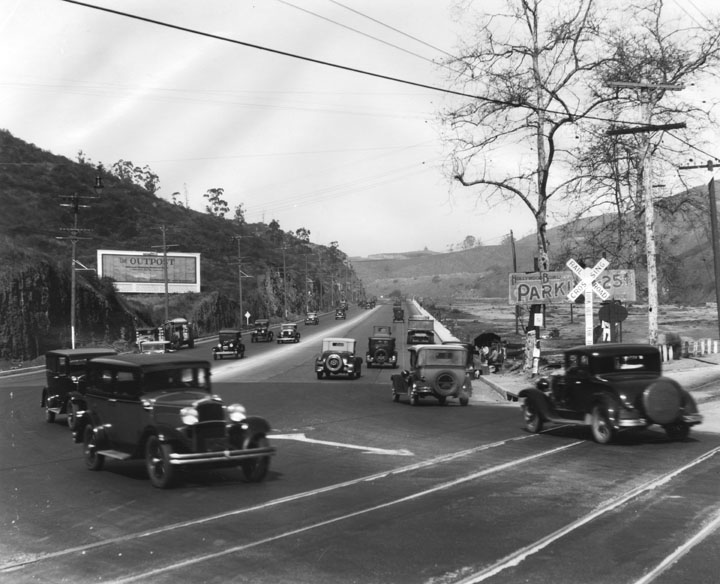 |
|
| (ca.1928)* - Cars travel in both directions through the Cahuenga Pass near the Hollywood Bowl. Note the cost of parking on the sign to to right. |
Historical Notes A new freeway adjacent to the Hollywood Bowl was to built a dozen years later. The Hollywood Freeway would be built in stages. The first segment built was a one and a half mile stretch through the Cahuenga Pass. That segment opened on June 15, 1940. It was then known as the "Cahuenga Pass Freeway." The next section of the freeway that stretched from the San Fernando Valley to Downtown Los Angeles opened on April 16, 1954. The final section, north of the Ventura Freeway to the Golden State Freeway was completed in 1968. Pacific Electric Railway trolleys ran down the center of this freeway until 1952. |
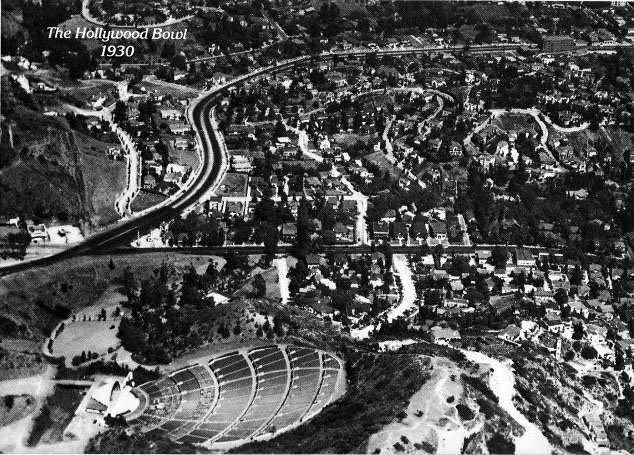 |
|
| (1930)^#^ - Aerial view of the Hollywood Bowl looking east. The neighborhood of Whitley Heights is at the center of photo. |
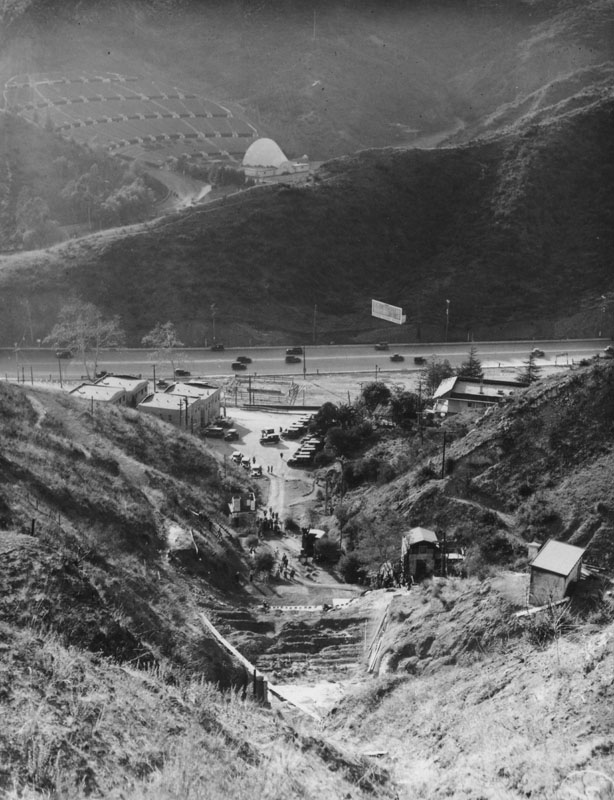 |
|
| (1931)* - Looking down into the site of the future Pilgrimage Play Theatre, revealing the Cahuenga Pass and the Hollywood Bowl in the background. The new structure will resemble the architecture of the Holy Land for the purposes of the play performed there. The previous amphitheater on the site was built in 1920, but a brush fire in October 1929 destroyed that wooden structure. |
Historical Notes In 1976, the Pilgrimage Theatre was renamed the John Anson Ford Theatre in honor of the late L.A. County Supervisor's significant support of the arts. John Anson Ford (1883–1983) helped found the L.A. County Arts Commission, encouraged the Board of Supervisors to support the building of the Music Center and led the County's acquisition of Descanso Gardens, among many other achievements. |
 |
|
| (1931)* - A banner advertising a Hollywood Bowl summer concert with conductor Alfred Hertz stretches over Broadway packed with pedestrians, streetcars and traffic. |
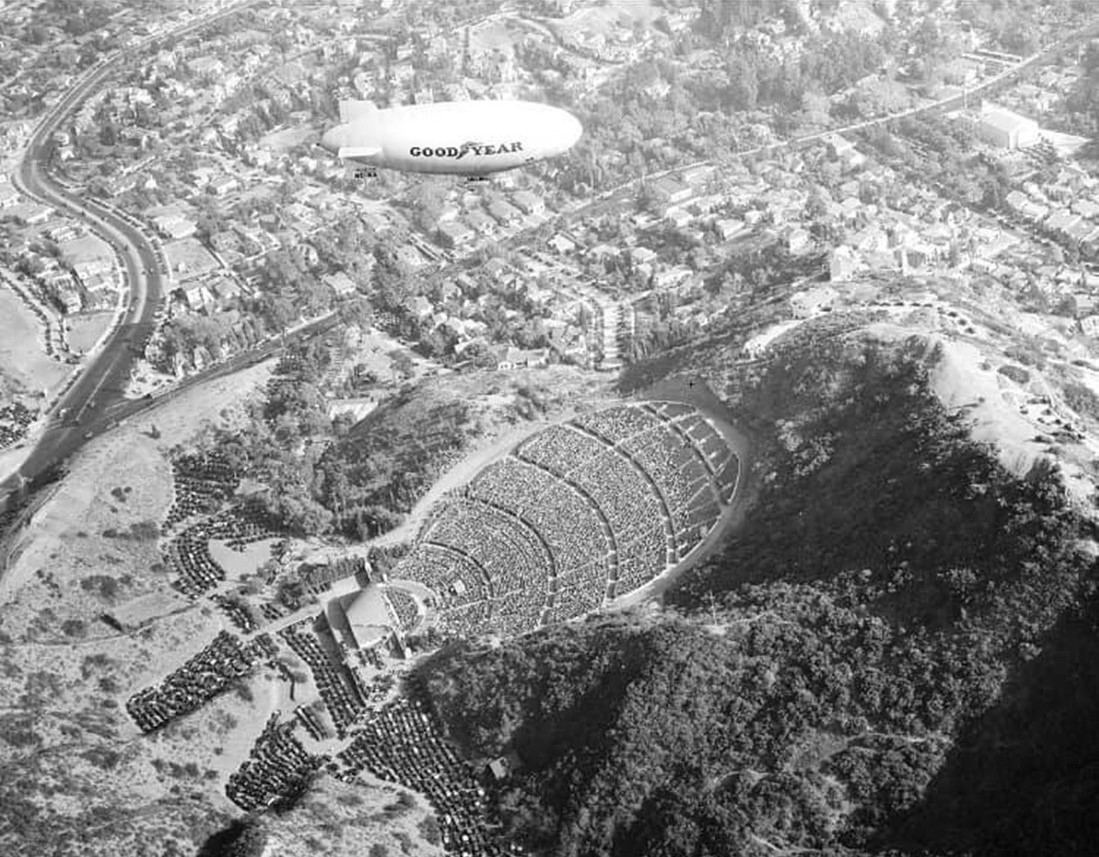 |
|
| (1932)* - Goodyear blimp flying over the Hollywood Bowl, September 24, 1932. |
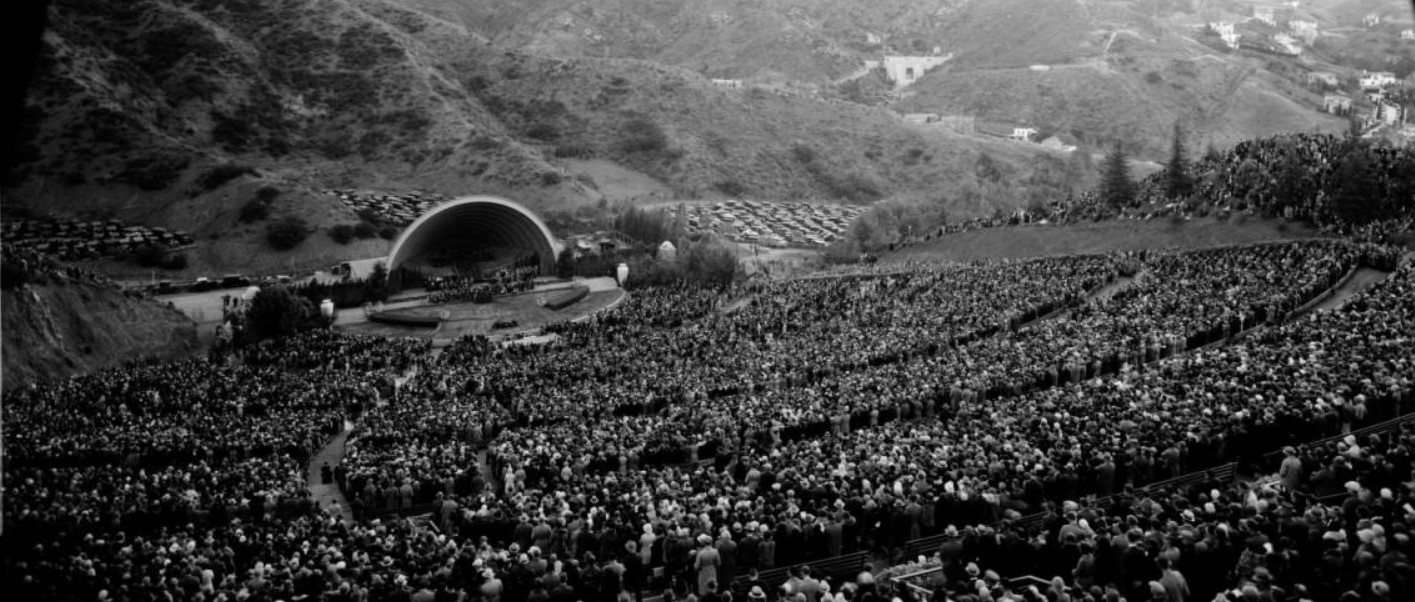 |
|
| (1932)^^# - Panoramic view of the Hollywood Bowl filled to capacity during Easter Services. The audience faces the stage where the service is being conducted, from both their seats in the bowl and on the surrounding hills. The very full parking lots are visible in the background. |
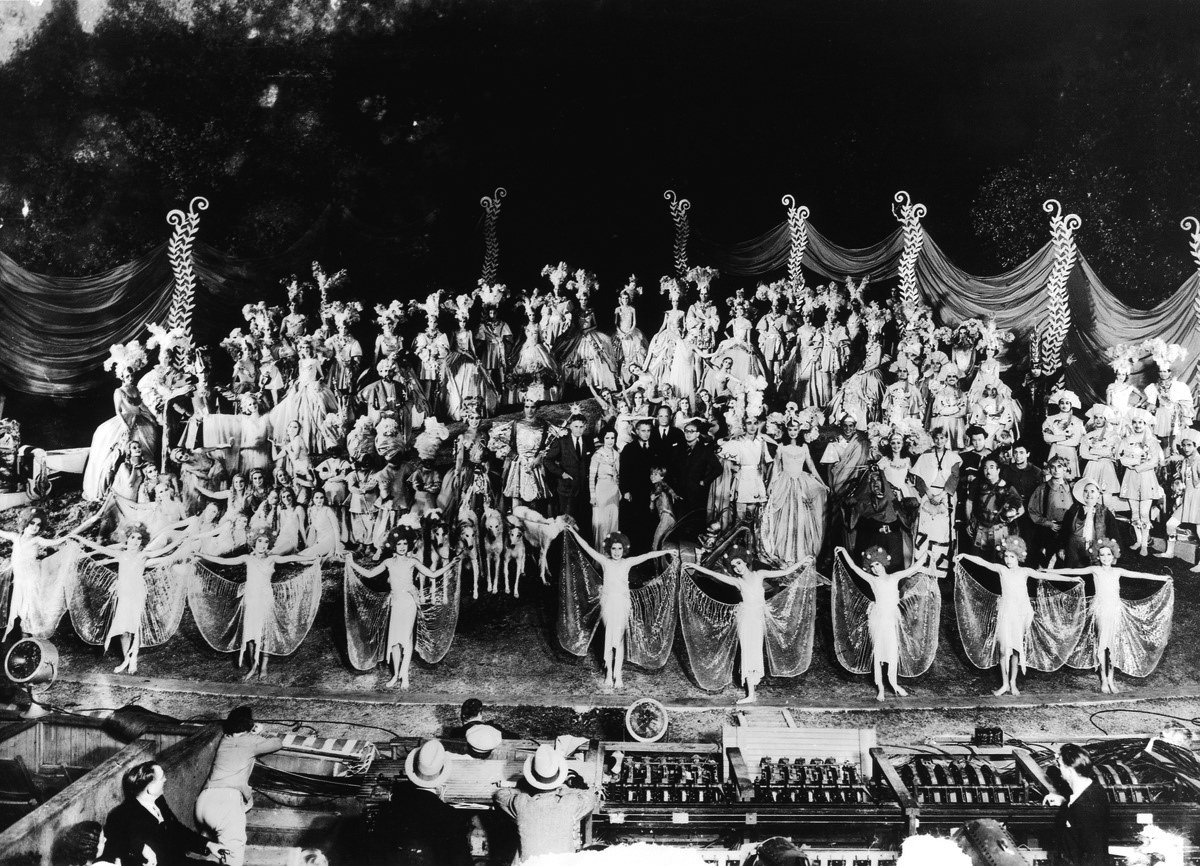 |
|
| (1934)* - German director Max Reinhardt directs a production of A Midsummer Night's Dream. The Hollywood Bowl's shell is moved, and tons of earth is hauled in to construct a hill for the forest setting. |
Historical Notes In 1934, legendary European producer/director Max Reinhardt's lavish production of Shakespeare's A Midsummer Night's Dream drew 200,000 people over its 10 performances at the Bowl. The huge cast featured Mickey Rooney as Puck, Olivia de Havilland as Hermia, and Walter Connelly as Bottom. |
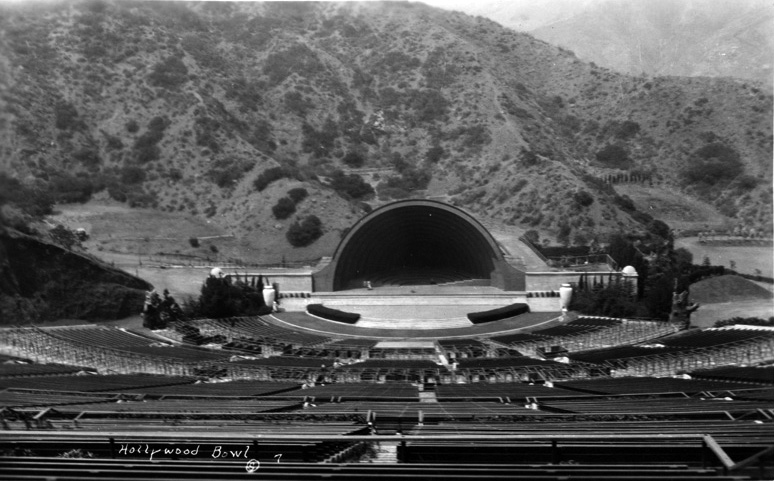 |
|
| (ca. 1936)* - View of an empty Hollywood Bowl. |
Historical Notes In 1934, Alfred Hertz conducted his 100th concert at the Hollywood Bowl. In 1936, the attendance record of 26,410 for a single concert was set by French soprano Lily Pons. The Bowl's seating capacity was 20,000 at that time. |
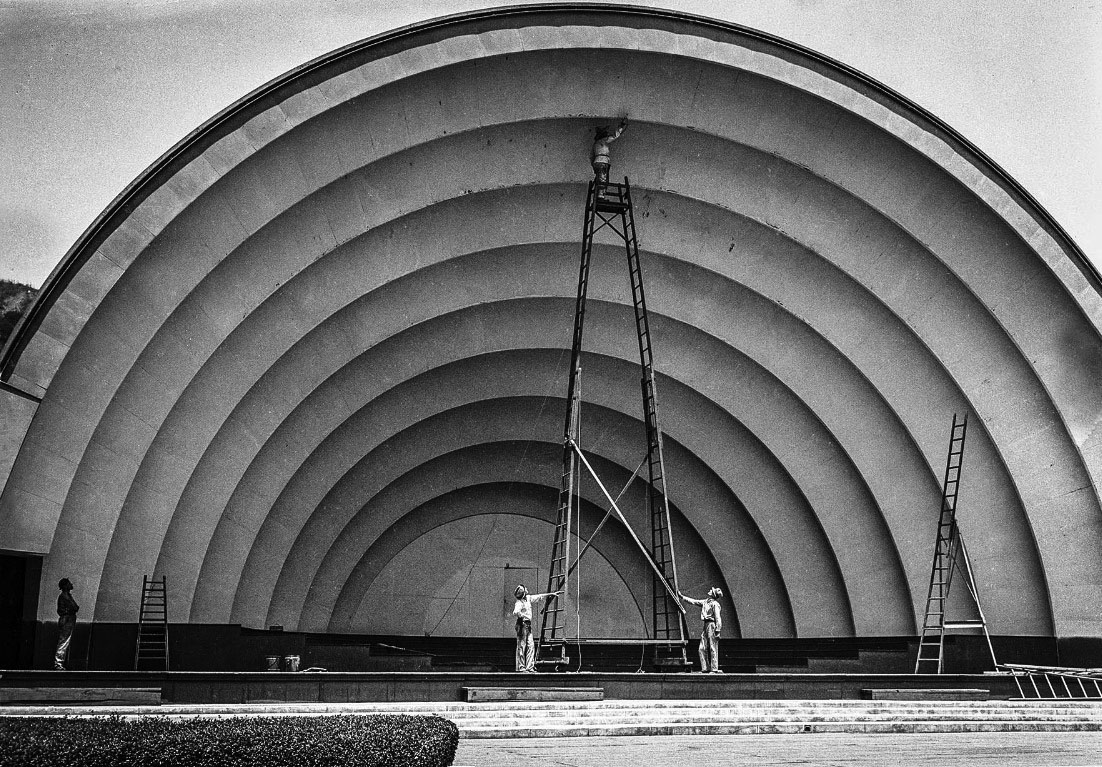 |
|
| (1935)#^^ - The Hollywood Bowl shell gets a new coat of paint for the first time in three years. Martin Sipma uses a spray gun as workmen steady his ladder. LA Times - July 6, 1935 |
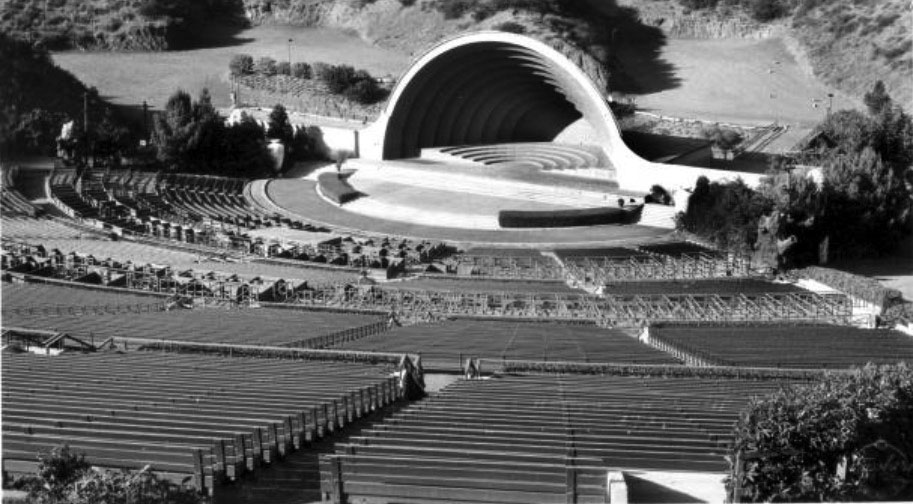 |
|
| (1936)* - Postcard view showing the Hollywood Bowl with empty seats and empty parking lot. |
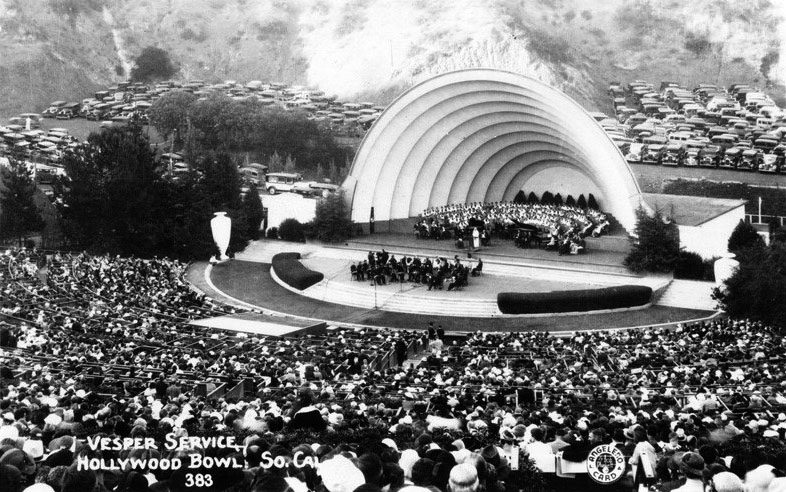 |
|
| (ca. 1936)* – Postcard view of Vesper Service at the Hollywood Bowl. Note the full parking lot in the background. |
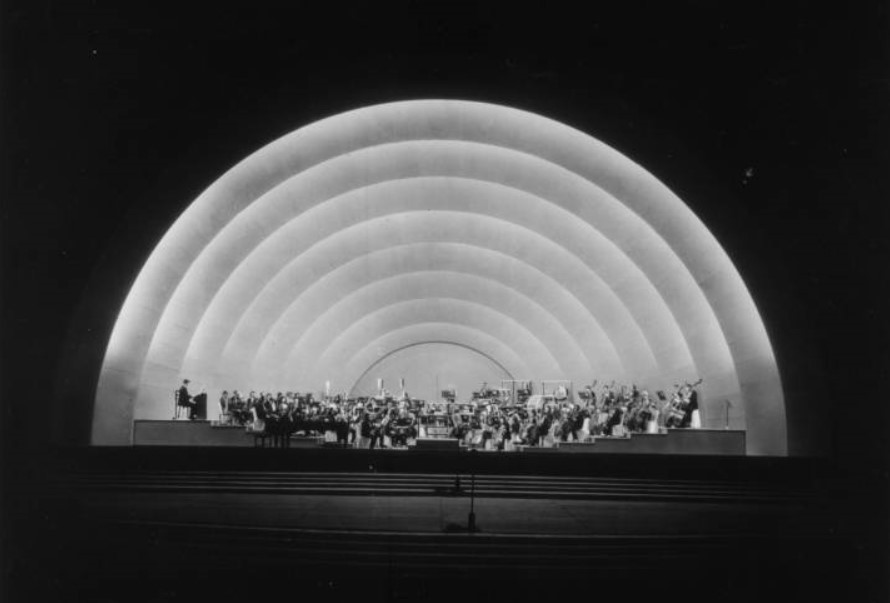 |
|
| (1936)* - - Looking toward the orchestra during a nighttime concert at the Hollywood Bowl. |
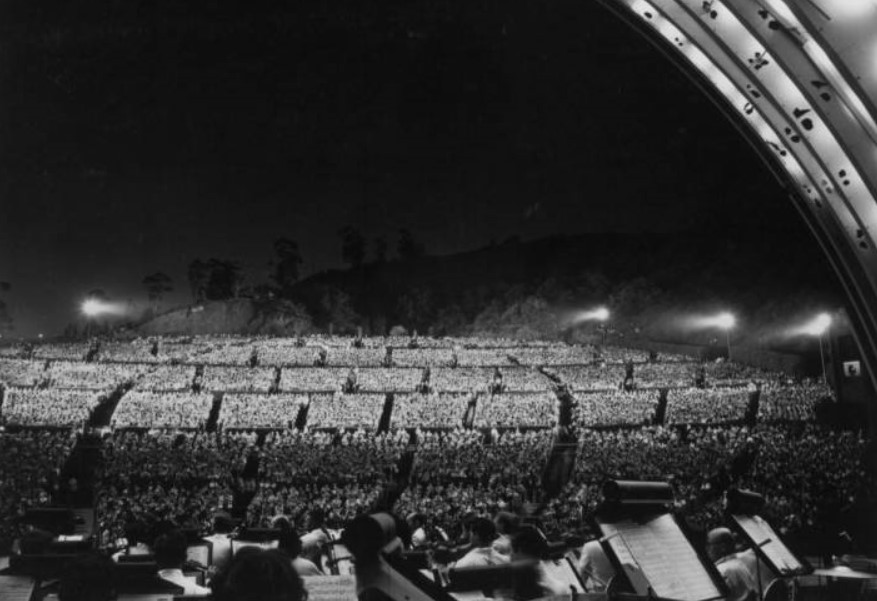 |
|
| (1936)* - Looking over the orchestra toward the audience during the Symphony Under the Stars. Photo by "Dick" Whittington. |
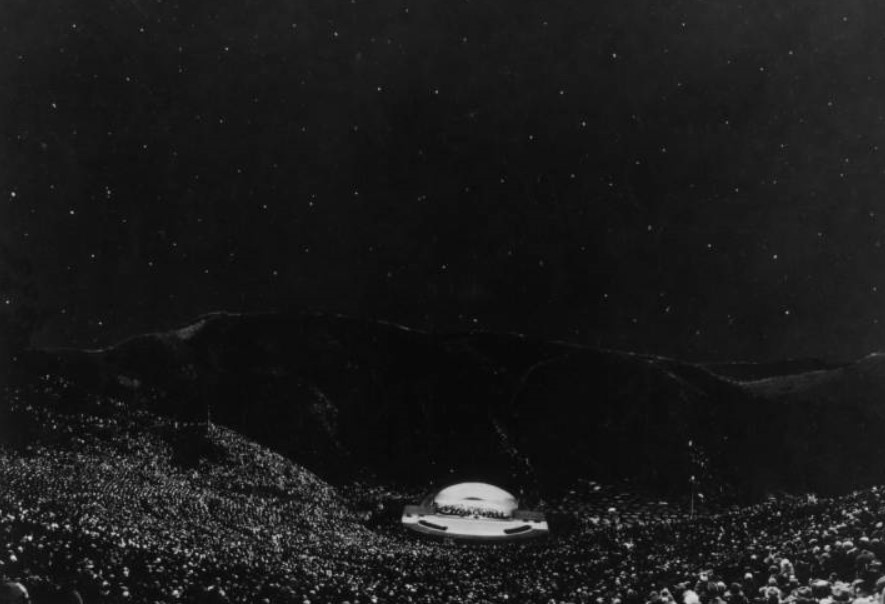 |
|
| (1936)* - A huge crowd gathers at the Hollywood Bowl for a Symphony Under the Stars. |
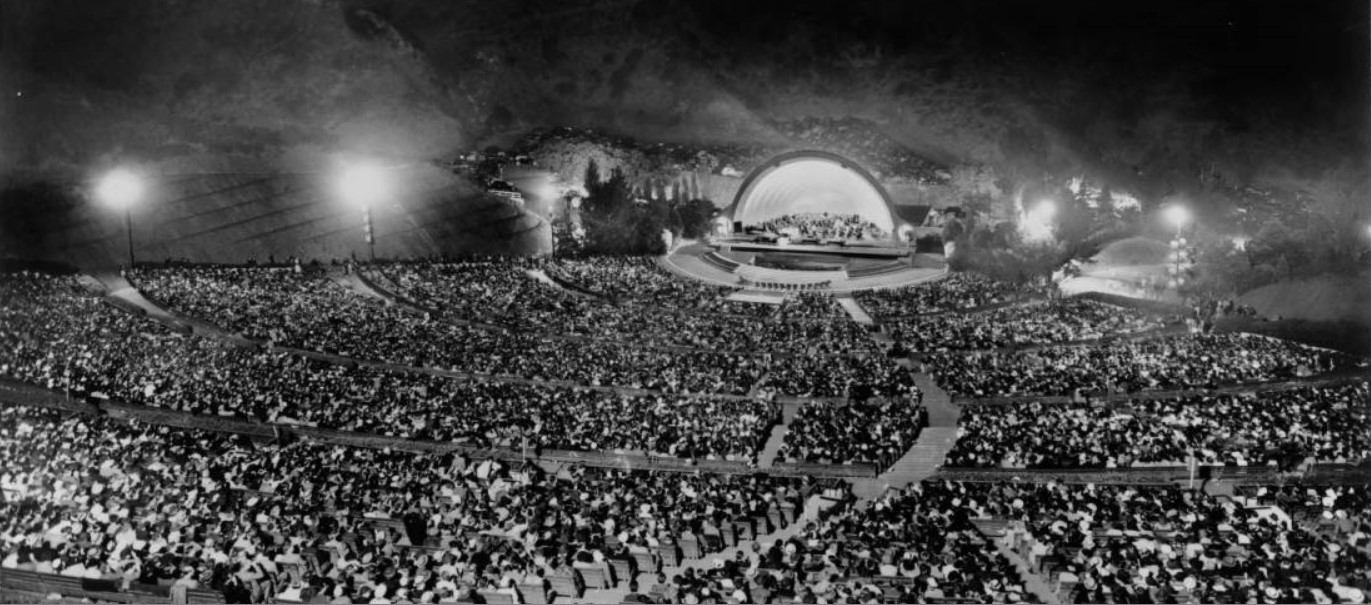 |
|
| (1937)^^# - Panoramic view from the back of the Hollywood Bowl, facing the stage, of the George Gershwin memorial concert, which took place two months after the composer's death. The stage is filled by a full orchestra and multiple pianos. A view from the back of the Hollywood Bowl, located at 2301 North Highland in Los Angeles, facing the stage, of the George Gershwin memorial concert, which took place two months after the composer's death. The stage is filled by a full orchestra and multiple pianos. Photo date: September 8, 1937. |
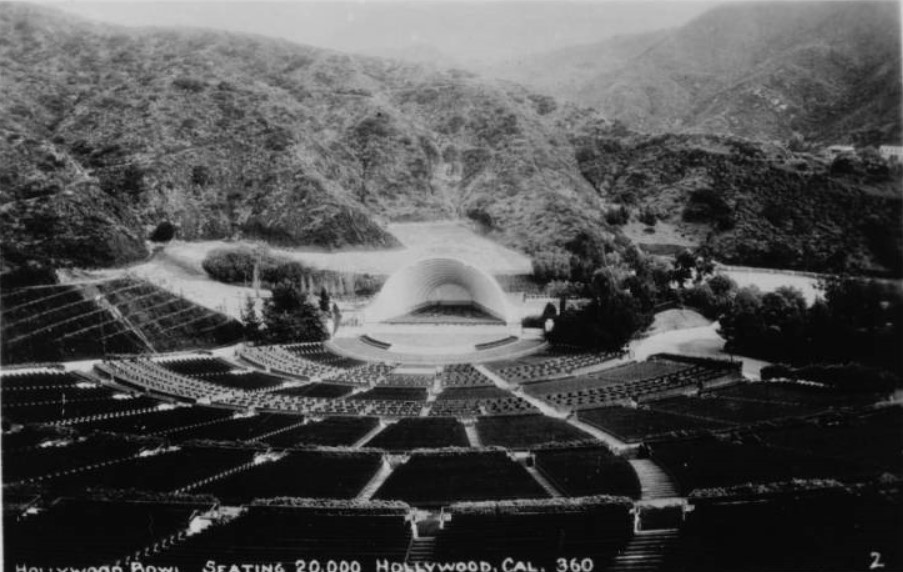 |
|
| (1938)* - Postcard view showing an empty Hollywood Bowl, “Seating Capacity: 20,000” |
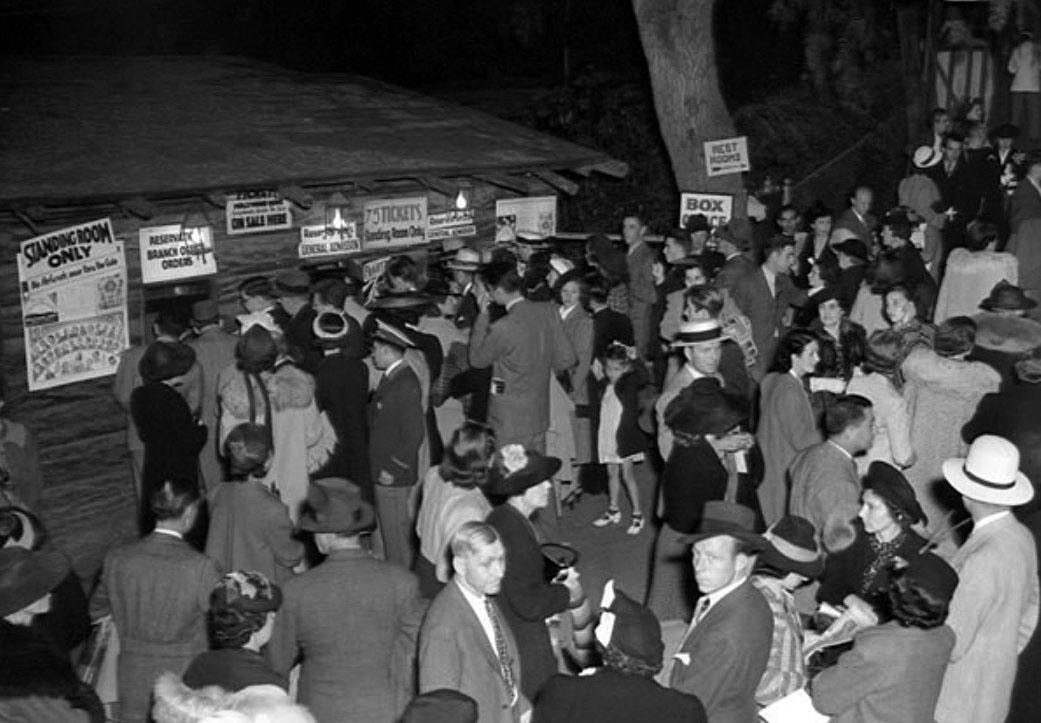 |
|
| (1938)* – View showing the Hollywood Bowl box office. |
 |
|
| (1938)* - The bowl shell has been removed for this performance of Butterfly (Puccini) at the Hollywood Bowl,. |
Historical Notes Madame Butterfly was performed for a sold out crowd of 22,000 on August 9, 1938. The stage set contained a building designed to look like a traditional paper and wood Japanese house (left) and an arched bridge leading off stage (center). This performance stressed authenticity as can be seen by the decorations on the Shoji screens. |
 |
|
| (1938)* - Arriving for Madame Butterfly at the Hollywood Bowl. |
Historical Notes Carla Peroni conducted the opera, Hizi Koyke stared as Cho Cho San to rave reviews, and Mario Chamlee played Pinkerton. A sign on the stage reads "Please keep quiet" and the orchestra pit is empty, but people are starting to fill the boxes. |
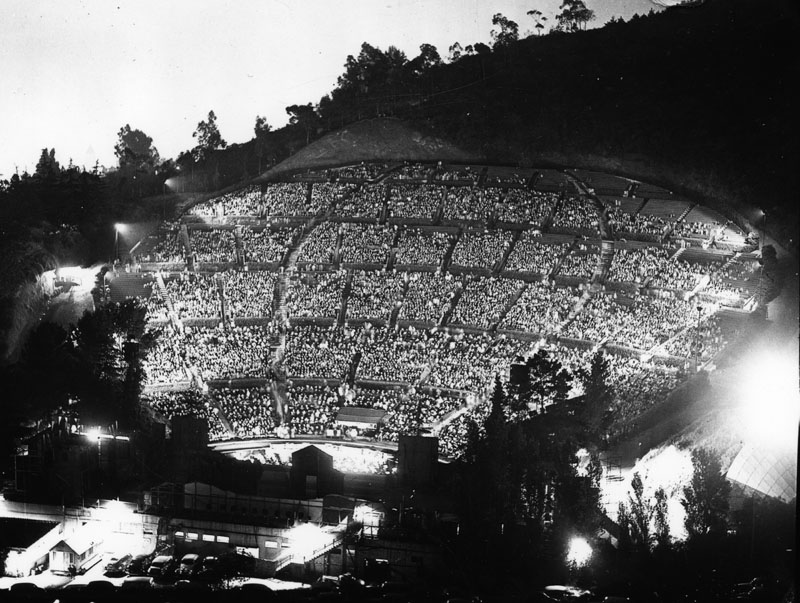 |
|
| (ca. 1940)* - Evening view of the Hollywood Bowl hillside seating area, without the shell. |
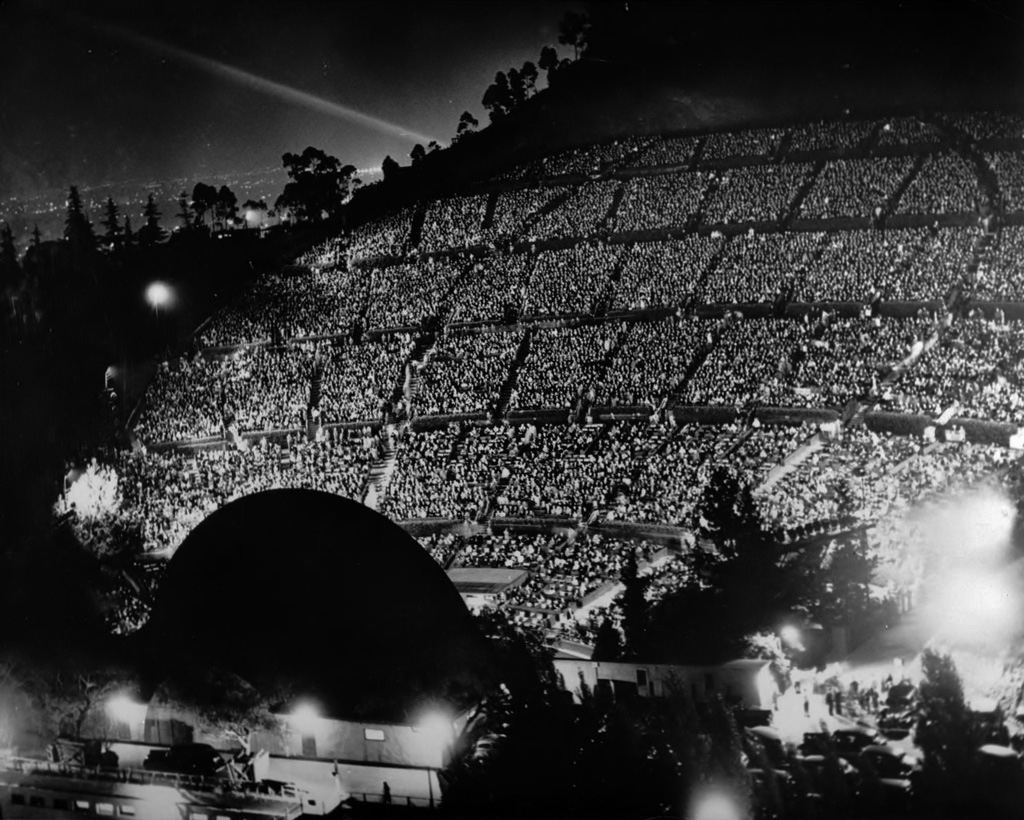 |
|
| (1940)* - Panoramic view of the Hollywood Bowl at night, showing spectators. |
* * * * * |
Hollywood Bowl Entrance
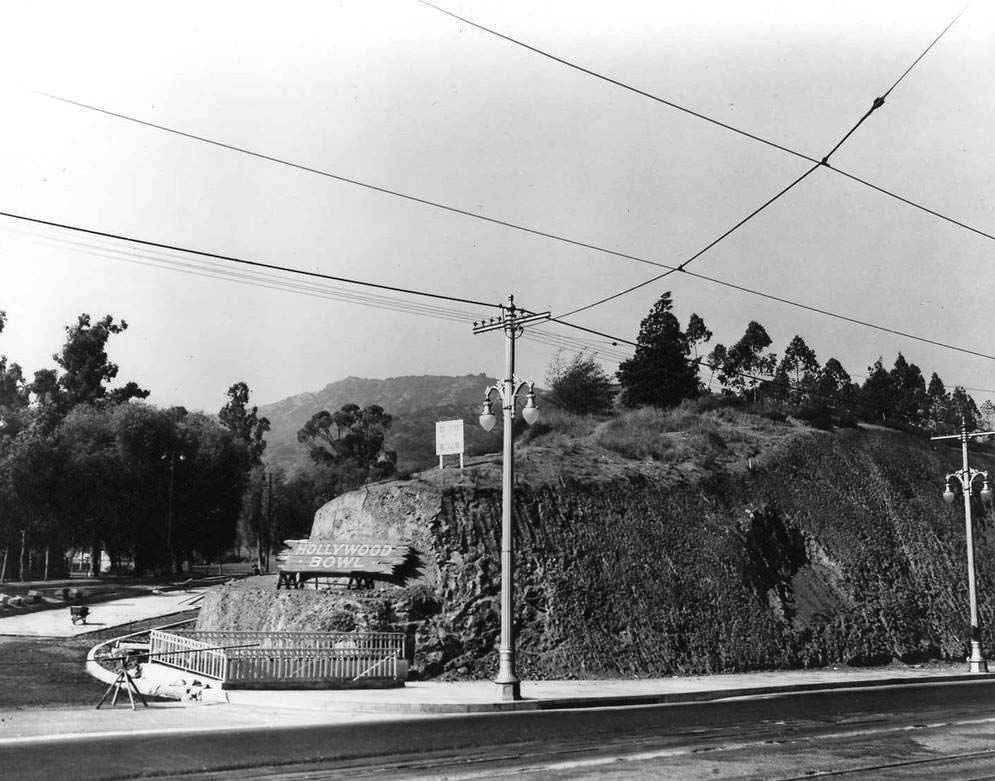 |
|
| (ca. 1930s)* –Looking toward the entrance to the Hollywood Bowl where a large wooden sign on a dirt embankment reads 'Hollywood Bowl.' Today, the Muse of Music statue, created by sculptor George Stanley in 1940, stands in the same location. Stanley is also known for designing the Oscar statuette for the Academy Awards in 1928, which is still in use today. |
Before and After
 |
|
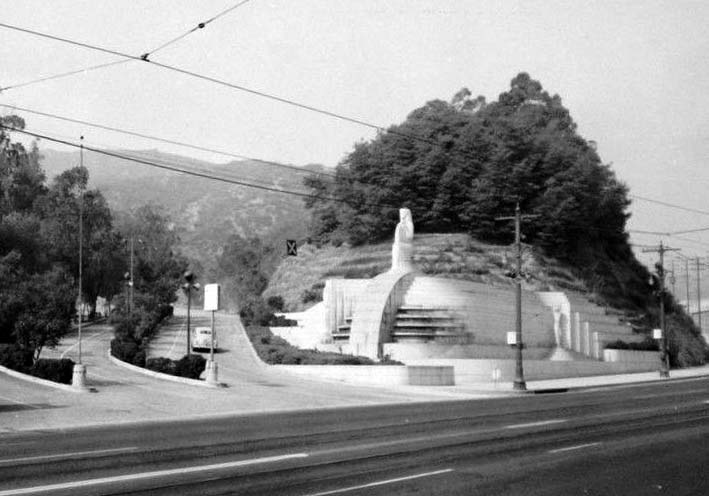 |
|
| (1930s vs 1940)* - Before and After the installation of the Muse of Music fountain at the entrance to the Hollywood Bowl. |
Historical Notes In 1940, the Hollywood Bowl entrance was enhanced with the addition of the Muse of Music fountain, a 15-foot-high granite structure designed by sculptor George Stanley, who was also famous for creating the Oscar statuette3. This iconic fountain features three figures representing the Muses of Music, Dance, and Drama, each depicted with symbolic attributes such as a lyre, dynamic movement, and theater masks4. The construction of this monumental piece required 300 tons of granite quarried near Victorville and 1,180 tons of concrete. |
Contemporary View
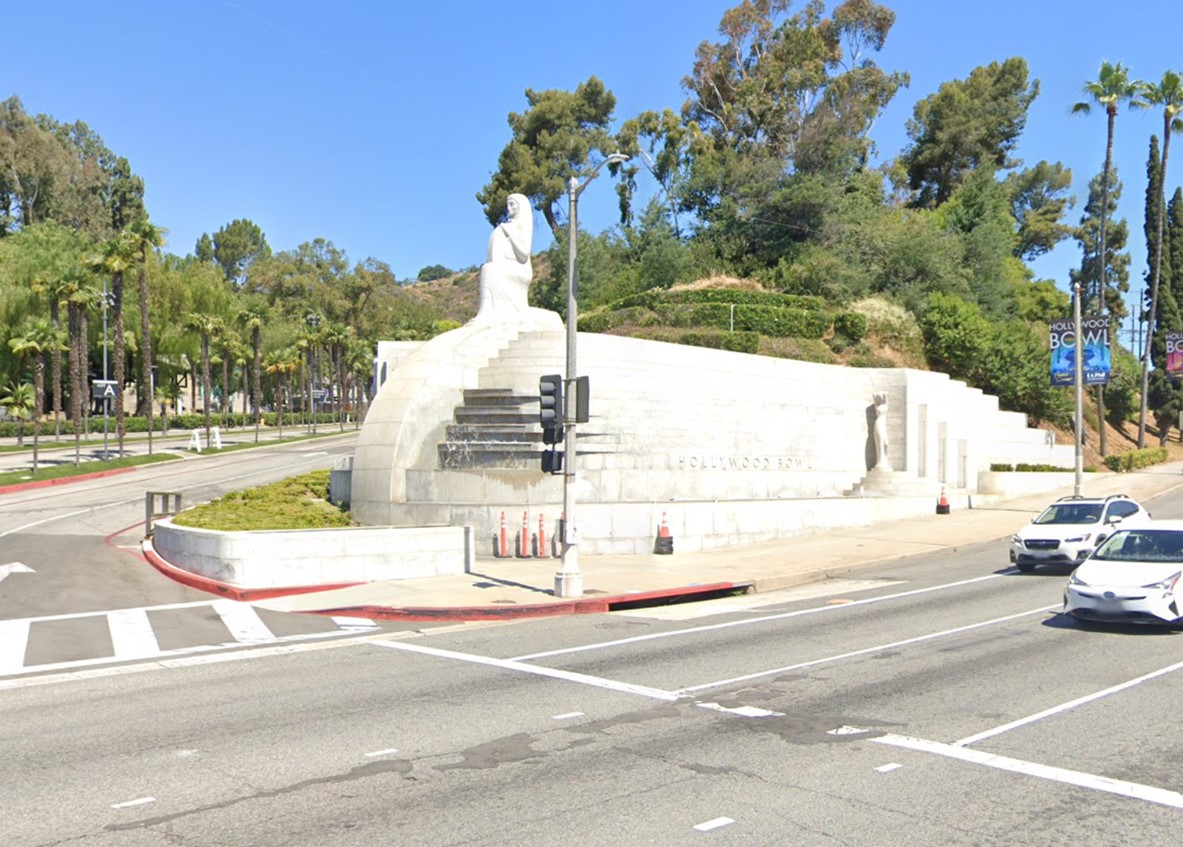 |
|
| (2024)* - Contemporary view of the entrance to the Hollywood Bowl showing the Muse of Music Sculpture. |
Historical Notes The Muse of Music fountain and sculpture became a defining feature of the Hollywood Bowl's entrance, symbolizing the venue's dedication to the performing arts. |
Then and Now
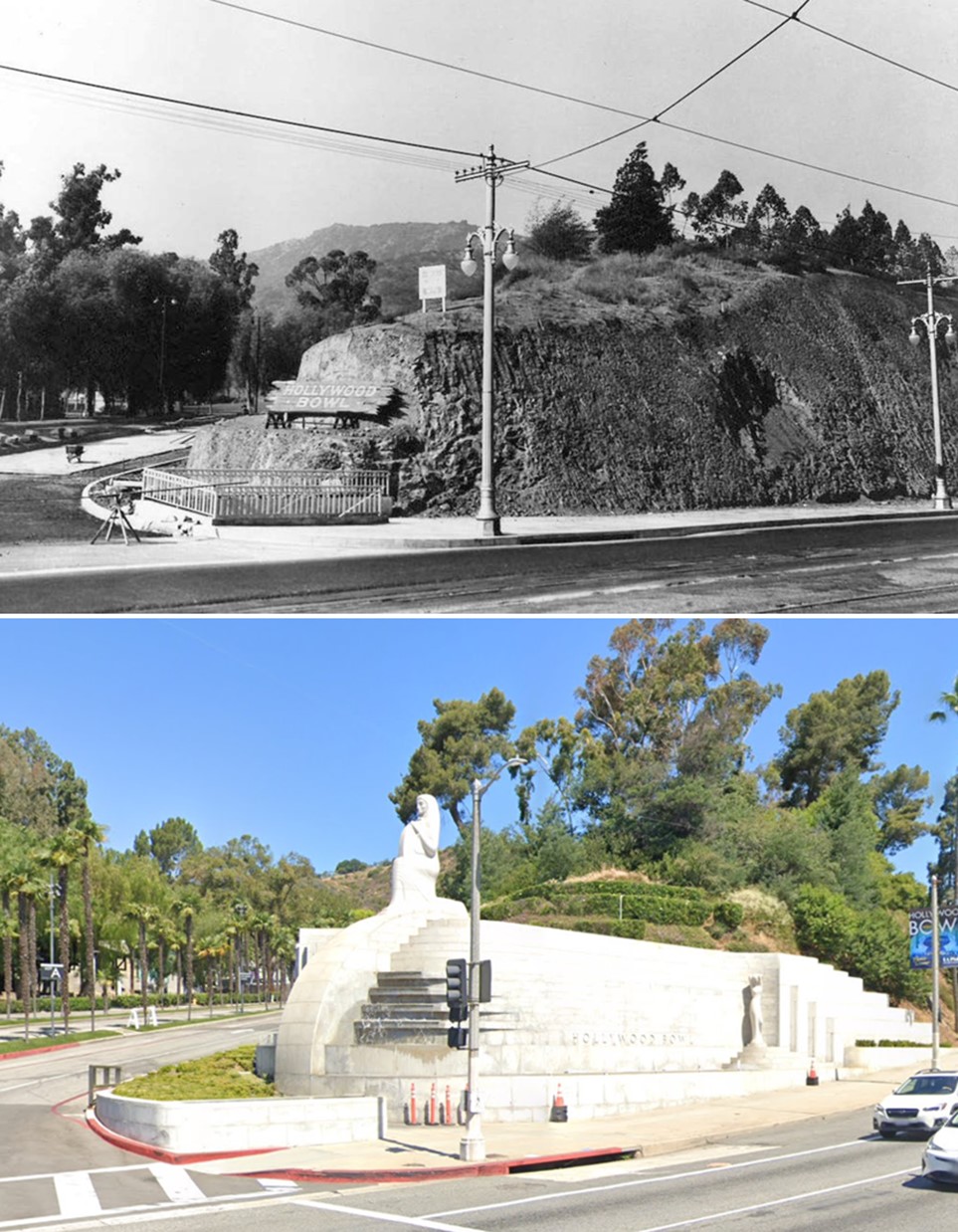 |
|
| (1930s vs 2024)* – Looking toward the entrance to the Hollywood Bowl in the 1930s, a large wooden sign on a dirt embankment reads 'Hollywood Bowl.' Today, the Muse of Music statue, created by sculptor George Stanley in 1940, stands in the same location. Stanley is also known for designing the Oscar statuette for the Academy Awards in 1928, which is still in use today. Photo comparison by Jack Feldman. |
Muse of Music Sculpture
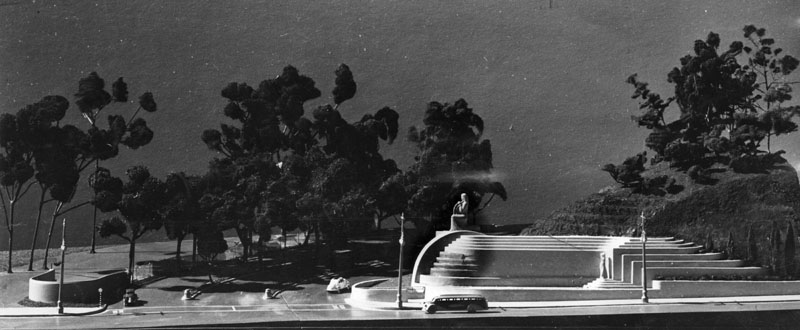 |
|
| (1939* - Caption reads, "This model shows the setting for the statue at the entrance to the Bowl. The work is progressing as part of the W.P.A. Federal Art Project." |
Historical Notes The Muse of Music statue, officially titled "Muse of Music, Dance, Drama," is a prominent landmark at the entrance of the Hollywood Bowl. Sculpted by George Maitland Stanley in 1940 as part of a Works Progress Administration (WPA) project, the fountain-style sculpture embodies the Streamline Moderne style and is carved from granite. It stands 22 feet tall and features three figures: the Muse of Music playing a lyre, the Muse of Dance in motion, and the Muse of Drama holding theater masks. Initiated by Charles Toberman, president of the Hollywood Bowl Association, the project received financial support from Los Angeles County and the WPA, which provided labor and materials funding. The statue was dedicated on July 8, 1940, before the opening of the Bowl’s 19th season, and quickly became a symbol of the venue, frequently featured in posters and postcards. Over time, the statue experienced wear due to pollution and bird droppings, leading to a significant restoration effort in 2006 by the Los Angeles Philharmonic and the Hollywood Bowl. This restoration preserved Stanley's original design while incorporating modern updates. The Muse of Music continues to serve as an entrance landmark and is the inspiration behind the Hollywood Bowl's Design Guidelines, established in 2004, which guide the venue's future development in alignment with the aesthetic of Stanley’s work. |
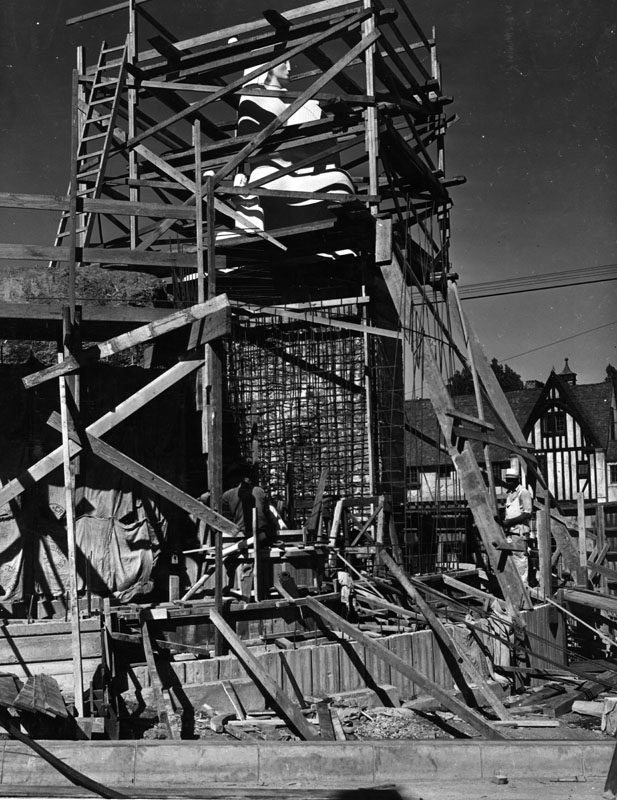 |
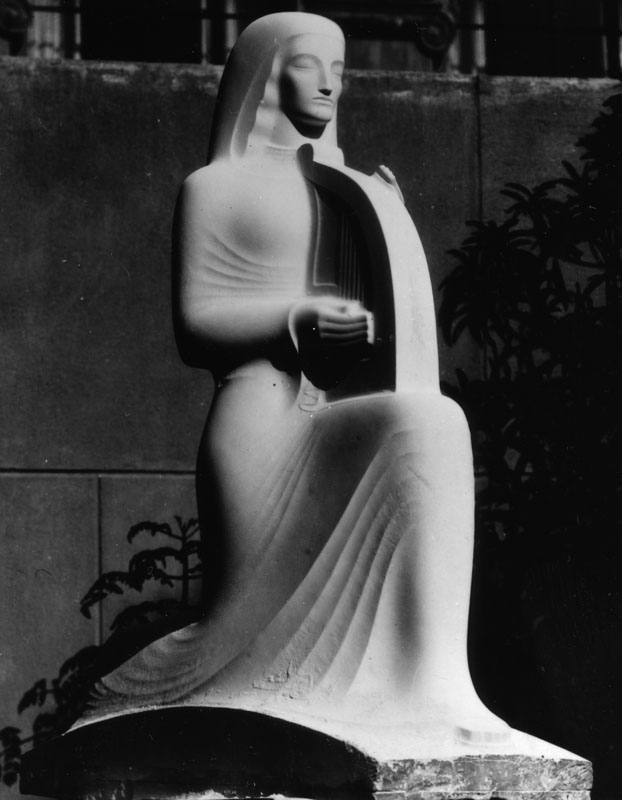 |
|
(1939)* - Construction of the Hollywood Bowl's "Muse of Music" sculpture at the entrance to the bowl. |
|
Historical Notes The sculpture incorporates natural embedded lighting to enhance its visual appeal. Carved from granite, the statue stands 22 feet tall and 200 feet wide, serving as both an artistic centerpiece and a functional retaining wall for the amphitheater. |
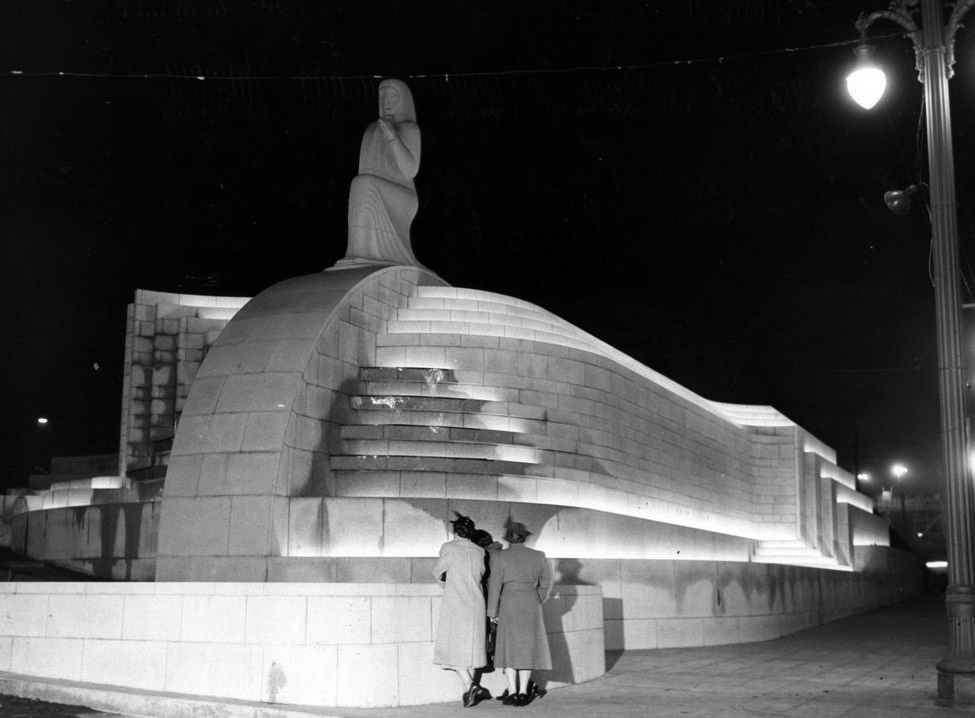 |
|
| (1940)* – Two women stand in front of the newly built Muse of Music sculpture at the entrance to the Hollywood Bowl. |
Historical Notes The design includes three figures representing music, dance, and drama, with the central Muse of Music playing a lyre as the focal point. Stanley envisioned the sculpture as a gateway to both the Hollywood Bowl and Hollywood itself, embodying the city's aspirations as a creative and artistic capital. |
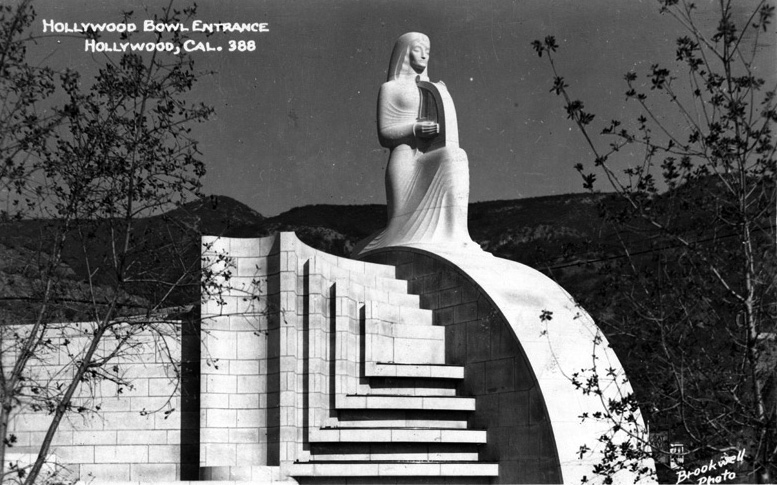 |
|
| (ca. 1940)^ - Postcard view of the Hollywood Bowl Entrance at dusk. |
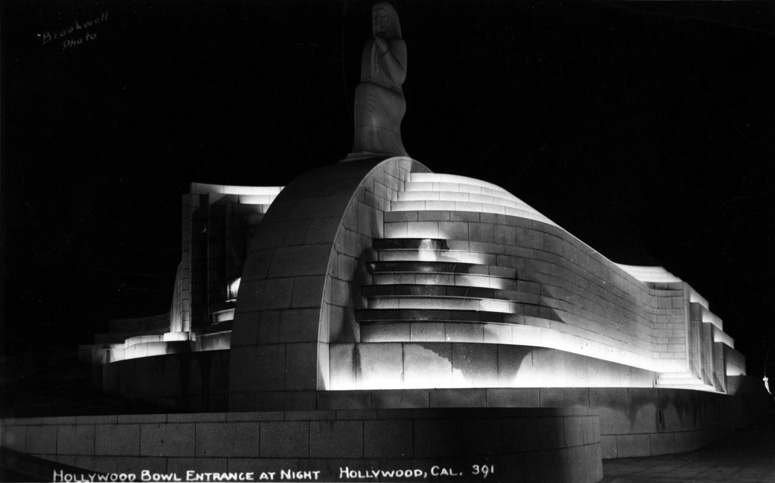 |
|
| (ca. 1940)^ - Postcard view of the "Muse of Music" Statue at the entrance to the Hollywood Bowl. |
Historical Notes The monument is composed of a multi-tiered concrete structure faced with granite blocks. A complex fountain system circulates water to pools at various levels of the monument. Granite sculptures depicting the three muses: Music, Dance, and Drama are mounted on the monument. The central figure of Music, 15′ in height, is depicted in a kneeling position playing a harp. Dance and Drama, each 10′ in height, are depicted as standing figures, located in niches along the sides of the monument. There is an entrance to the fountain pump and electrical system on the top tier, adjacent to the figure of Music. |
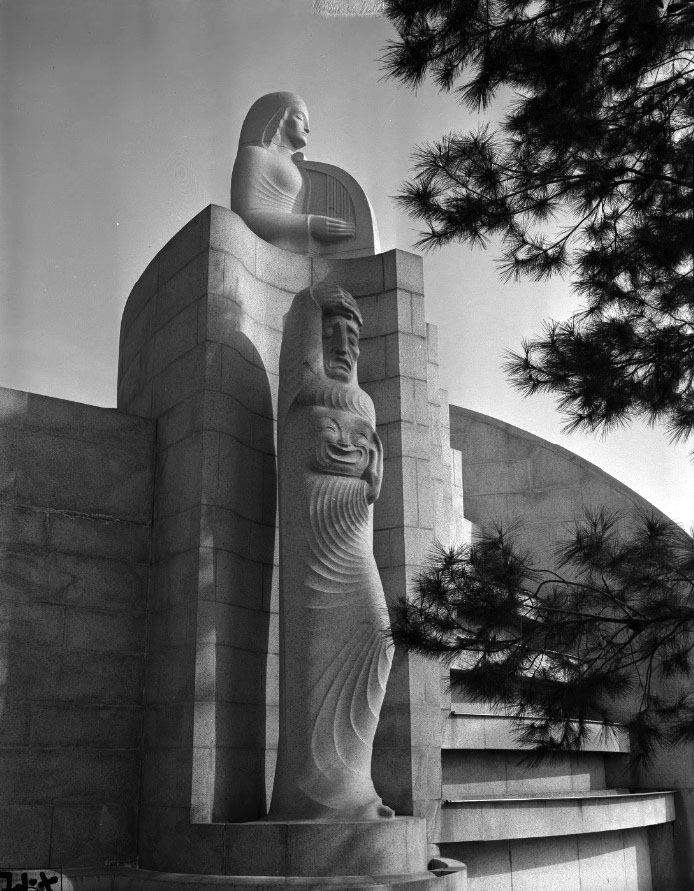 |
|
| (1940s)* - View showing the Muses of Music and Drama. |
Historical Notes The artistically modern statuary overlooks the entrance to Hollywood Bowl. Its construction in 1940 was one of the last acts of the depression-- a WPA art project. The statuary entitled "Muse of Music, Dance, Drama" was designed by sculptor George Stanley. |
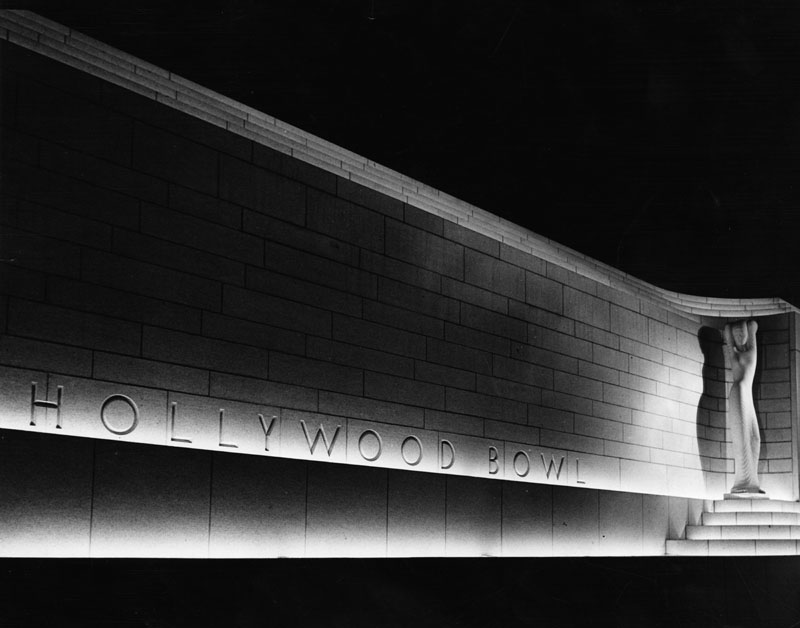 |
|
| (1940)* - Night view of one of the three muse statues and Hollywood Bowl sign at the entrance on July 10, 1940. |
Historical Notes The monument was altered in recent years. Modern tiles and lighting were installed. It is not known whether these additions are in keeping with the original plan for the monument. |
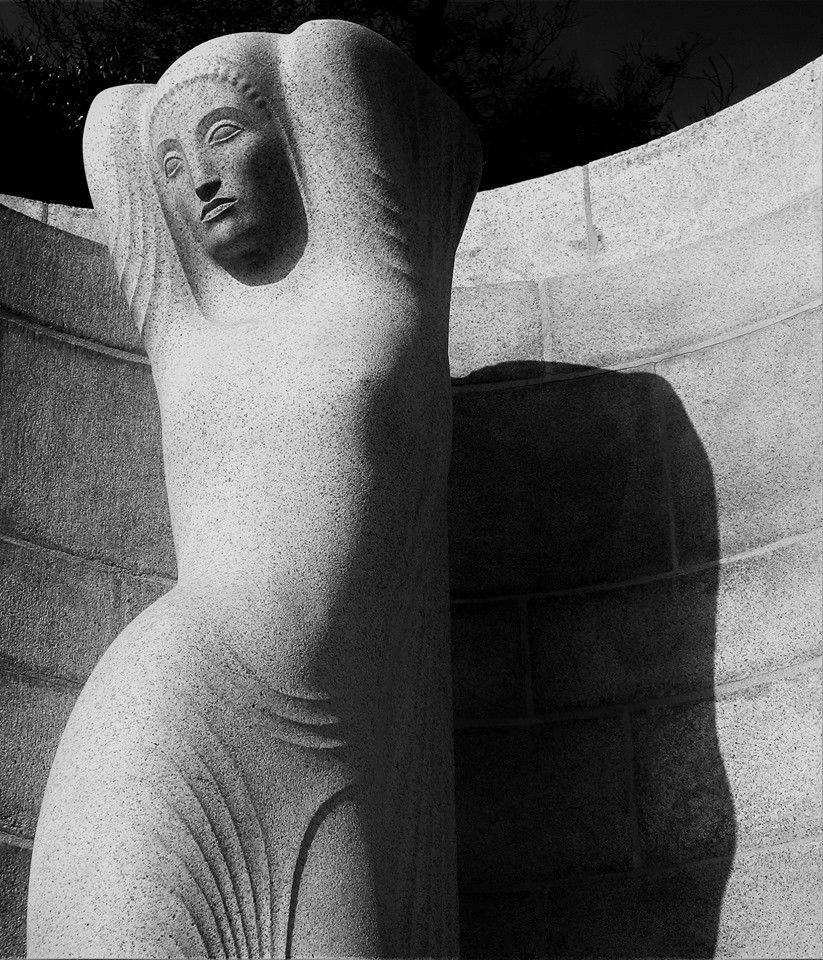 |
|
| (n.d.)* - Close-up view of one of the three muses in the George Stanley monument in front of the Hollywood Bowl. |
 |
|
| (ca. 1940)* - Postcard view showing entrance to the Hollywood Bowl. Note the Gruen Watch signboard. |
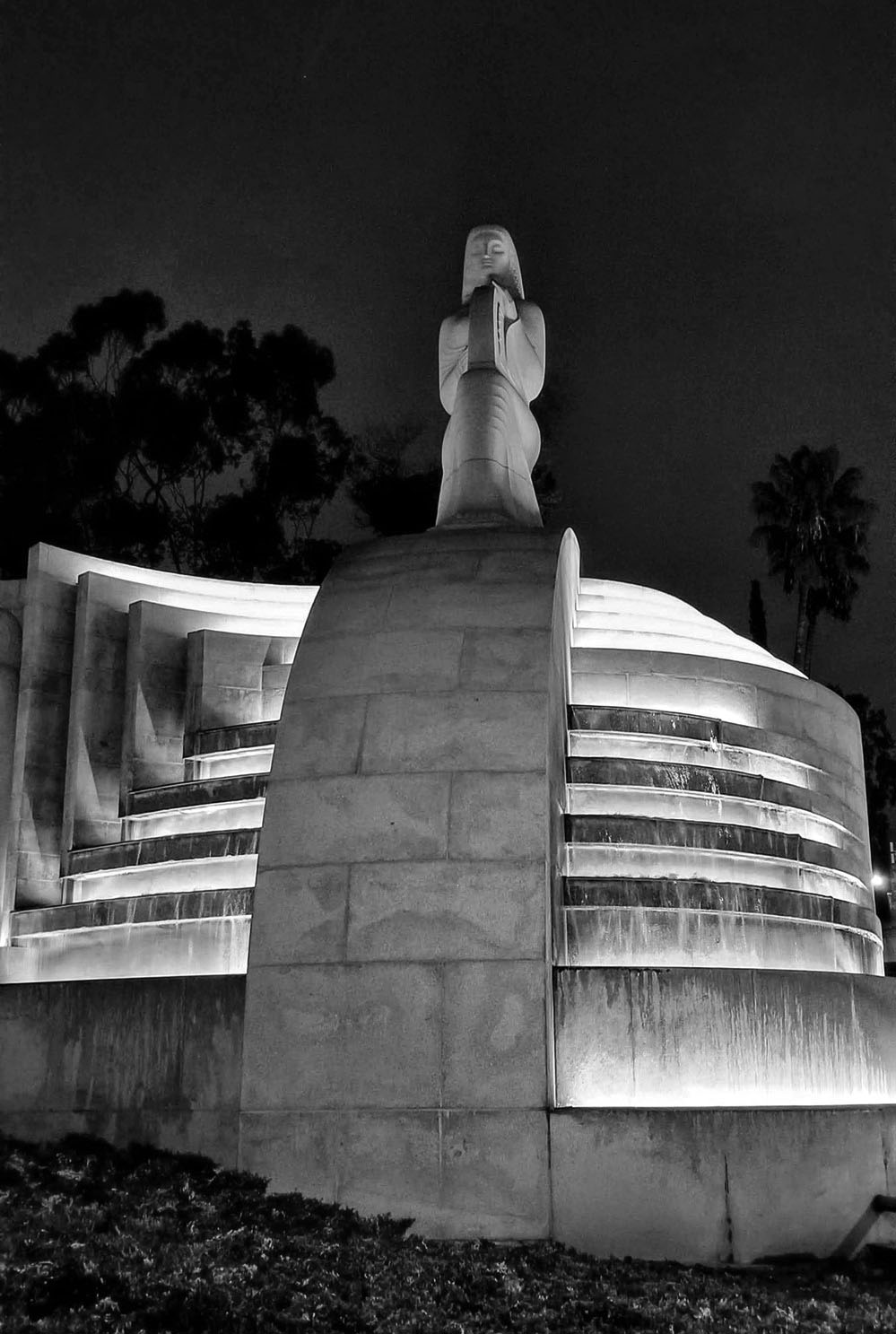 |
|
| (2021)* - Muse of Music Sculpture at the Hollywood Bowl as it appears today. Photo by Paul Wright |
* * * * * |
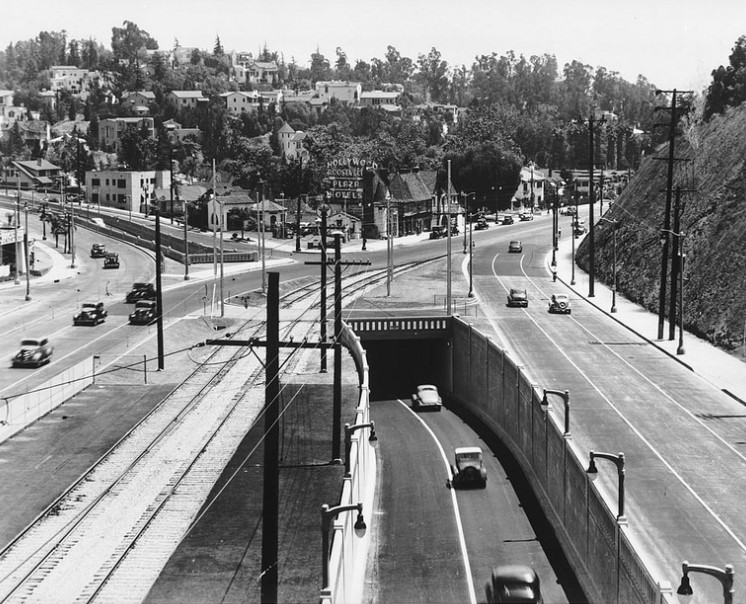 |
|
| (1938)* - Looking southeast at Whitley Heights across the intersection of Cahuenga Boulevard (foreground and to the left) and Highland Avenue to the right. Seriously complicated solution to the traffic pattern will be largely eliminated in the coming realignment and widening of Caheunga. Entrance to the Hollywood Bowl is just beyond the shoulder of the hill on the right. |
Historical Notes The first segment of the Hollywood Freeway built was a one and a half mile stretch through the Cahuenga Pass. That segment opened on June 15, 1940. It was then known as the "Cahuenga Pass Freeway." Pacific Electric Railway trolleys ran down the center of this freeway until 1952. |
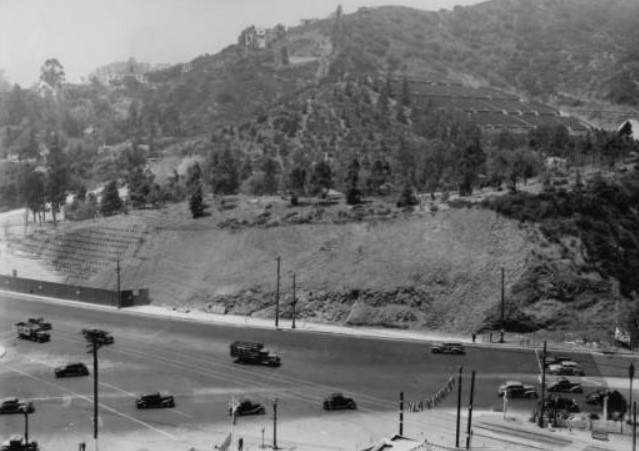 |
|
| (ca. 1940s)* - View from across the street of the Hollywood Bowl. Cars and trucks can be seen below on a paved road in the foreground. Most of the automobiles are traveling to the right. A few buildings are visible on a tree- and bush-filled mountain just beyond the road. The seating area of the Hollywood Bowl can be seen on the side of the mountain at right. A portion of the stage is also visible at far right. |
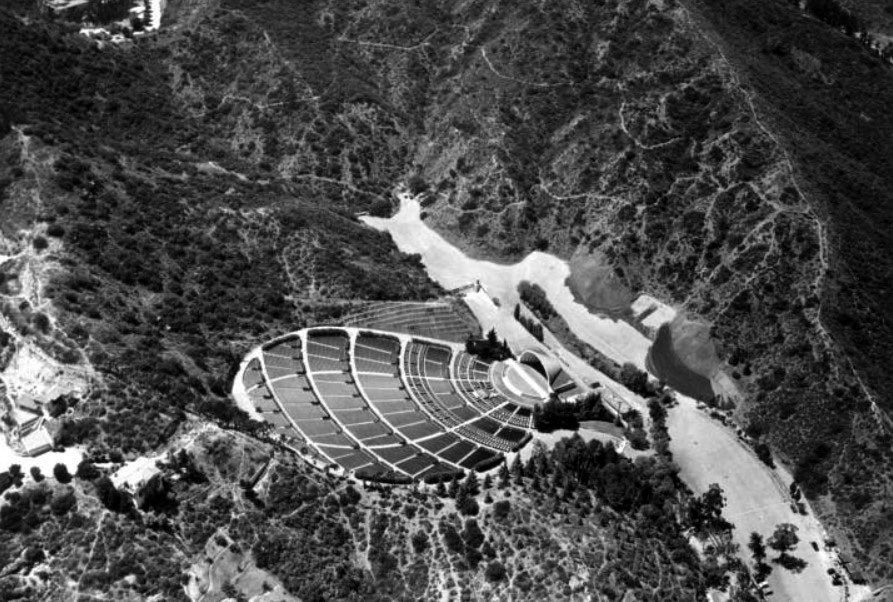 |
|
| (1940)* - Aerial view of the Hollywood Bowl, showing nearby houses and mountain trails. |
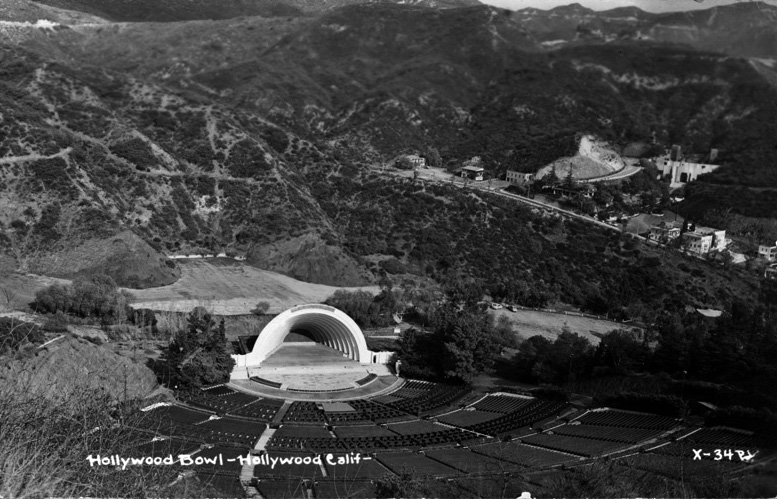 |
|
| (ca. 1940)* - View looking north showing the Hollywood Bowl and also the Pilgrimage Play Theatre located on the other side of Cahuenga Pass (right-center of photo). |
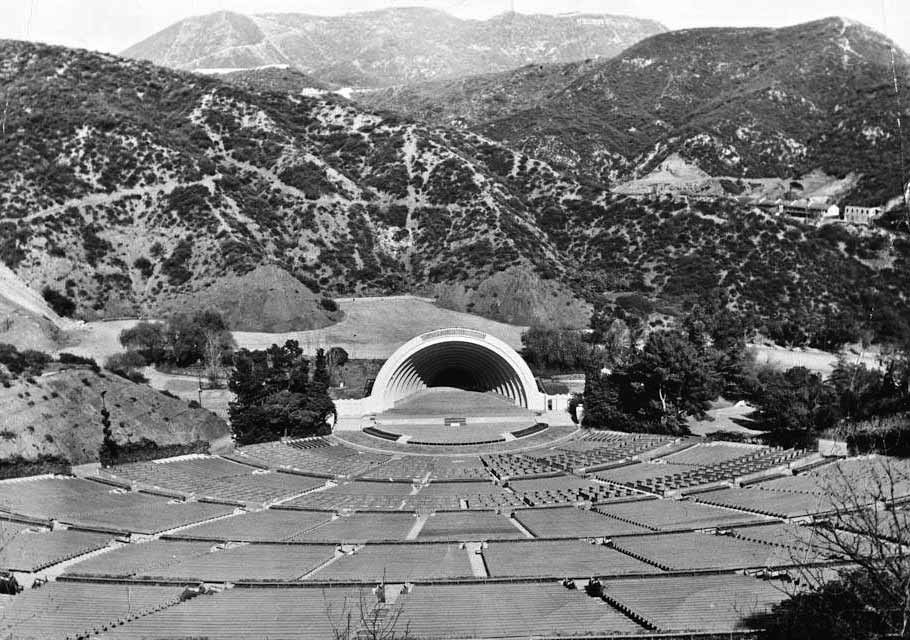 |
|
| (ca. 1940s)* - View of an empty Hollywood Bowl. The hills behind the bowl have been shaved off to enlarge the parking footprint. |
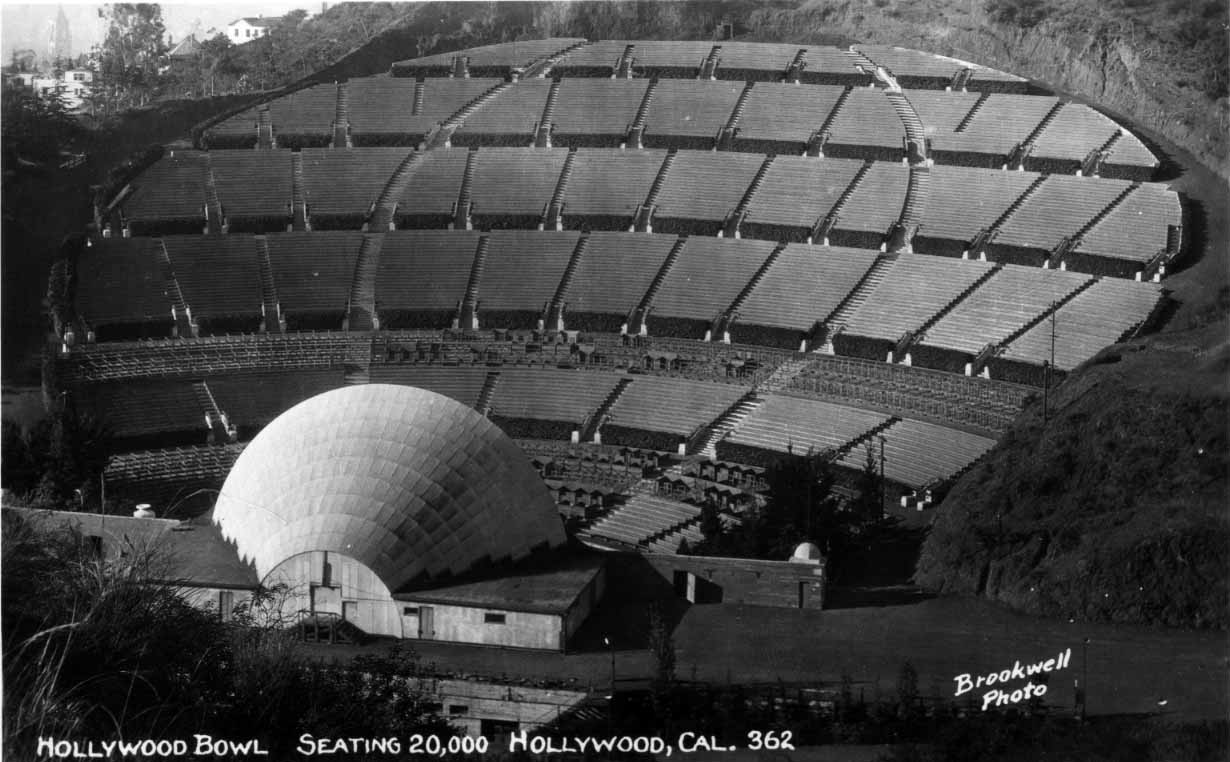 |
|
| (ca. 1942)* - Postcard view of the Hollywood Bowl and its 20,000 seats. |
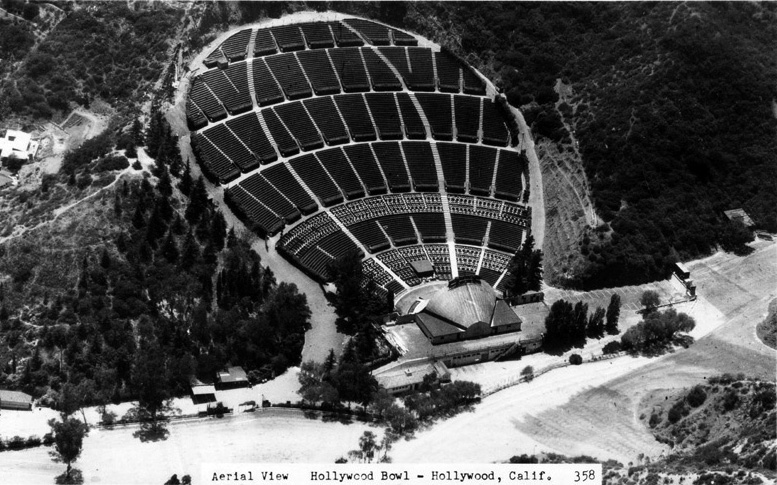 |
|
| (1940s)* - Aerial view of the Hollywood Bowl circa 1940s. |
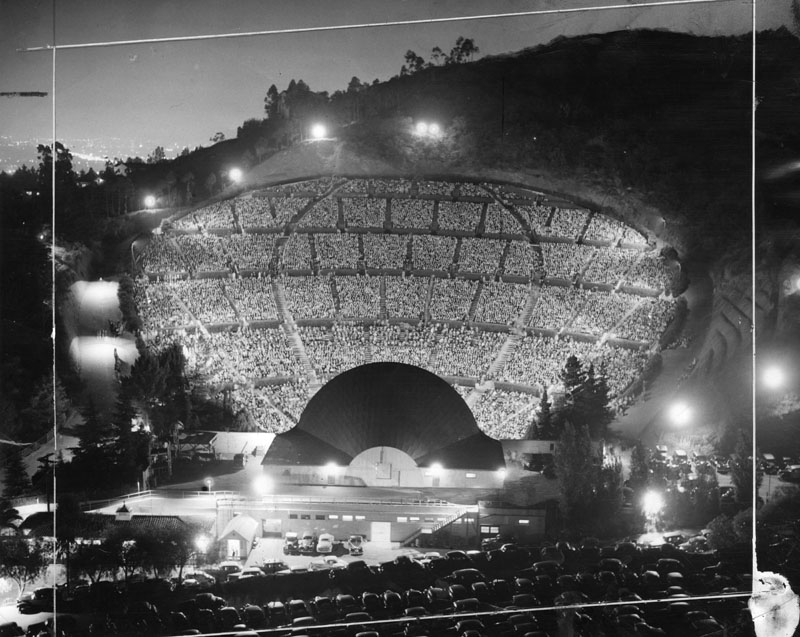 |
|
| (1941)* - Photo captions read: "Hollywood Bowl--getting face lifted for July 14 opener: It's pictured in night scene; Bowl enthusiasts will find new 'Meet Me There' circle and other innovations." "Picturesque Hollywood Bowl, home of the 'Symphonies Under the Stars,' will be the scene of a new series between July 15 and Sept. 7. The bowl is shown below with its beautiful panorama of light, color and music." |
Historical Notes In 1942, Hollywood Bowl audiences were limited to 5,000 due to war-related safety concerns. In 1943, Frank Sinatra's Hollywood Bowl debut on August 14 was the first appearance by a pop singer with the Los Angeles Philharmonic. In 1945, conductor and arranger Johnny Green made his Hollywood Bowl debut, ultimately performing 77 In 1946, Leopold Stokowski named Hollywood Bowl's first Music Director. |
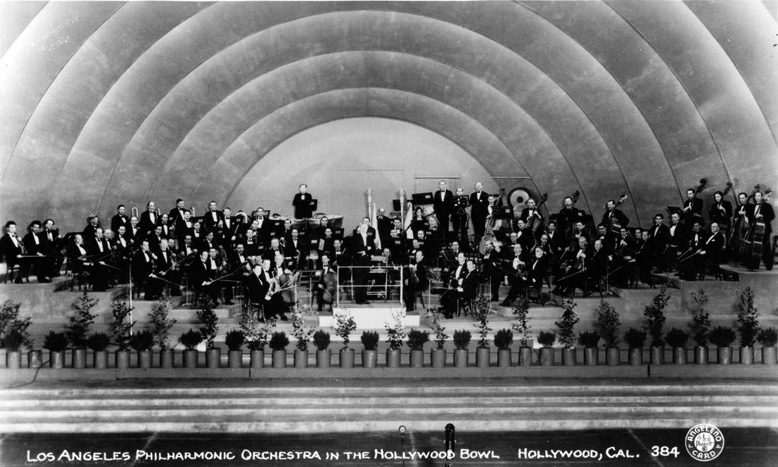 |
|
| (1940s)* - Postcard view of the Los Angeles Philharmonic Orchestra at the Hollywood Bowl. |
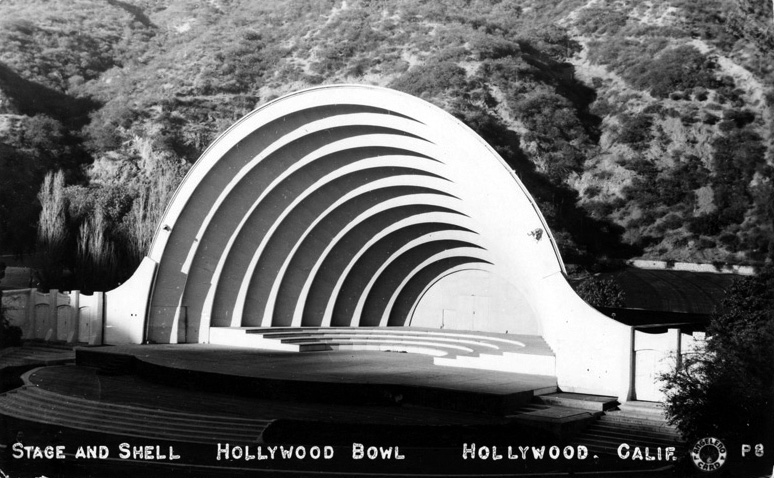 |
|
| (1940s)* - View of an empty stage and shell at the Hollywood Bowl. |
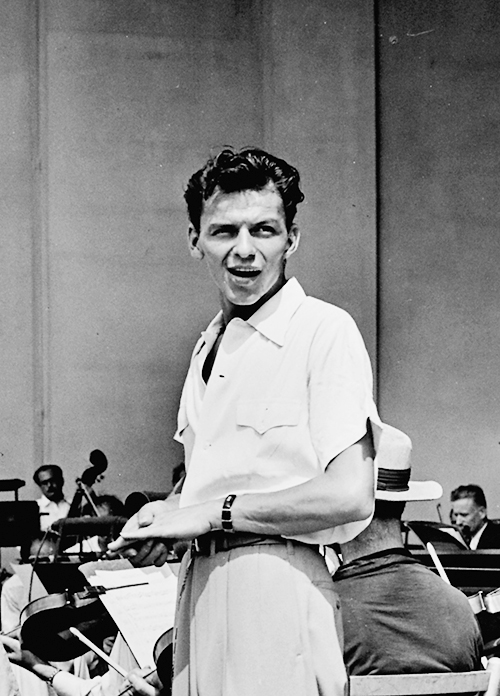 |
|
| (1943)* - Frank Sinatra's Hollywood Bowl debut on August 14, 1943 was the first appearance by a pop singer with the Los Angeles Philharmonic. |
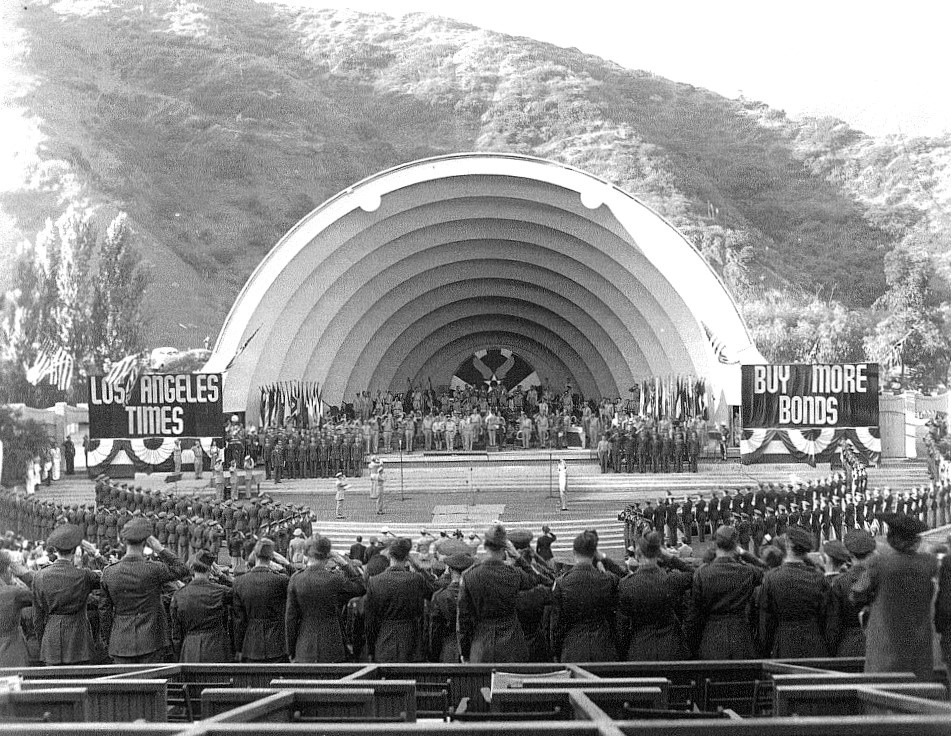 |
|
| (1942)* – Men and women in uniform salute during a War Bonds event at the Hollywood Bowl. The event was sponsored by the LA Times. |
Historical Notes In 1942, Hollywood Bowl audiences were limited to 5,000 due to war-related safety concerns. |
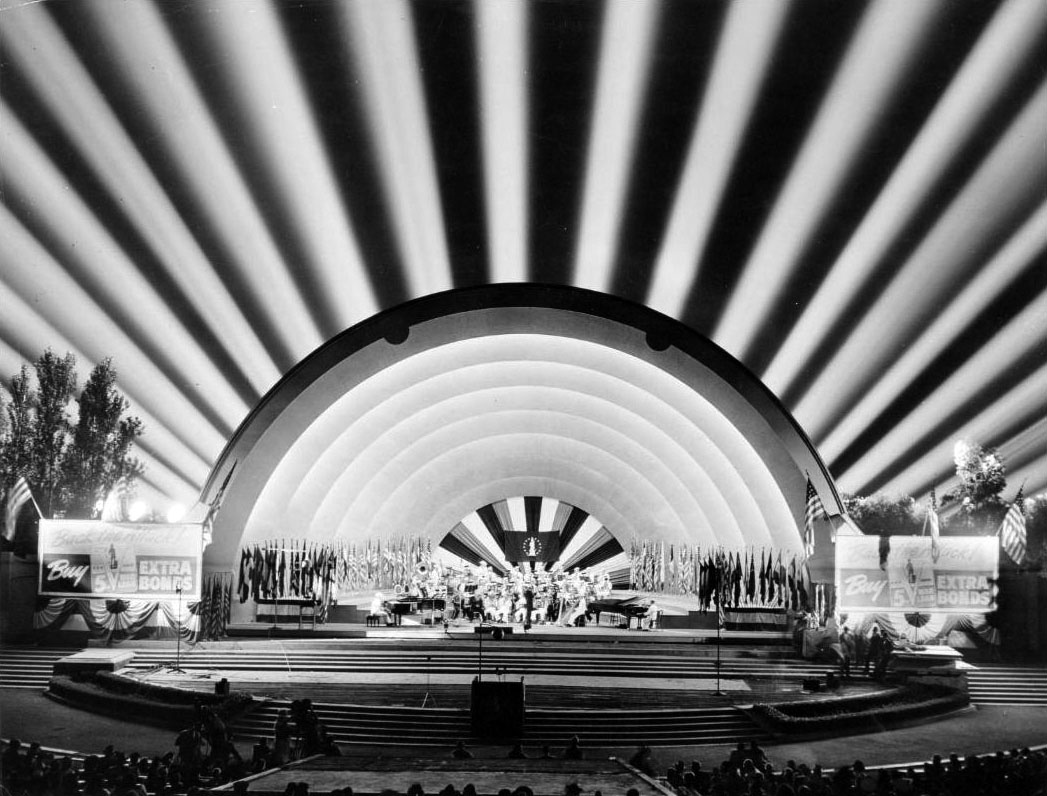 |
|
| (1944)* - Spotlights abound at a War Bonds event at the Hollywood Bowl. |
Historical Notes On June 14th, 1944, radio actors and actresses performed at the Hollywood Bowl during a war bond program. CBS broadcast the event. |
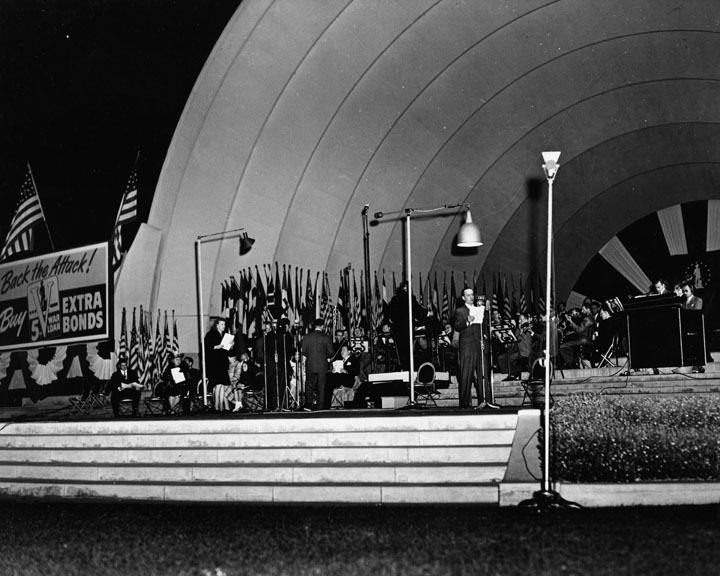 |
|
| (1944)* - An orchestra accompanies radio actors and actresses during a war bond program that was broadcast live. |
* * * * * |
Hollywood High School Graduation
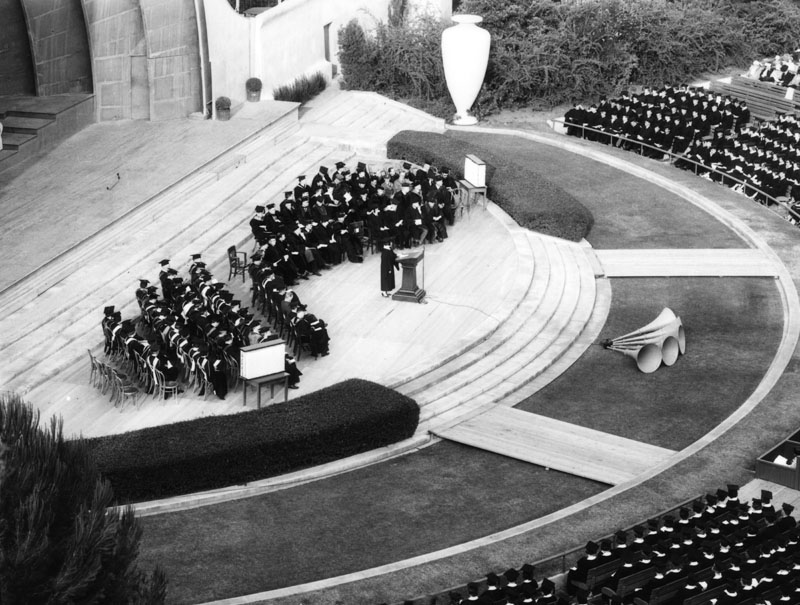 |
|
| (n.d.)* - A graduation ceremony takes place at the Hollywood Bowl. |
Historical Notes Hollywood High School held its first graduation at the Hollywood Bowl in 1922, following the venue's official opening, and continued to do so each year until 1970. Prior to that, informal gatherings were held at the site, and some sources suggest the school may have used the location for its ceremonies as early as 1920. Other institutions have also used the Hollywood Bowl for graduation ceremonies. Immaculate Heart High School has a long tradition of holding commencements there, including recent ceremonies in 2018, 2019, and 2024. UCLA also used the venue for its 31st commencement in 1950 |
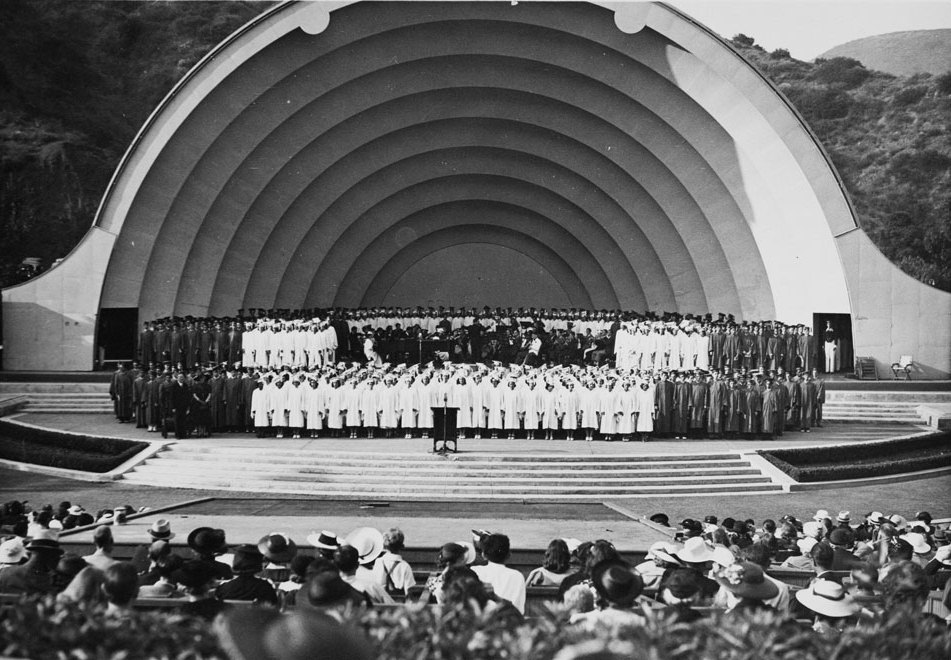 |
|
| (1930s)* - Hollwyood High School graduation ceremony at the Hollywood Bowl. |
Historical Notes From 1922 to the late 1970s, Hollywood High School held its graduation ceremonies at the Hollywood Bowl, making it one of the most distinctive commencement traditions in Los Angeles. As the first school to use the Bowl for graduation, Hollywood High took advantage of its grand outdoor setting and large seating capacity, drawing thousands of students and families each year. The tradition reinforced the school's deep ties to the entertainment industry, as many graduates went on to careers in film, television, and music. However, by the late 1970s, rising costs and logistical challenges led to the graduation being moved to other venues, ending a nearly 50-year tradition that had become a hallmark of the school’s history. |
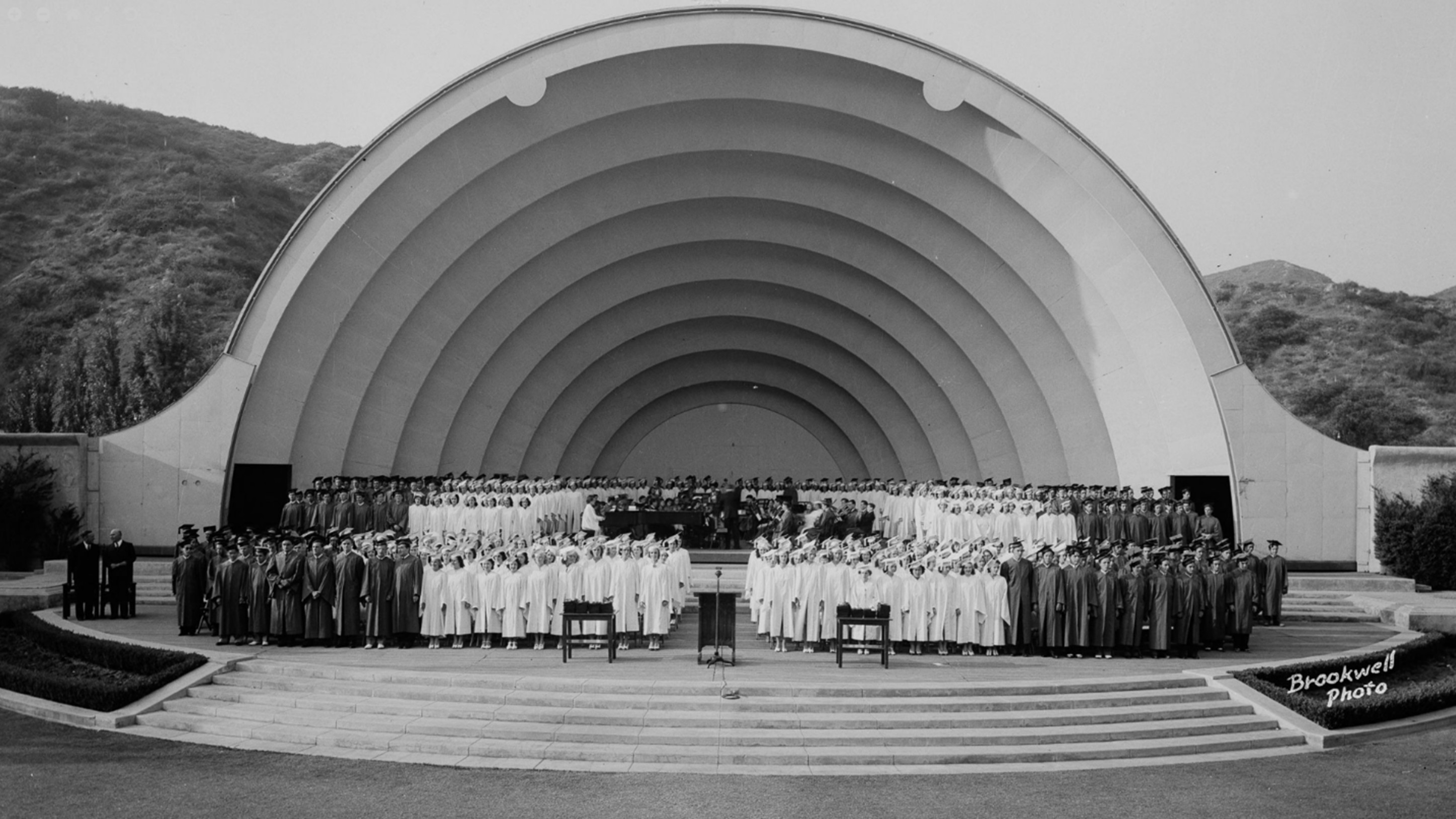 |
|
| (1939)* – View of the Hollywood High School graduation at the Hollywood Bowl. Photograph by Brockwell, from the Ernest Marquez Collection. |
* * * * * |
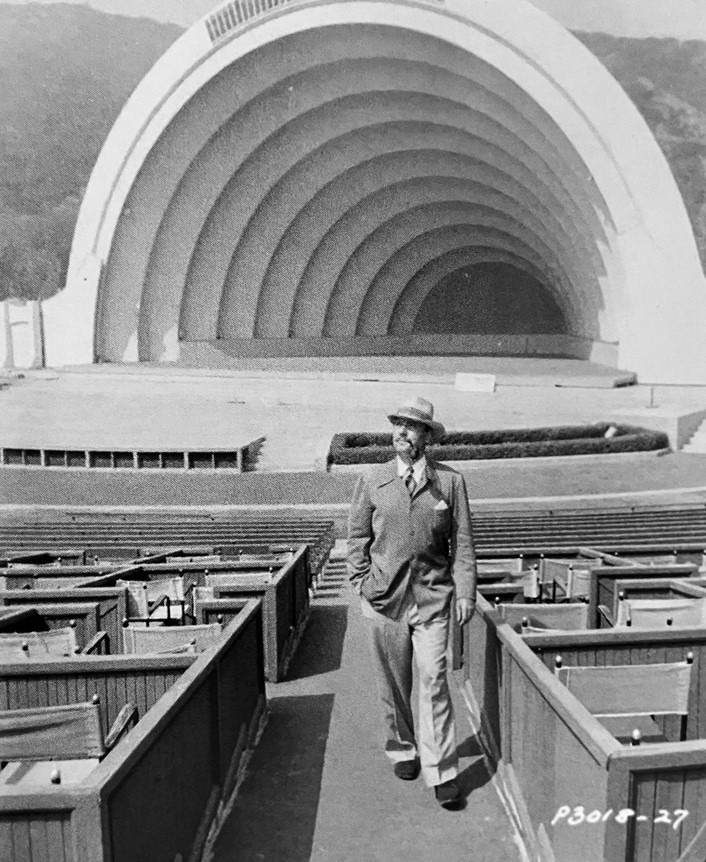 |
|
| (ca. 1948)* - The famed English actor Ralph Richardson, in Los Angeles to star in "The Heiress", takes a moment to visit the Hollywood Bowl. |
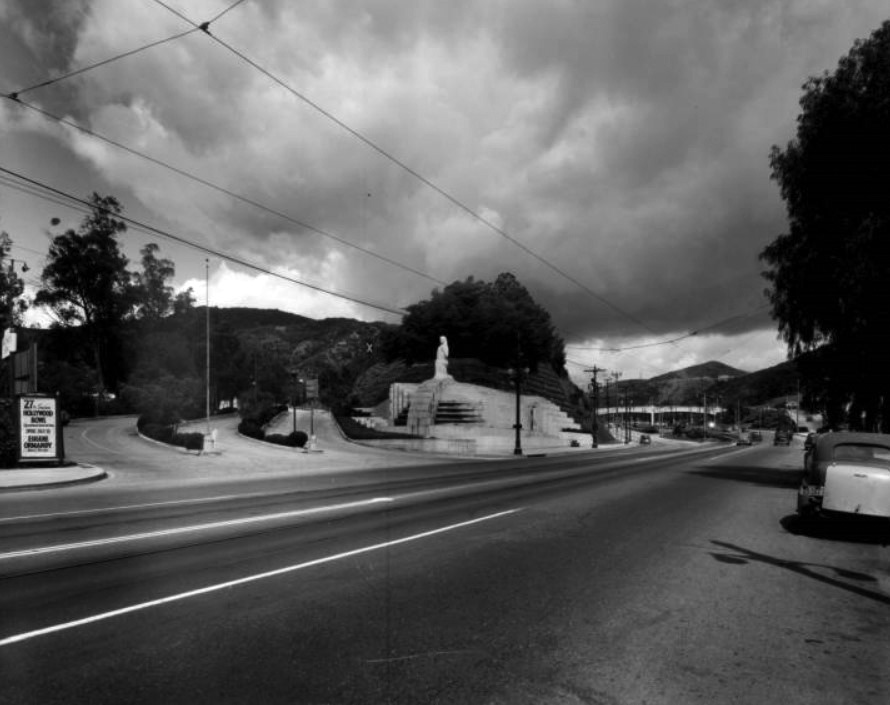 |
|
| (ca. 1948)* – View of the entrance and driveway leading to the Hollywood Bowl, 2301 North Highland Avenue. |
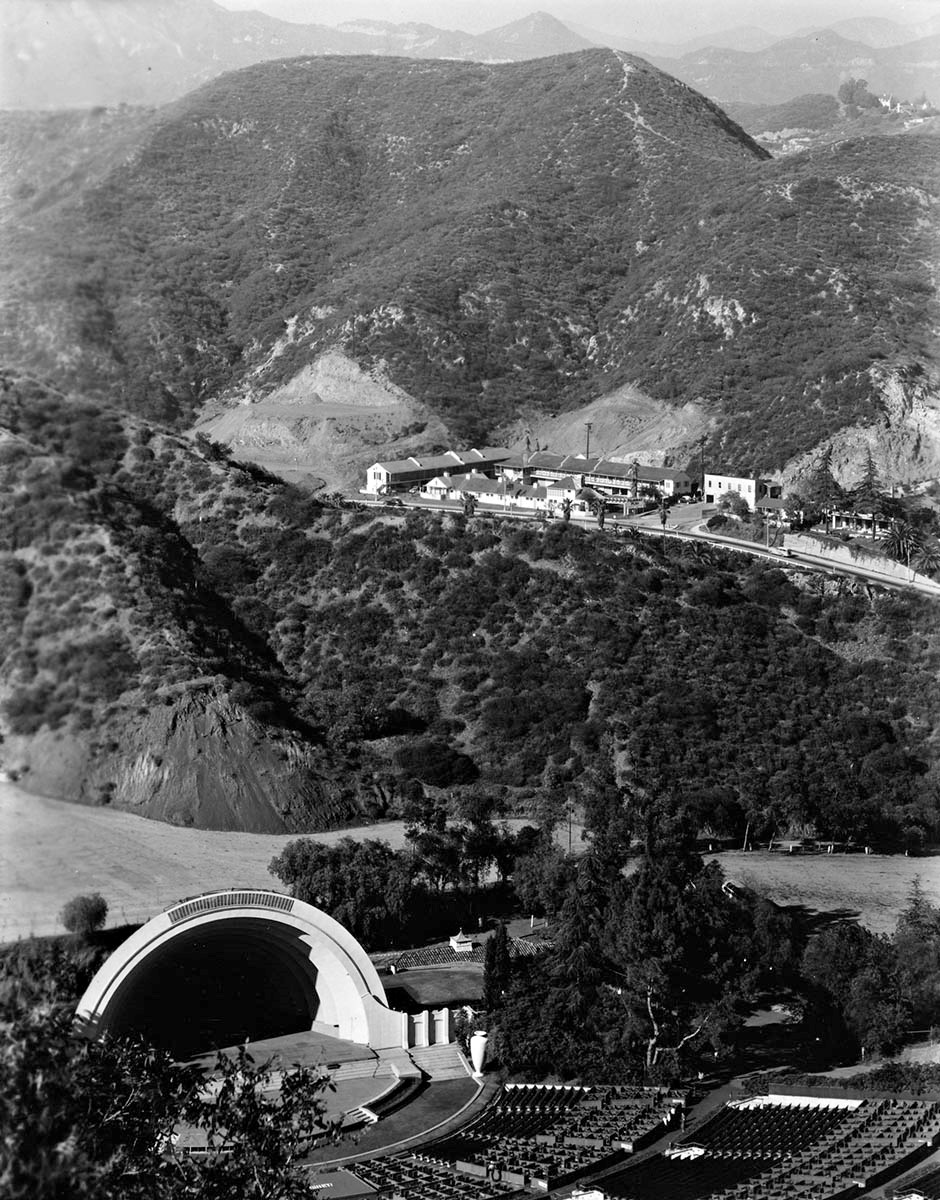 |
|
| (1949)* – View looking down toward the Hollywood Bowl showing the shell and an empty parking lot behind it. The building complex across Cahuenga Pass is the Franciscan Motel (no longer there). Click HERE for contemporary view. |
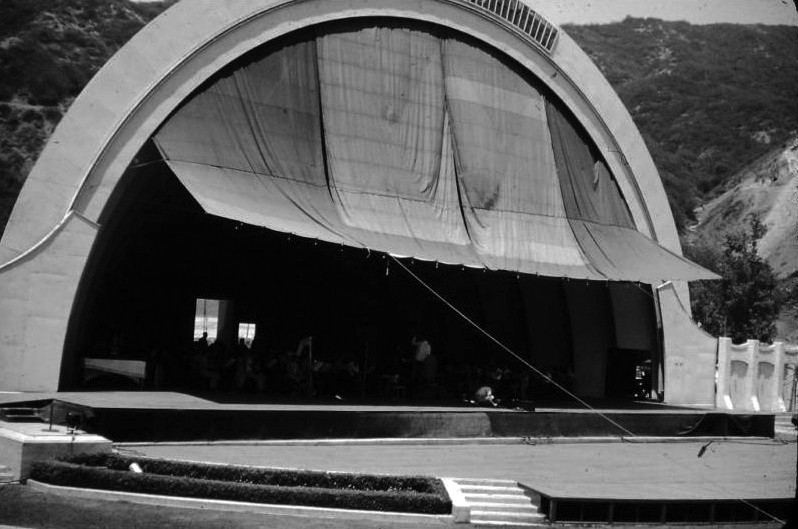 |
|
| (1950)* - A large 'blind' is used to shield the orchestra from the hot sun during rehearsals. |
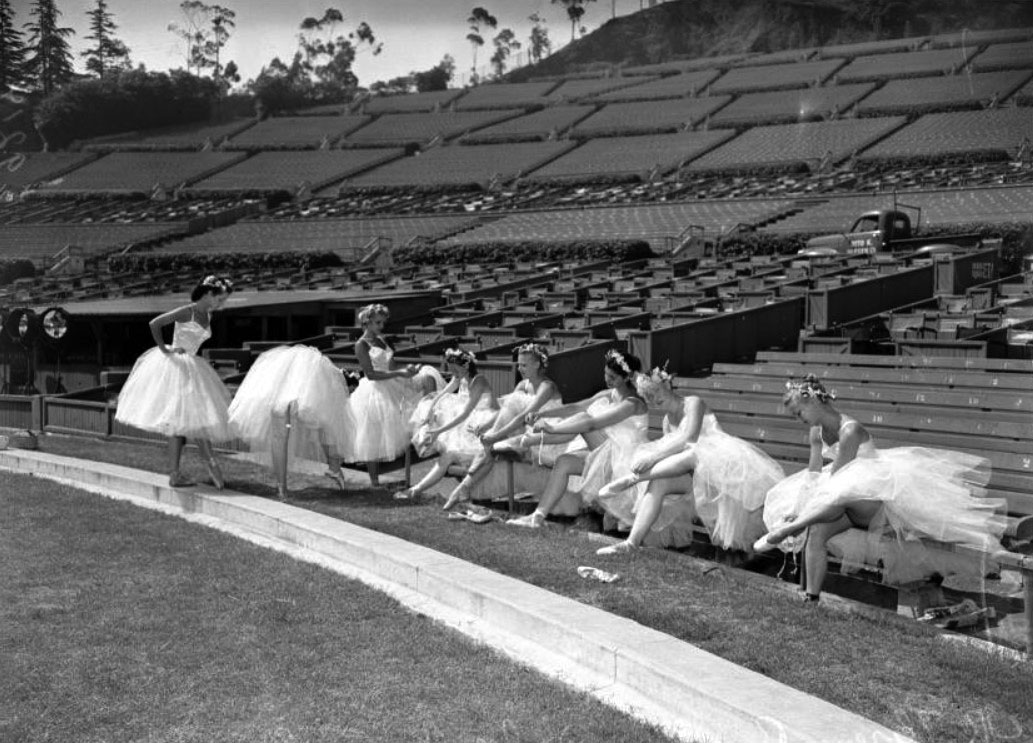 |
|
| (1951)* - View showing ballerinas preparing for a dress rehearsal of Strauss’ Die Fledermaus. |
Historical Notes Five performances of Johann Strauss' Die Fledermaus opened the 1951 season at the Hollywood Bowl. With the Bowl on the brink of financial collapse, this unpopular and costly production precipitated an abrupt cancellation of the remainder of the season. |
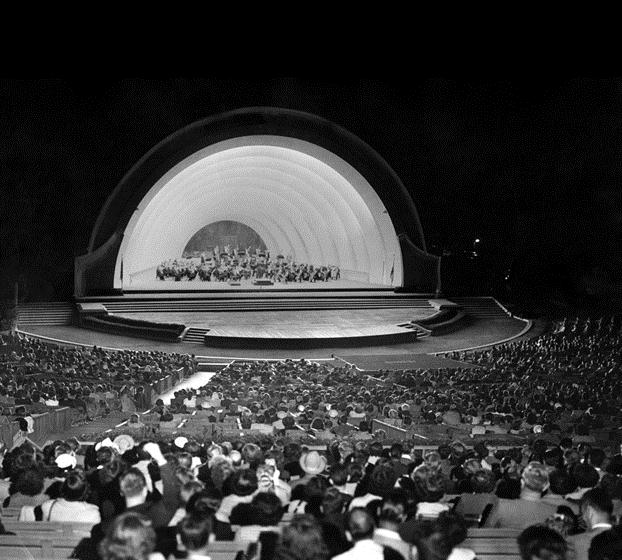 |
|
| (1951)* - Thousands attend the reopening of the Hollywood Bowl made possible by the virtuoso fundraising efforts of Dorothy Chandler on July 26, 1951. |
Historical Notes Dorothy Buffum Chandler, head of an Emergency Committee, successfully raised funds and rallied support for the Bowl from throughout the world, allowing the season to resume 12 days later. This is the only time Bowl season was interrupted. |
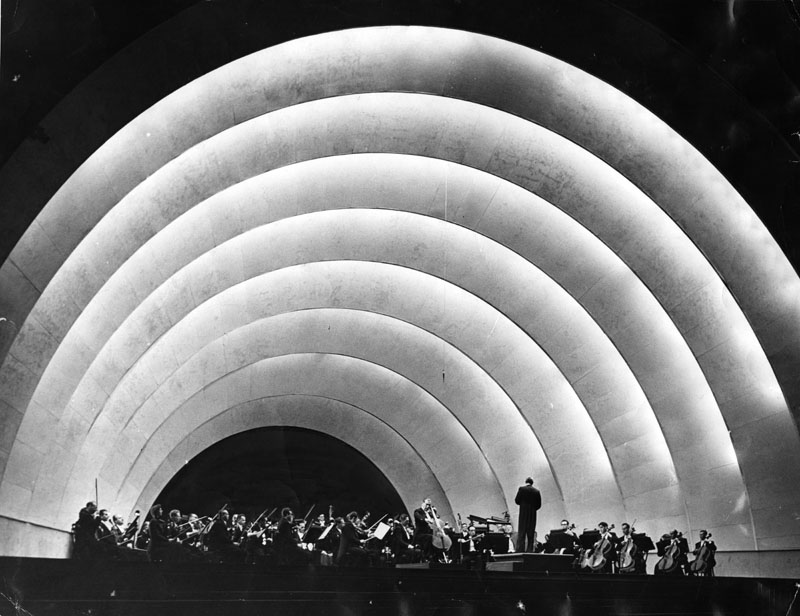 |
|
| (1951)* - Under the shell of the Hollywood Bowl, Alfred Wallenstein conducts the Los Angeles Philharmonic Orchestra in a triumphant reopening of the Symphonies Under the Stars. The concerts were resumed after a reorganization of policy. |
Historical Notes The Symphony Under the Stars at the Hollywood Bowl in the 1950s was a vibrant and integral part of Los Angeles' cultural landscape. During this decade, the Hollywood Bowl Symphony Orchestra, led by renowned conductors such as Felix Slatkin, Miklós Rózsa, Carmen Dragon, and Alfred Newman, was the primary ensemble performing at the venue. The orchestra gained widespread recognition through its extensive series of recordings released by Capitol Records, which helped popularize the concerts beyond the local audience. Despite facing a brief financial crisis in 1951, the Bowl quickly rebounded thanks to fundraising efforts. A triumphant reopening concert, featuring Alfred Wallenstein conducting the Los Angeles Philharmonic Orchestra, marked its return to prominence. |
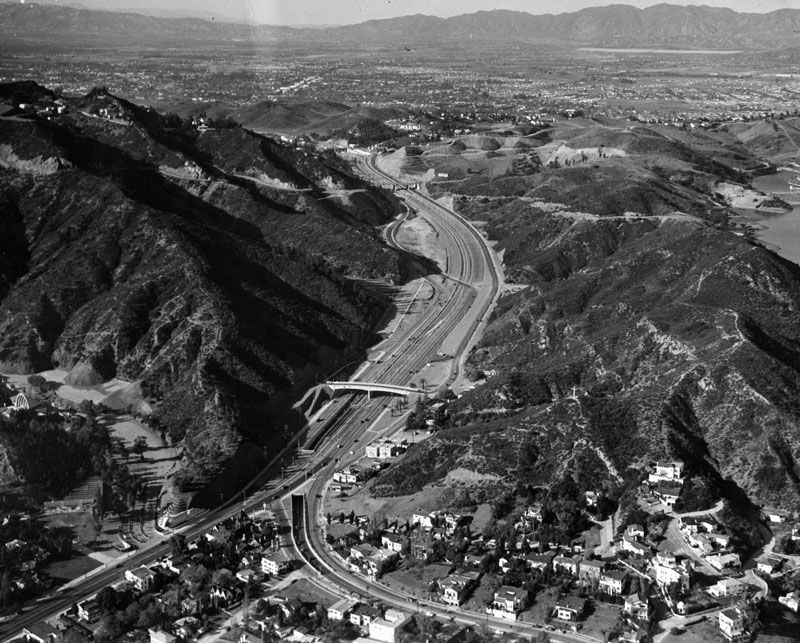 |
|
| (ca. 1951)* - Bird's eye view of the Hollywood Freeway through the Cahuenga Pass, looking towards the Valley. The Cahuenga Tunnel under Highland Avenue can be seen at lower center-left. The "Muse of Music" Statue at the entrance to the Hollywood Bowl is visible just to the left of the tunnel as is part of the Hollywood Bowl shell (center-left). |
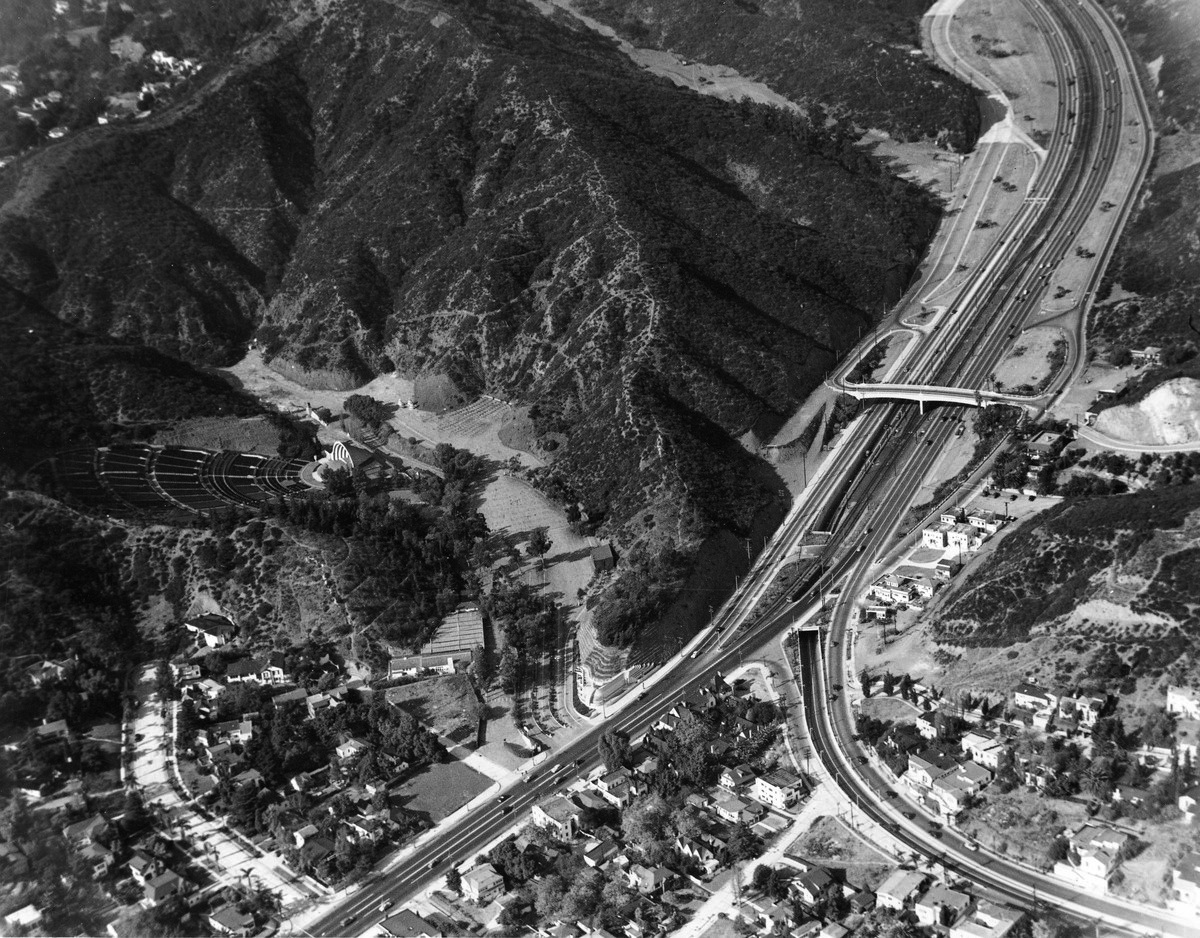 |
|
| (1952)* – Aerial view showing the Hollywood Bowl and the end of the Cahuenga Pass Freeway (Hollywood Freeway). The freeway would soon be extended all the way to Downtown L.A. |
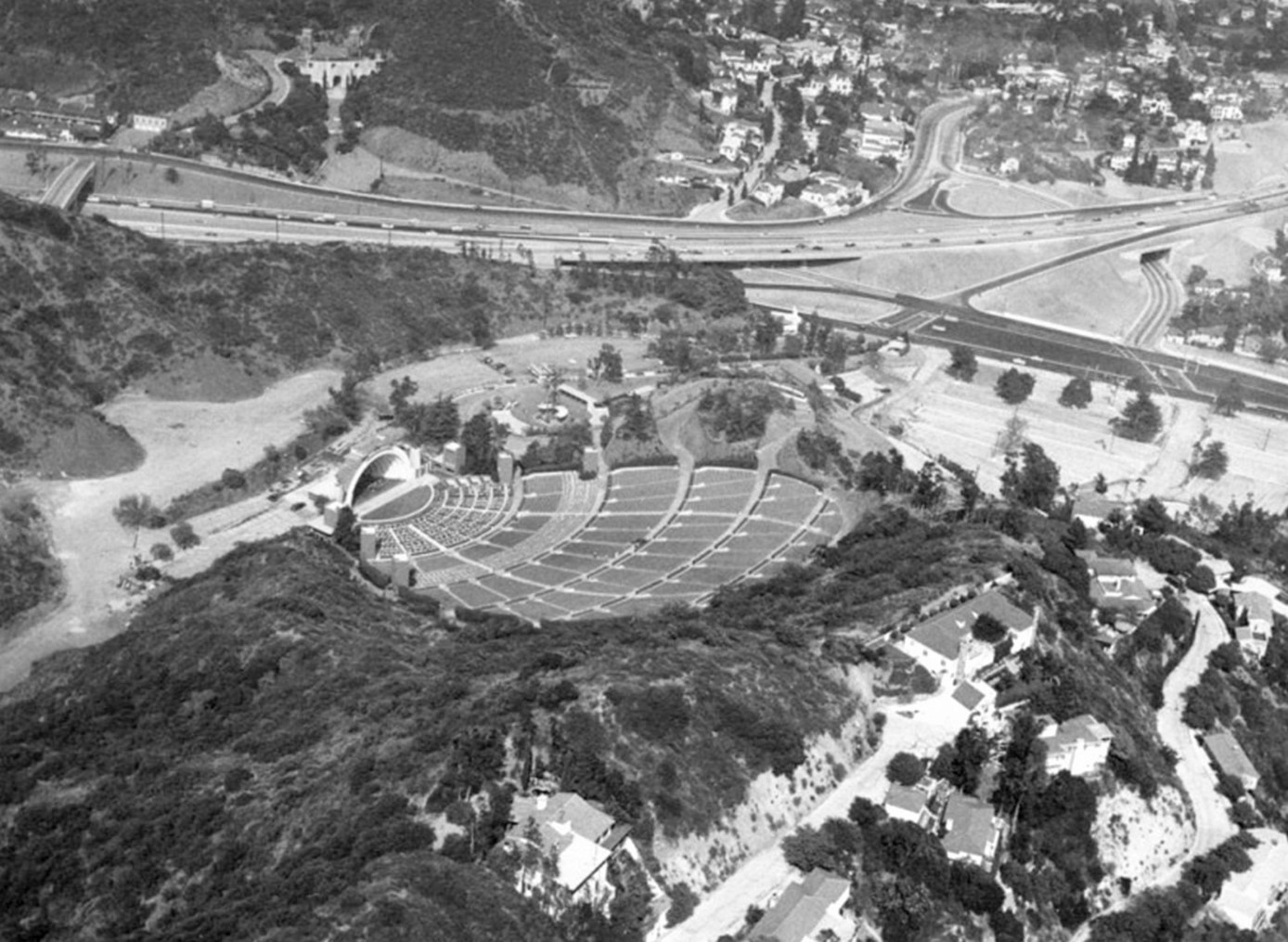 |
|
| 1950s)* - Aerial view of the Hollywood Bowl and surrounding area, taken from the Goodyear Blimp. The Pilgrimage Theatre can be seen at upper left. |
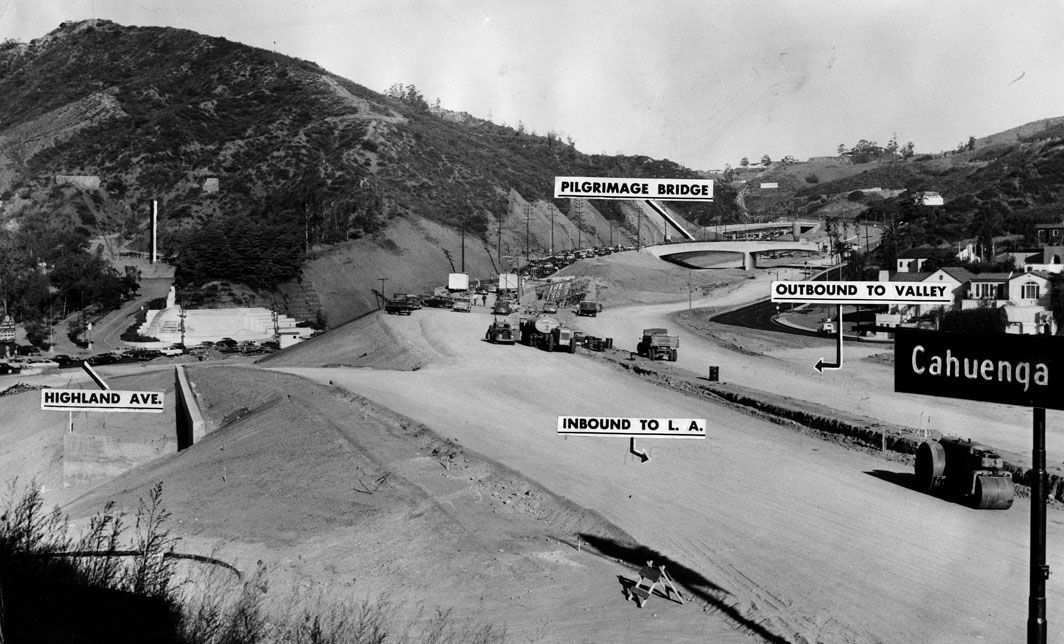 |
|
| (1953)* - View looking north showing the construction progress of the Hollywood Freeway through Cahuenga Pass (Phas II) with the Pilgrimage Bridge in the background. Highland Avenue is seen on the left near the front entrance to the Hollywood Bowl. r again in 1965. |
Historical Notes With the completion of the Hollywood Freeway near the Bowl, the environment was altered, creating more ambient traffic noise around the venue. |
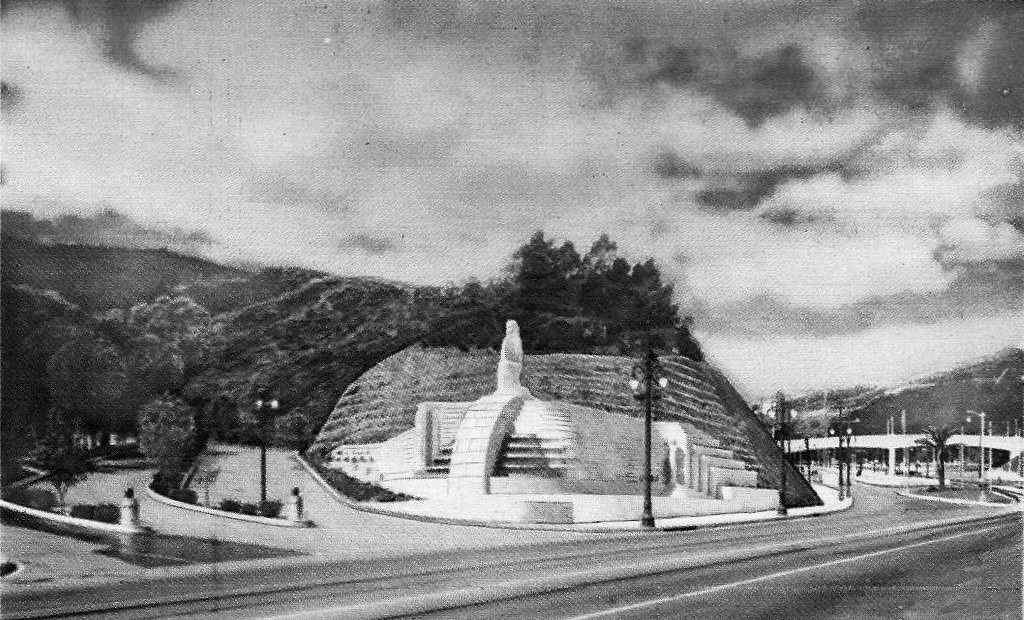 |
|
| (ca. 1953)* – Postcard view showing the "Muse of Music" sculpture at the entrance to the Hollywood Bowl. |
* * * * * |
Circus at the Hollwyood Bowl
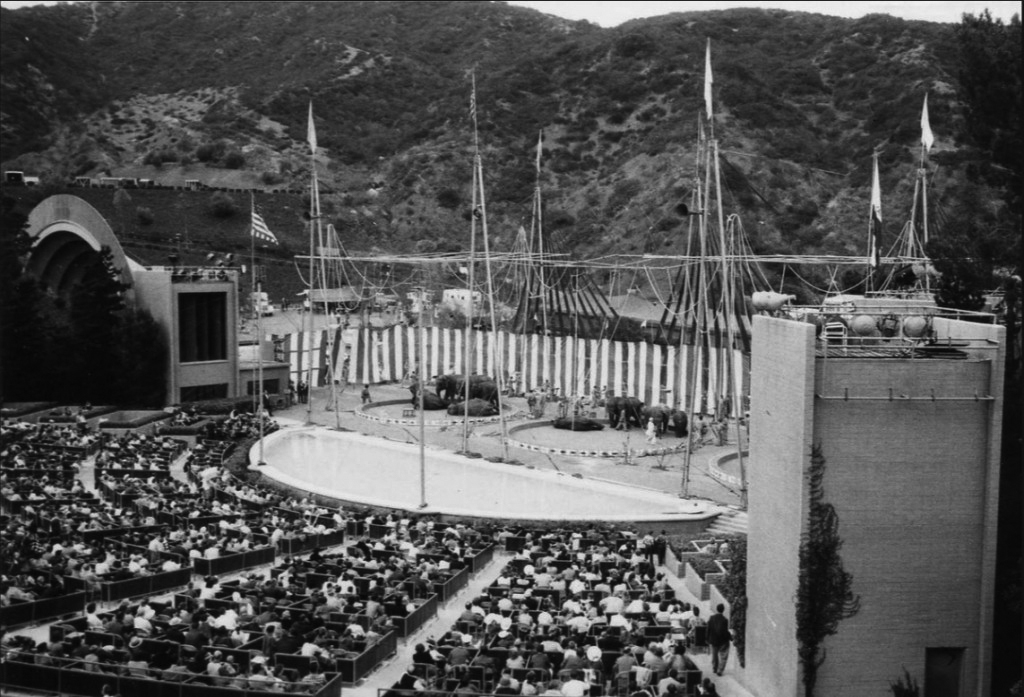 |
|
| (1953)* - The Ringling Brothers and Barnum & Bailey Circus perform on the Hollywood Bowl’s stage complete with elephants, flying trapeze, and cannons. Note that the Hollywood Bowl shell has been moved to the side (on the left). |
Historical Notes In September 1953, the Ringling Brothers and Barnum & Bailey Circus performed at the Hollywood Bowl, transforming the renowned music venue into a vibrant circus stage. Known as "The Greatest Show on Earth," the circus showcased a variety of thrilling acts, including elephants, flying trapeze performances, and cannon acts, captivating the audience with its grand spectacle. This event occurred during a significant period for both the circus and the Hollywood Bowl; by 1953, the circus had become a well-established American institution through the merger of two historic operations, while the Hollywood Bowl had evolved into a prominent venue for musical performances since its opening in 1922. The performance marked a unique intersection of entertainment, blending the excitement of circus acts with the grandeur of one of America's most famous outdoor venues, creating a memorable experience for attendees. |
* * * * * |
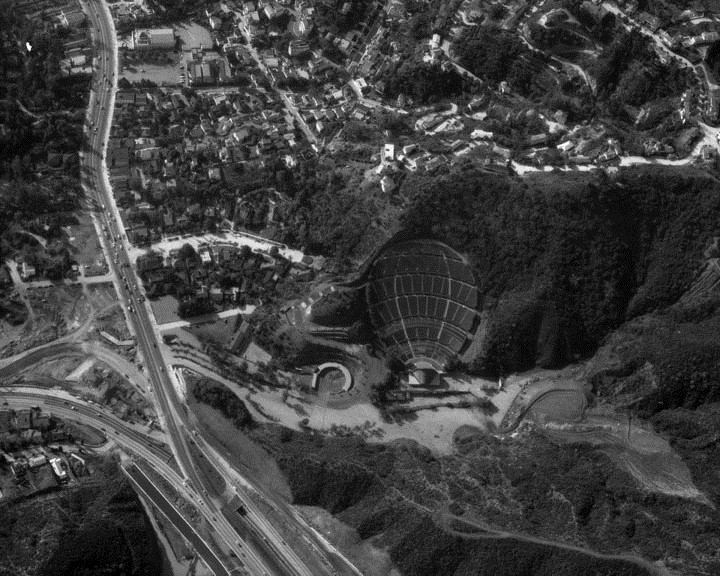 |
|
| (1954)* - Aerial view of the Hollywood Bowl nestled in the mountains on the right, the Hollywood Freeway and Cahuenga Pass are on the left. View is looking toward Hollywood. |
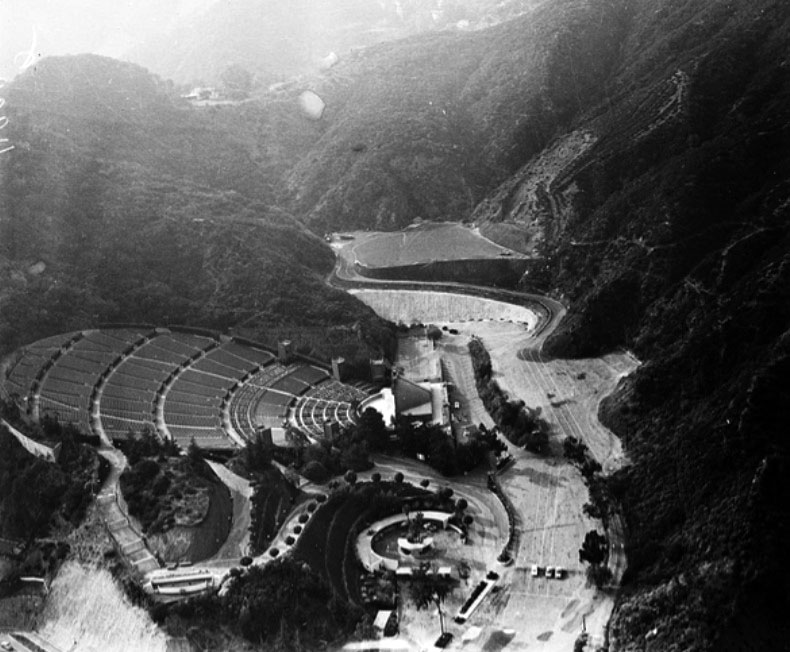 |
|
| (1956)* – Aerial view showing a slightly different angle of the Hollywood Bowl. |
* * * * * |
Eisenhower Political Campaign
.jpg) |
|
| (1956)* - View of the Hollywood Bowl during a political campaign speech by President Dwight D. Eisenhower on October 19, 1956. |
Historical Notes President Dwight D. Eisenhower delivered a pivotal campaign speech at the Hollywood Bowl in Los Angeles on October 19, 1956, as part of his re-election bid. The iconic outdoor amphitheater provided a dramatic setting for the address, which was broadcast on regional television networks. |
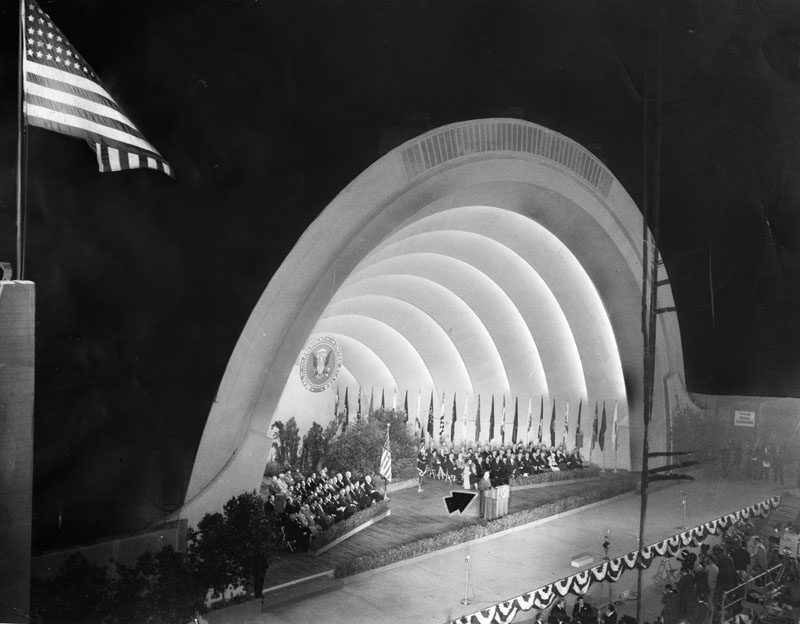 |
|
| (1956)* - The graceful arch of the famed Hollywood Bowl looms behind President Eisenhower (arrow) as he addresses the throng in the outdoor amphitheater on October 20, 1956. He ripped apart every facet of the Stevenson-Kefauver campaign proposals, especially the H-bomb test abolishment. |
Historical Notes In his speech, Eisenhower emphasized national unity, rejecting any division of Americans into "little men" and "big men". He highlighted his administration's economic achievements, including record-high labor income shares and employment levels. The President also stressed America's global importance, describing it as the hope of free people worldwide. Eisenhower emphasized that the nation's strength was not just military but also spiritual, intellectual, and economic. As part of his campaign strategy, he endorsed local Republican candidates, including Senator Thomas Kuchel and his running mate, Vice President Richard Nixon. |
* * * * * |
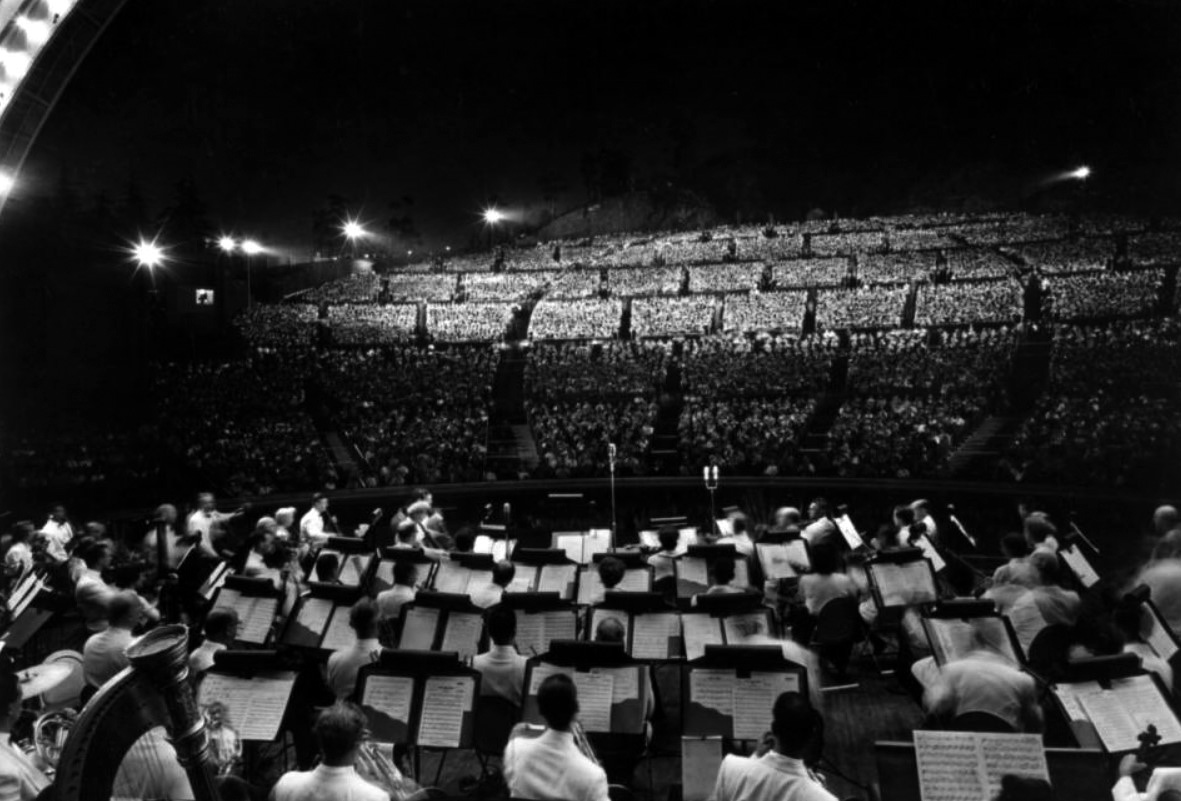 |
|
| (1957)* – Looking over the orchestra toward the audience during a Symphony Under the Stars at the Hollywood Bowl. |
Hollwyood Bowl Reflecting Pool and Fountain
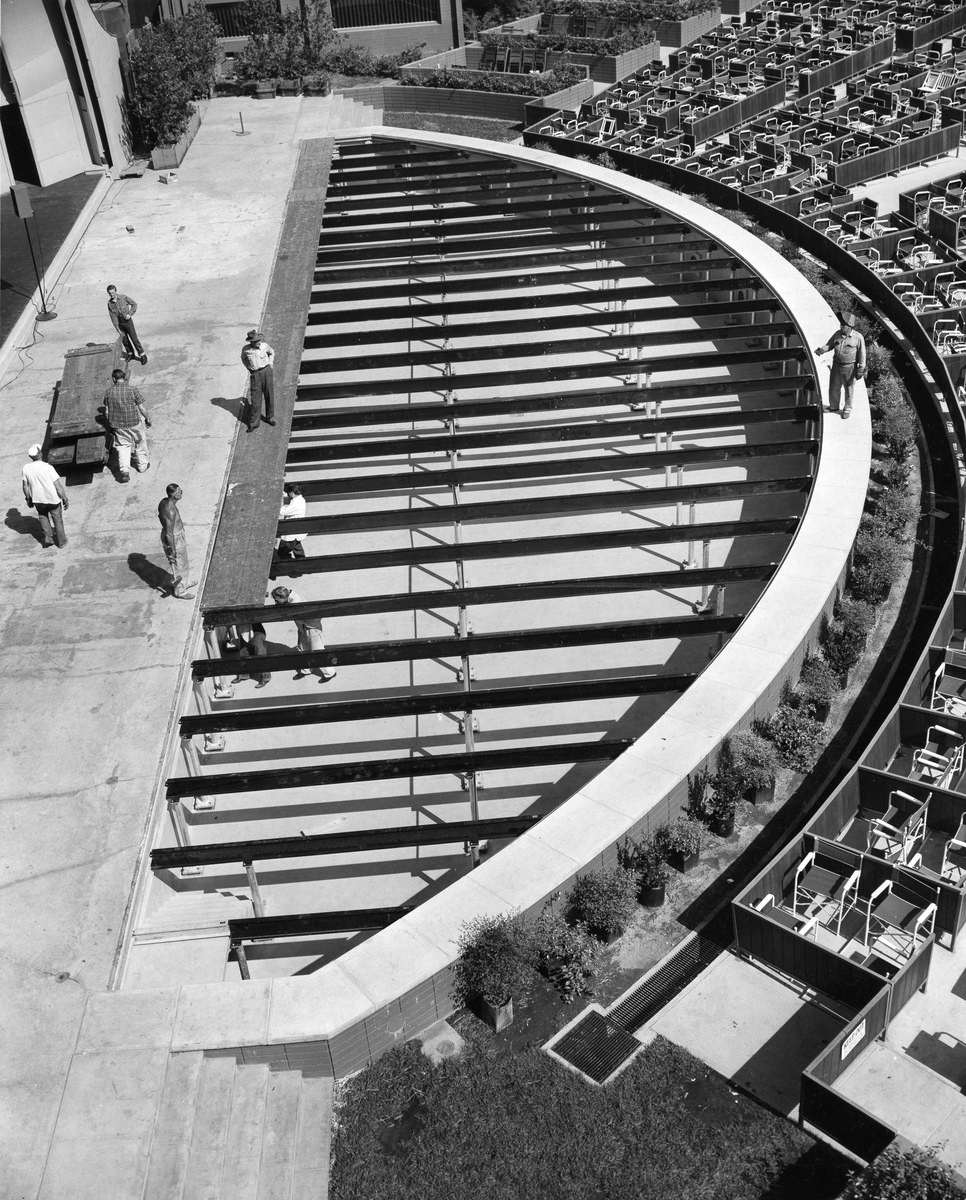 |
|
| (1953)* – View showing the installation of the reflecting pool at the Bowl. |
Historical Notes In 1953 a decorative reflecting pool measuring 106 feet long, 36 feet wide, and six feet deep, with a capacity of 100,000 gallons of water, was installed in front of the stage. |
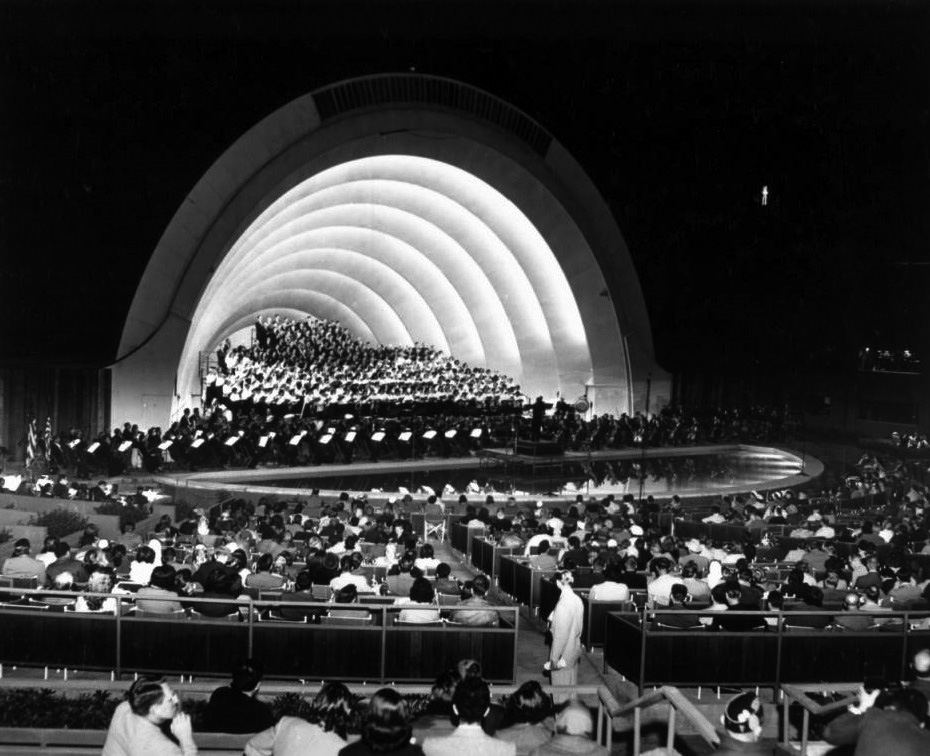 |
|
| (1957)* – View of a choir singing at the Hollywood Bowl behind the L.A. Philharmonic. |
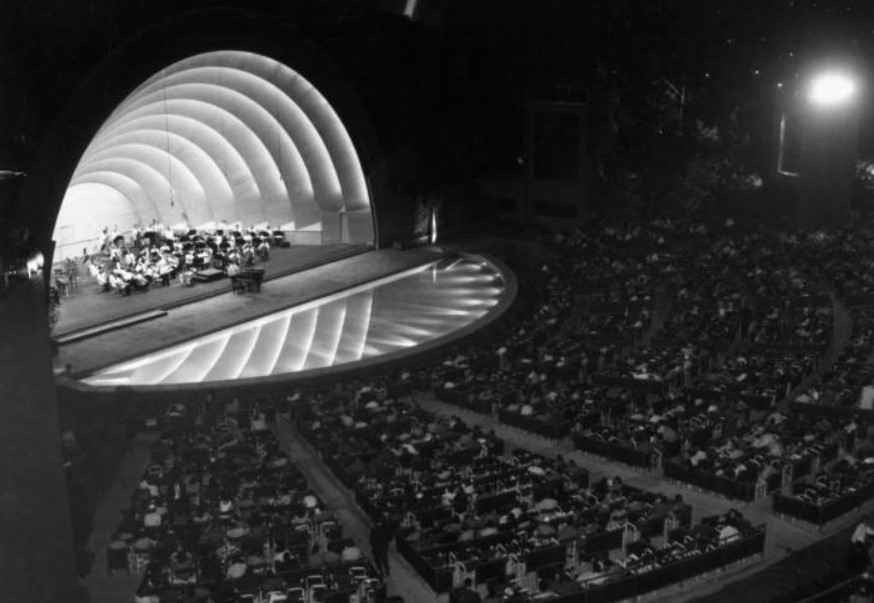 |
|
| (1950s)* - A small orchestra giving a nighttime concert at the Hollywood Bowl. |
Historical Notes The Hollywood Bowl reflecting pool in front of the stage was installed in 1953 and removed only 19 years later in 1972. |
 |
|
| (1950s)* – Close-up night view showing the reflecting pool with its underwater lights spaced out around the edge. |
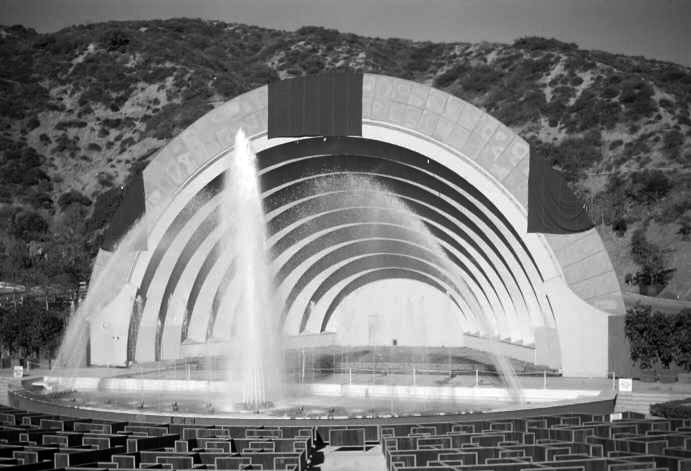 |
|
| (1959)* - Daytime view of the Hollywood Bowl with its new fountains turned on to their full capacity. The reflecting pool and fountains would be removed in 1972. |
Historical Notes The Hollywood Bowl fountains were installed July, 1959. They would be removed along with the reflecting pool in 1972. |
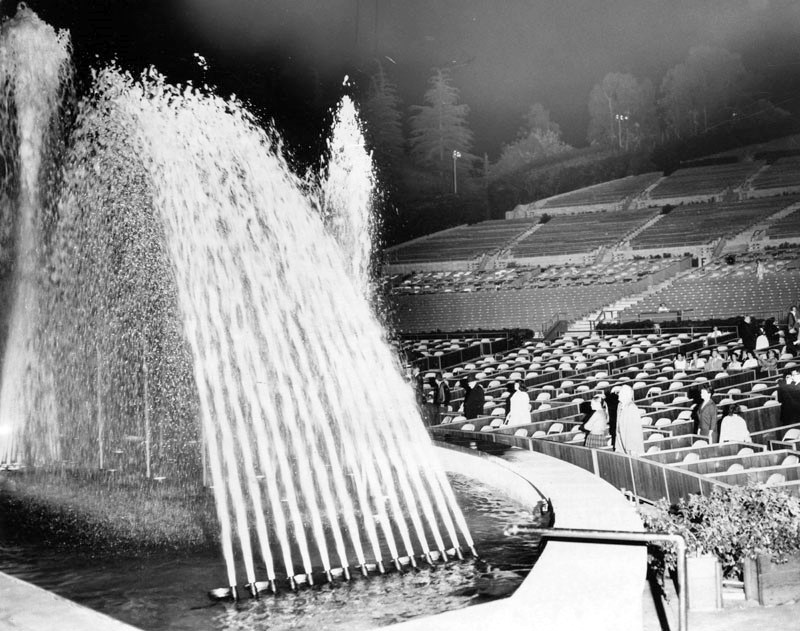 |
|
| (1959)* - Photograph caption dated June 18, 1959 reads, "Hollywood Bowl fountains dedicated. Multi-jet water fountain which will spout water to top of Hollywood Bowl's sound shell has been dedicated by Wayne Griffin, Bowl association president. New fountain will throw 2,500 gallons of water, lighted by various colored underwater lights and tower spots. Fountain was designed by world-famous designer Henry Dreyfuss and executed by S. J. Hamel, who designed 1939 New York World's Fair fountains and was the creator of Disneyland effects." |
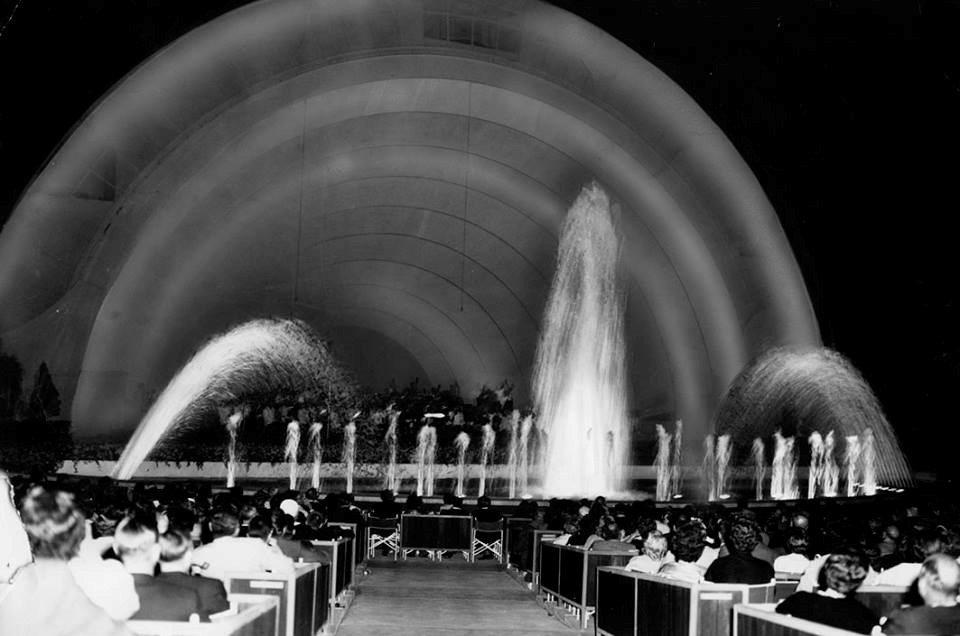 |
|
| (1959)* - The Hollywood Bowl shows off its newly added fountains at one of its performances during the 1959 season. |
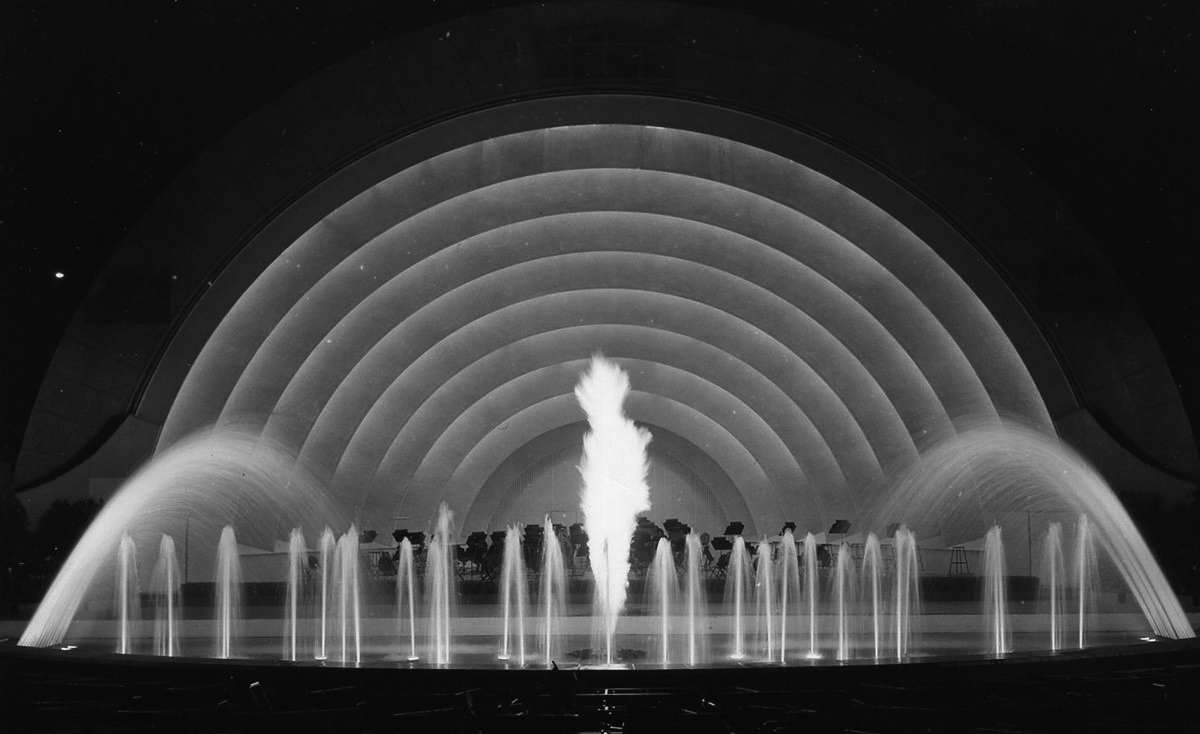 |
|
| (1959)* – View showing the reflecting pool fountains at the Hollywood Bowl, with fire spouting from the center. |
Historical Notes The rainbow-colored water show became a popular feature during intermissions. A particularly beautiful effect was achieved when an underwater gas jet was turned on, allowing the fountain to spout fire and water at the same time. |
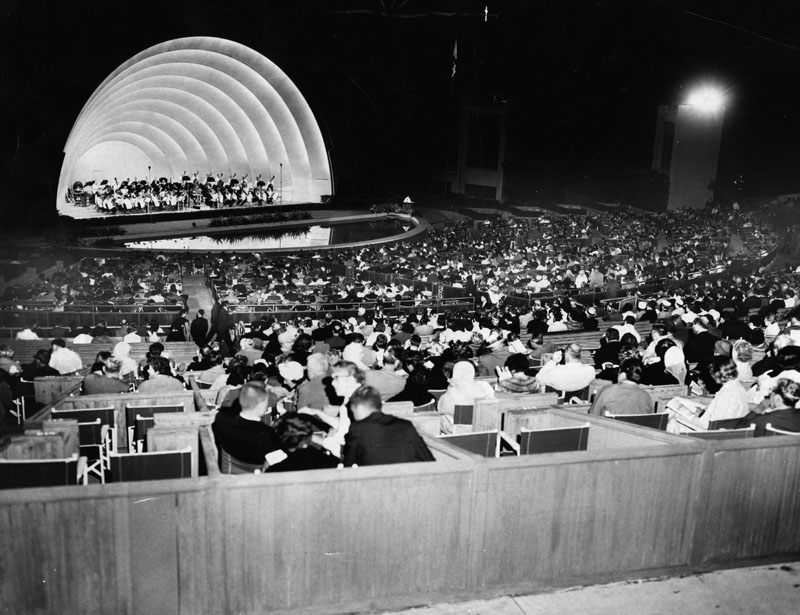 |
|
| (1960)* - Thousands of music lovers, including scores of society and civic leaders, jammed the Hollywood Bowl on July 5, 1960, as the amphitheater opened its 39th annual Symphonies Under the Stars. A typical Southern California summer evening brought a big crowd to the bowl for the gala opening. |
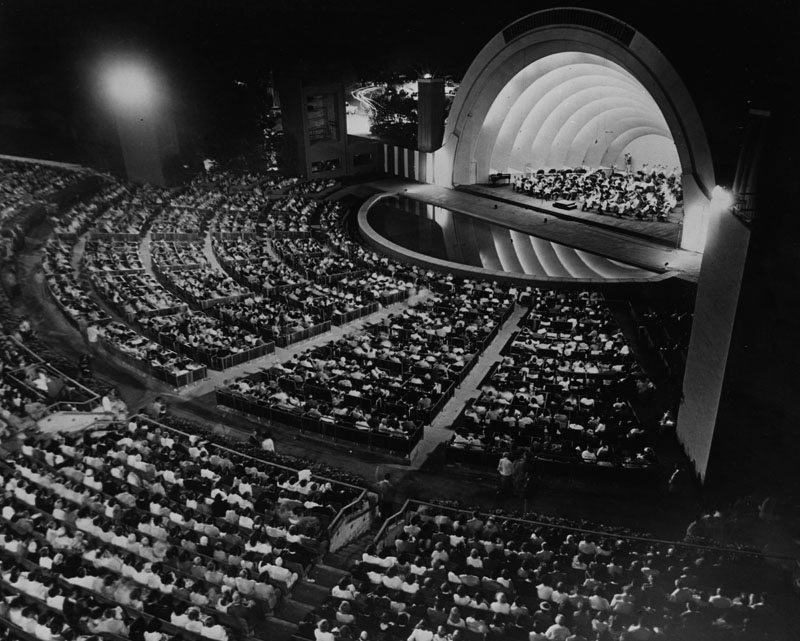 |
|
| (ca. 1960s)* - An orchastra plays for the crowd at the Hollywood Bowl, famous for "Symphonies Under the Stars." |
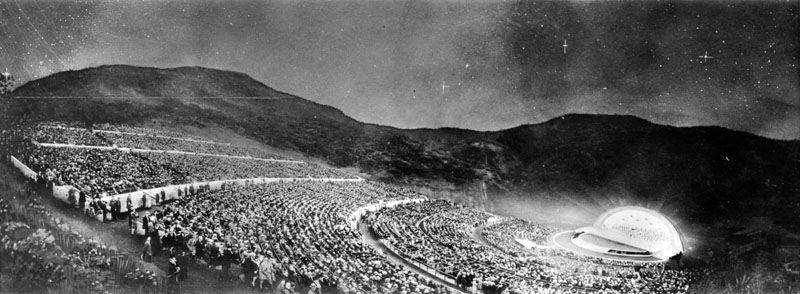 |
|
| (n.d.)* - Panoramic view of an evening concert held at the Hollywood Bowl. The venue is filled to capacity with not a seat to spare by thousands of music lovers. |
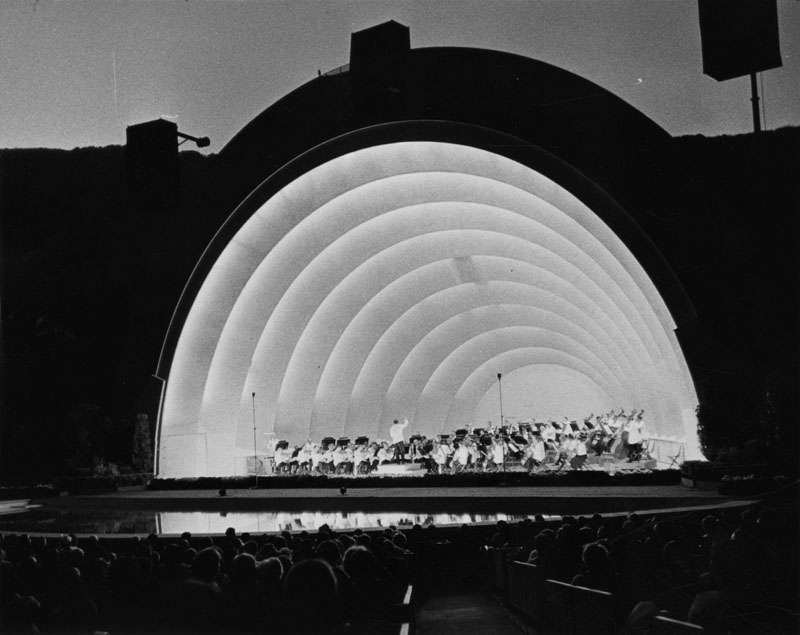 |
|
| (1963)* - Photograph caption dated July 16, 1963 reads, "The Hollywood Bowl looks this way as the Los Angeles Philharmonic Orchestra plays the opening number. The orchestra, now in its 44th season, performs all of the Symphonies Under the Stars Concerts and is composed of 100 musicians. Zubin Mehta is music director." |
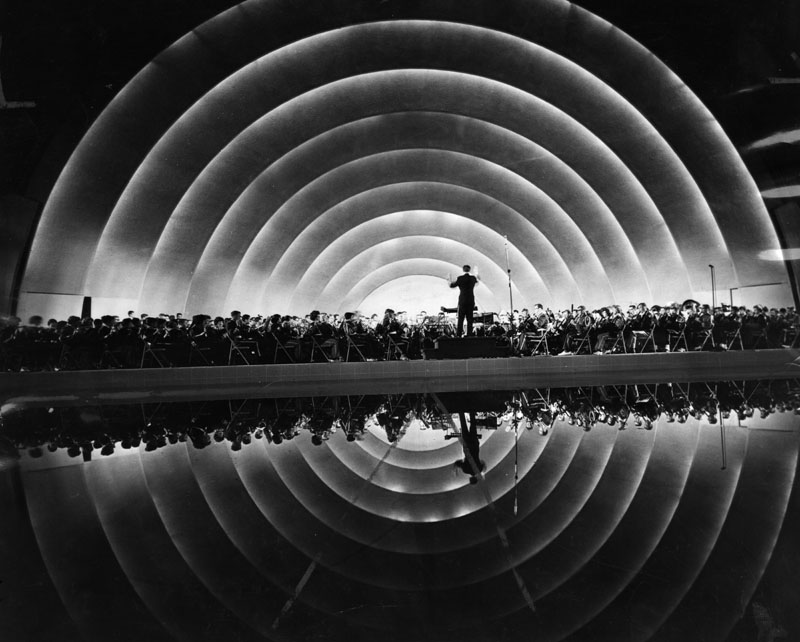 |
|
| (1963)* - Leonard Bernstein raises the baton and leads the New York Philharmonic Orchestra at the Hollywood Bowl. |
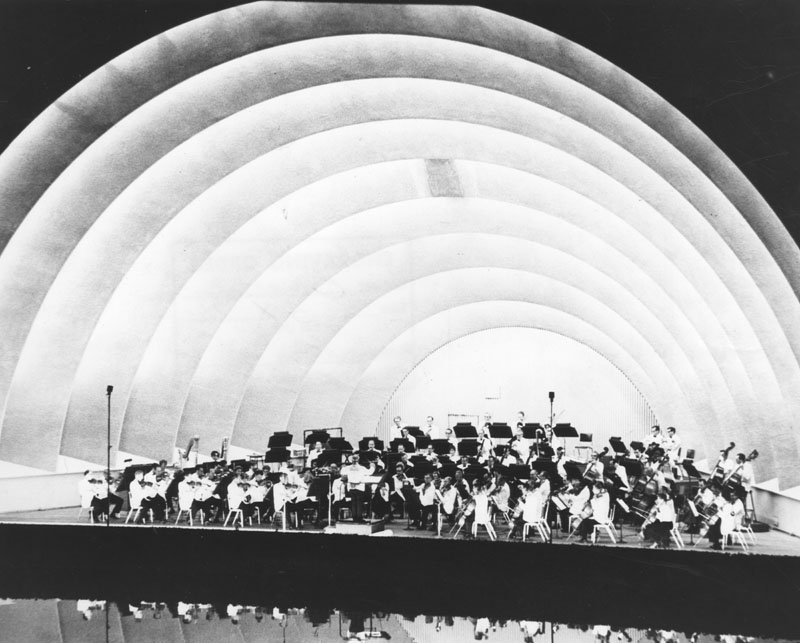 |
|
| (1964)* - Fausto Cleva conducts Hollywood Bowl Orchestra in works from Verdi, Strauss, Rossini and Wagner. An estimated 6,000 persons attended opening of the Hollywood Bowl's 43rd season of Symphonies under the Stars. |
Historical Notes The reflecting pool and fountains at the Hollywood Bowl were removed in 1972 primarily due to concerns about their impact on the venue's acoustics and the condition of performers' instruments. The pool, which was installed in 1953, and the fountains, added in 1959, were initially popular features. However, over time, it was found that the presence of the pool negatively affected the acoustics of the Bowl and caused damage to string instruments used by performers. Consequently, the pool was drained and later removed to improve the sound quality and protect the instruments. |
The Beatles at the Hollywood Bowl
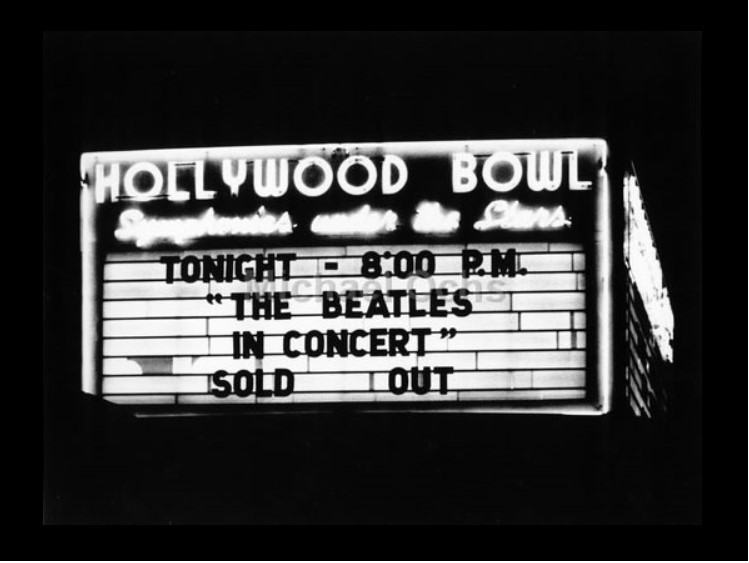 |
|
| (1964)* - The Hollywood Bowl Marquis when the Beatles were in town performing their first of two performances. They would appear again in 1965. |
Historical Notes Tickets went on sale four months before the concert and sold out in 3 1/2 hours. Hundreds of teenage girls camped out overnight on Highland Avenue and the next day the line went from the Bowl entrance nearly to Hollywood Boulevard. |
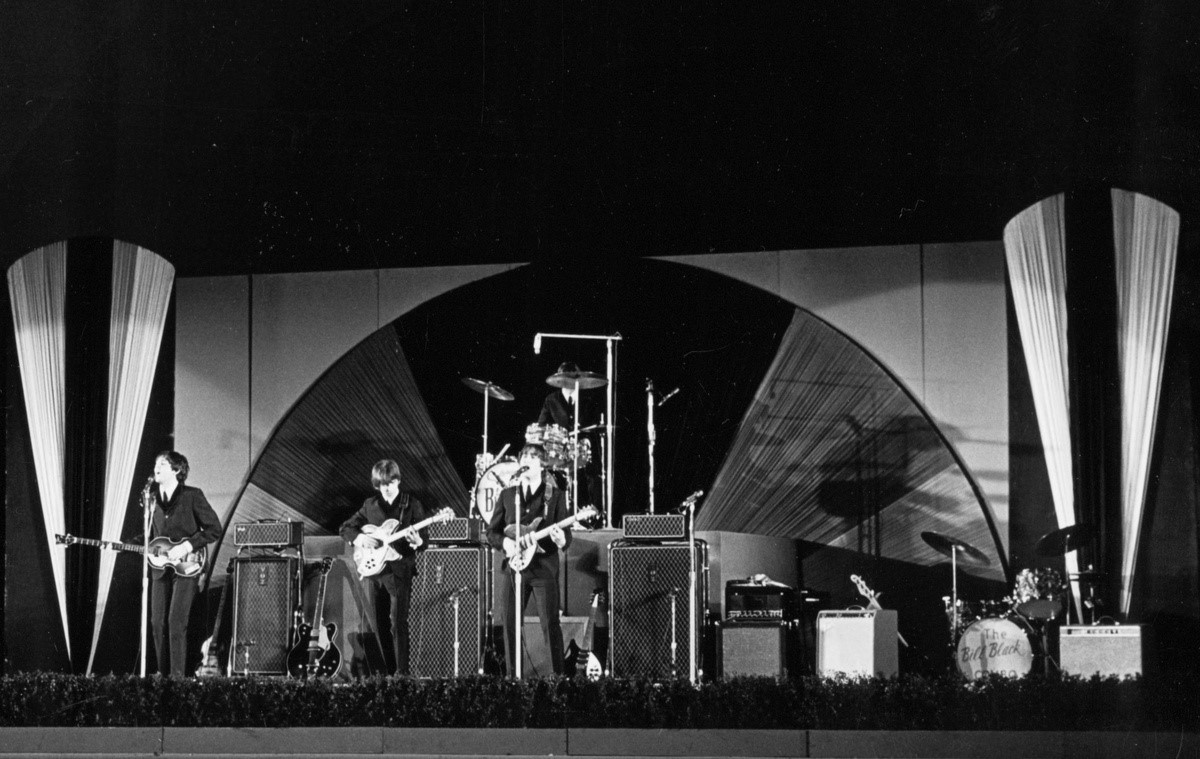 |
|
| (1964)* - The Beatles make their first appearance at the Hollywood Bowl. Photo courtesy of the Hollywood Bowl |
Historical Notes The screaming of the crowd was so loud, no one could hear the music. After the concert, kids mobbed the backstage area. The producers used a limo as a decoy while putting the Beatles in a Dodge Dart and getting them out before the kids realized they were gone. |
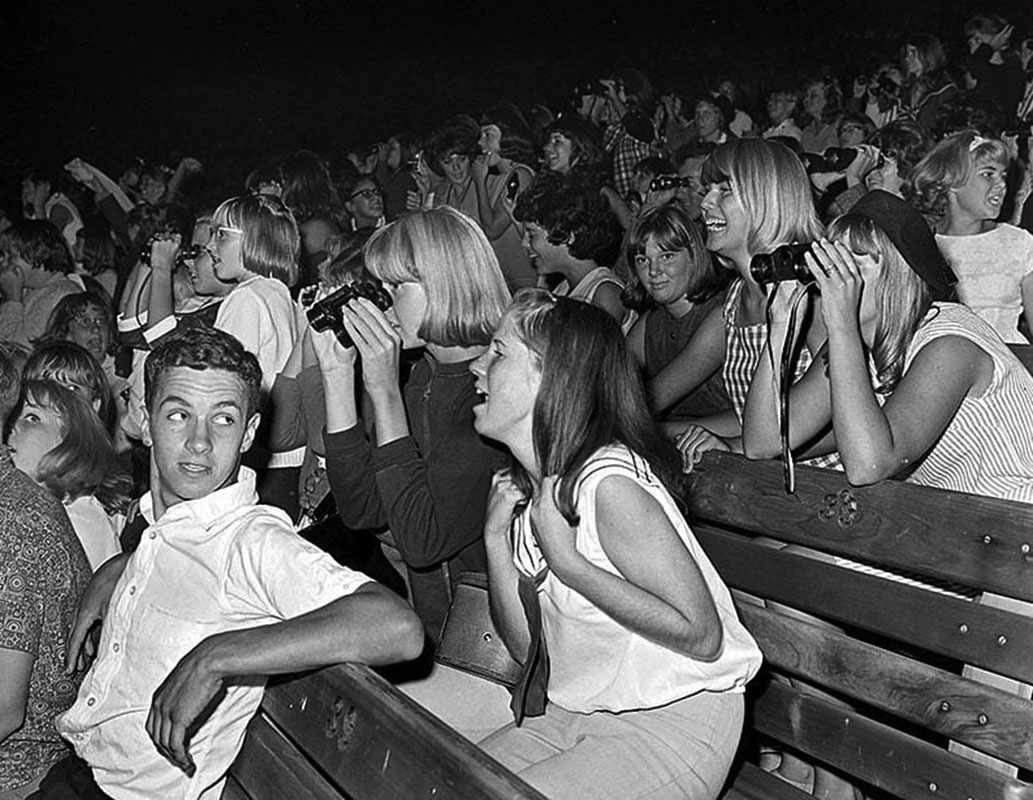 |
|
| (1964)* - The fans react to the Beatles at their first performance at the Hollywood Bowl. LA Times Photo |
Historical Notes Bob Eubanks booked The Beatles' for the August 23, 1964 performance at the Hollywood Bowl. Capitol Records recorded their performance with the intent of releasing a live album, however, the sound quality of the tapes proved to be inadequate for commercial release. |
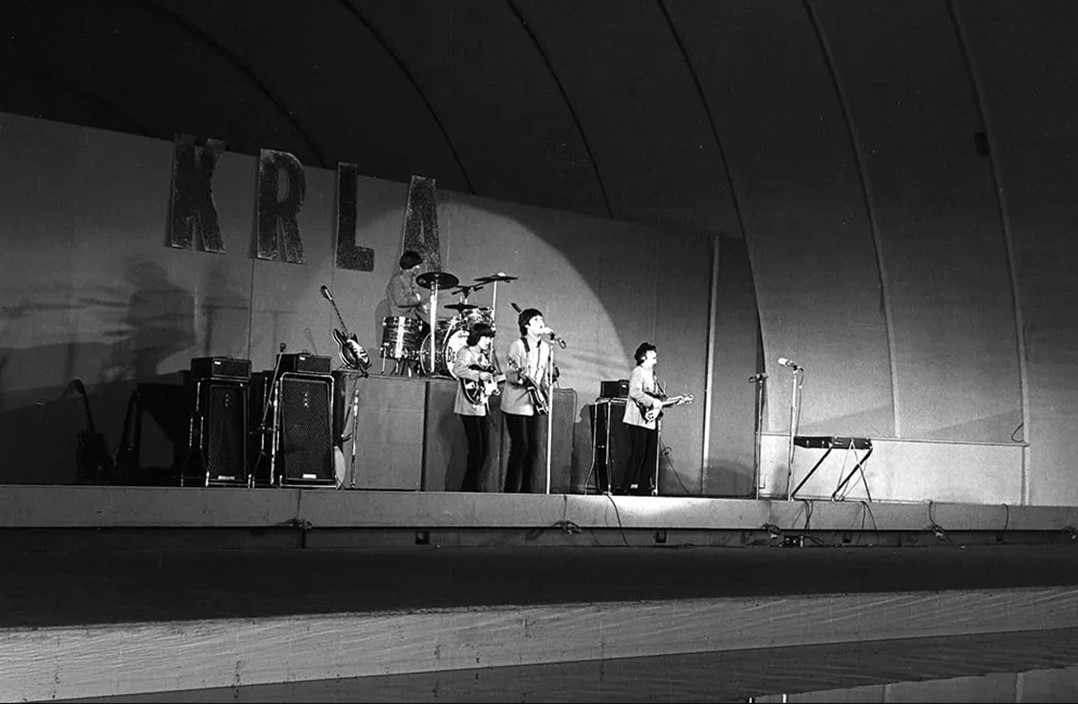 |
|
| (1965)* - The Beatles performing on stage at the Hollywood Bowl on August 29, 1965 (their 2nd Concert the following year). Photo courtesy of the Hollywood Bowl |
Historical Notes The Beatles returned the following year for two more shows: August 29th and 30th, 1965. After the previous year's pandemonium, the Bowl's management tried to avoid a panic situation by hiring a Brinks armored truck to bring the Beatles to and from their hotel. Since then, virtually every rock star (with the possible exception of Elvis) has played the Bowl. Capitol Records again recorded the two performances by the group as they did the previous year. The sound quality of the 1965 recordings was again disappointing. Capitol did, however, utilize a 48-second excerpt of "Twist and Shout" from the 1964 Hollywood Bowl concert on the 1964 documentary album, The Beatles' Story. |
* * * * * |
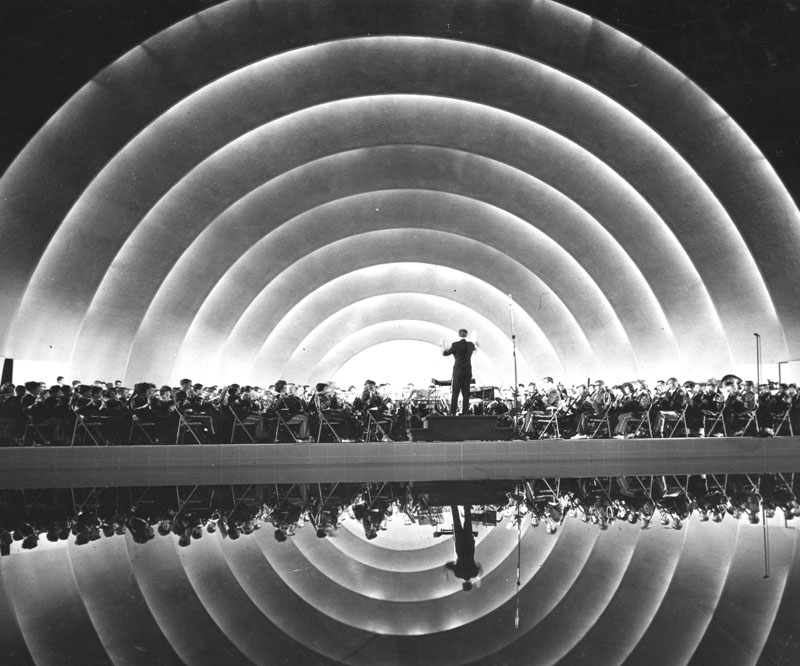 |
|
| (1968)* - View of the Hollywood Bowl where an orchestra plays their music on stage. Photo caption reads: "Reflection of the past: Where now there are box seats once lay a pool that gave the bowl visual resonance in addition to the aural kind." (This 1968 reprinted photo is a slightly modified version of the one shown earlier, dated 1963). |
Historical Notes The reflecting pool in front of the stage lasted from 1953 till 1972. |
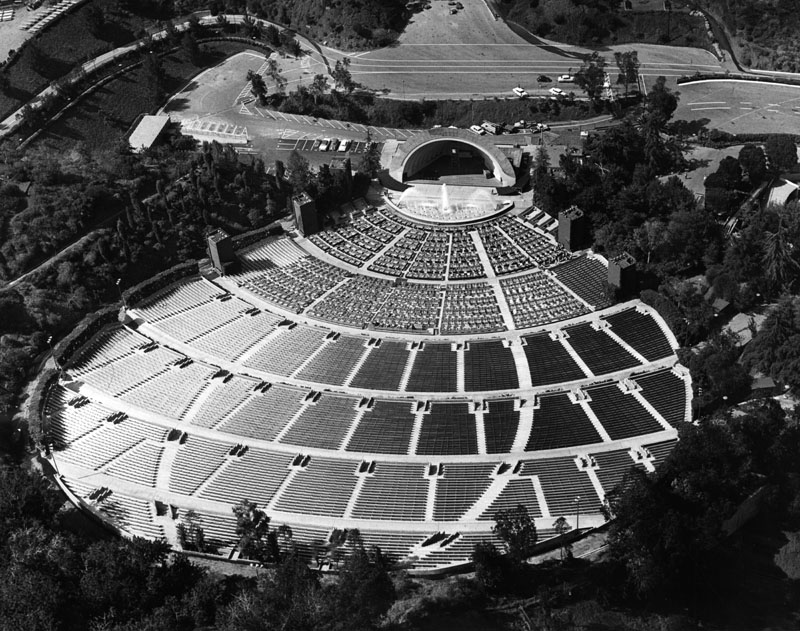 |
|
| (ca. 1970)* - View of the Hollywood Bowl, as seen from the hillside looking towards the shell. |
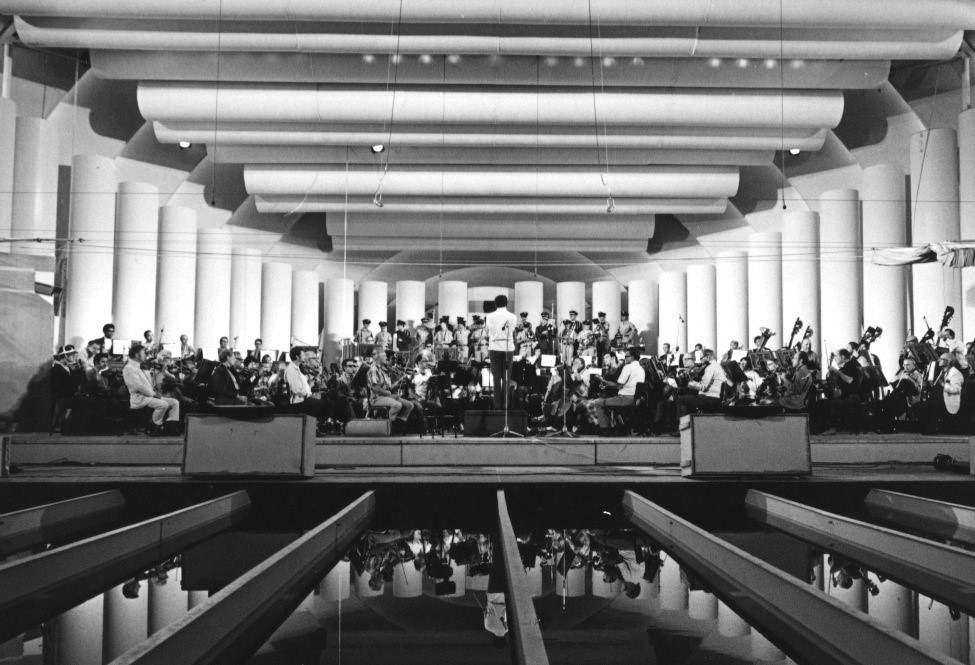 |
|
| (1970)* – View showing the Hollywood Bowl with new sonotubes, installed to enhance sound quality. The reflecting pool is seen in the foreground. |
Historical Notes Architect Frank Gehry and acoustician Christopher Jaffee were hired to improve the Bowl’s acoustics. They installed sonotubes, prefabricated cardboard forms used to create concrete columns, which were placed inside the shell and extended along the outer wings of the stage, enhancing the sound for both the audience and musicians. However, the placement of the sonotubes obstructed the views of the Bowl’s famous shell, which creates public outcry. |
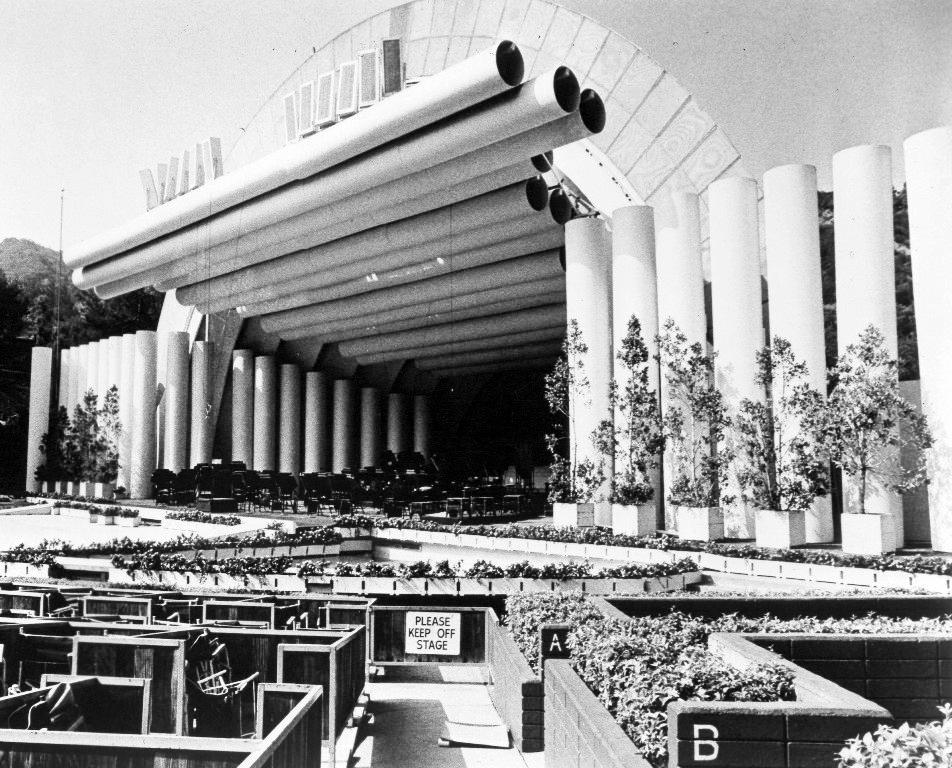 |
|
| (1972)* – View showing the Hollywood Bowl with its sonotubes. The reflecting pool (seen in the foreground) would be permanently drained and later removed during this season. |
Historical Notes In 1972, the reflecting pool was drained to eliminate further damage to the Bowl’s acoustics and the performers’ string instruments. An exclusive section of box seats with its own concierge and food service (installed in 1995) now occupy the space; it is named the "Pool Circle" in memory of the reflecting pool.. |
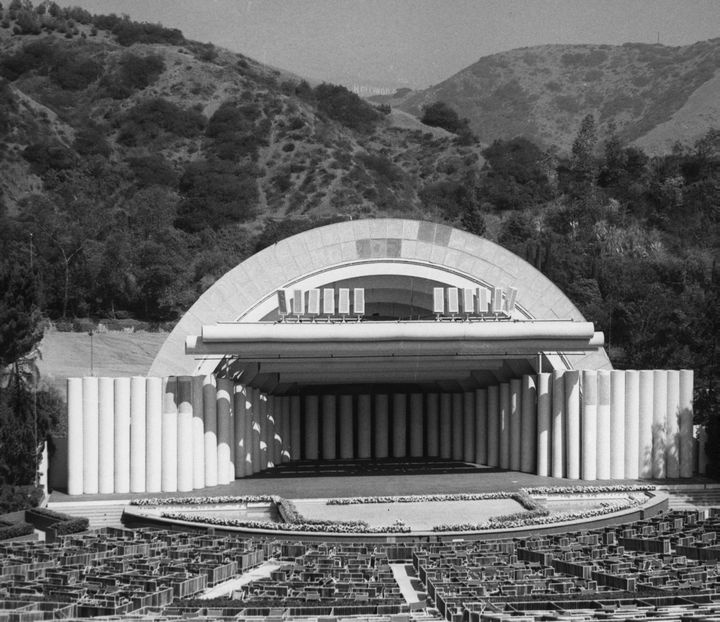 |
|
| (ca. 1972)* - Daytime view showing the Hollywood Bowl with its sonotubes. Note that the reflecting pool is covered over. |
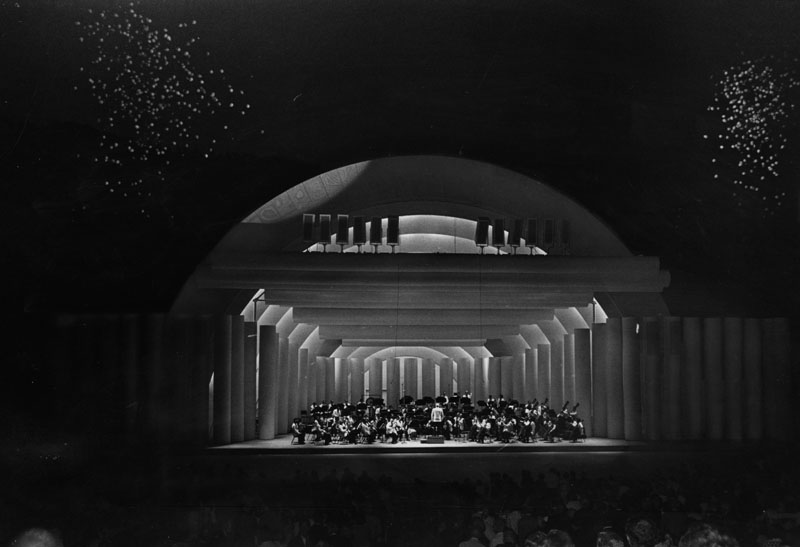 |
|
| (1970)* - Josef Krips prepares to conduct the Los Angeles Philharmonic Orchestra in Beethoven's "Leonore No. 3" during the opening night festivities of the Hollywood Bowl's 1970 summer season. |
Historical Notes Between 1926 and 1929 the Hollywood Bowl shell went through a series of four design modifications all in an effort to improve the acoustics. The 1929 shell stood until 2003. |
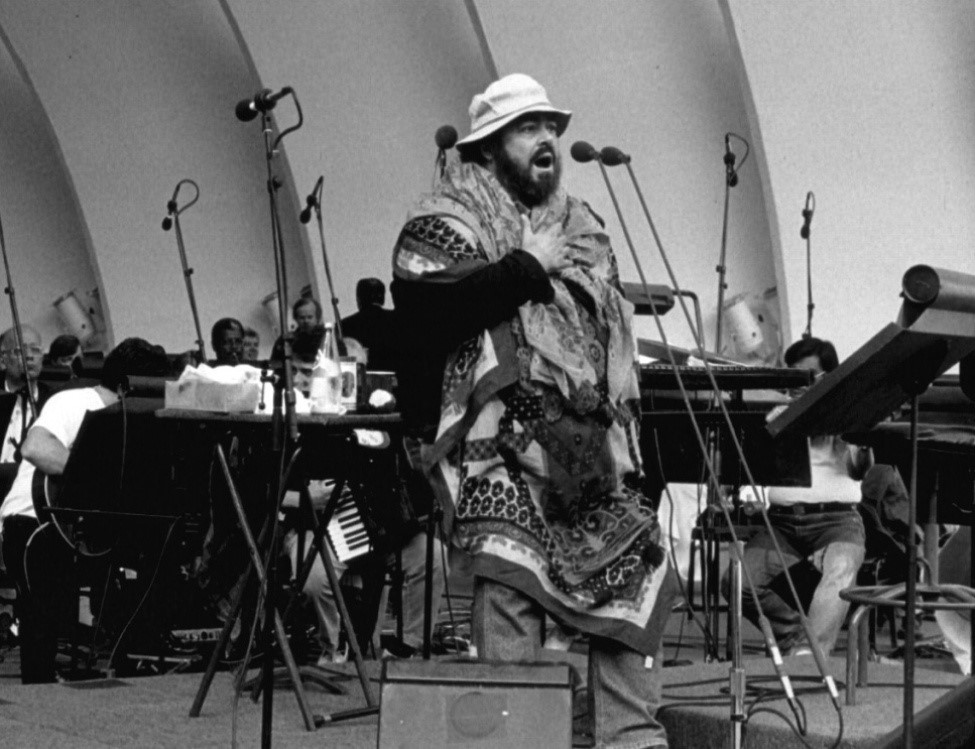 |
|
| (1973)* - Opera newcomer Luciano Pavarotti makes his Hollywood Bowl debut. He sings Rodolfo in a semi-staged production of Puccini’s La bohème. After achieving renown as one of the opera world’s greatest stars, Pavarotti becomes a Bowl favorite, consistently performing to sold-out crowds. Photo courtesy of the Hollywood Bowl |
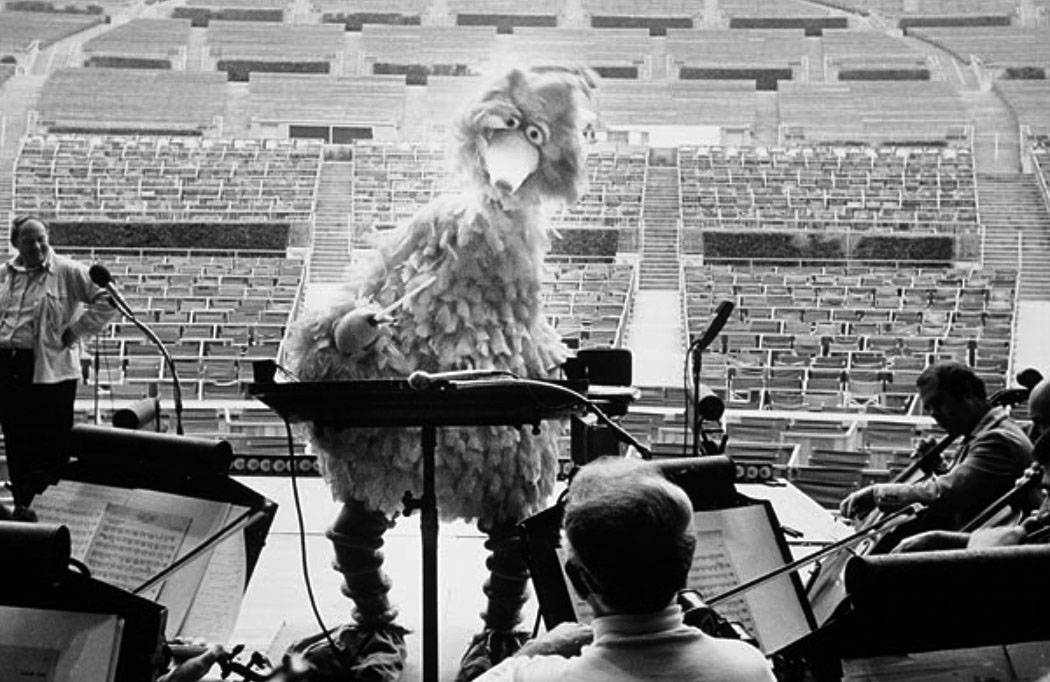 |
|
| (1977)* – Big Bird conducting the Los Angeles Philharmonic Orchestra. Photo courtesy of the Hollywood Bowl |
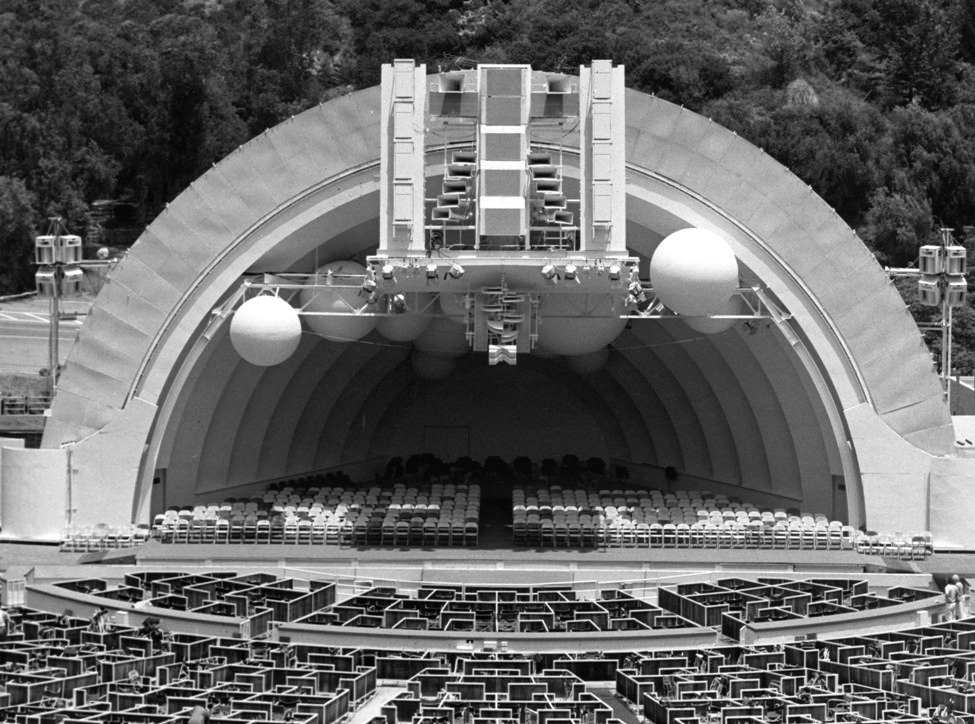 |
|
| (1980)* - Frank Gehry replaced the sonotubes with suspended hollow fiberglass spheres, allowing the musicians to hear one another better. |
Historical Notes 1980s Modification: To improve acoustics inside the 1929 shell, architect Frank Gehry added a series of large white fiberglass spheres, often referred to as the “acoustical balls.” These hung beneath the shell’s ceiling until the structure was demolished in 2003. |
 |
|
| (1980)* - Orchestra performing at Hollywood Bowl shortly after completion of modifications to improve acoustics. |
Historical Notes Architect Frank Gehry - who also designed Walt Disney Concert Hall - added the fiberglass spheres above the Bowl stage in 1980 to improve acoustics. |
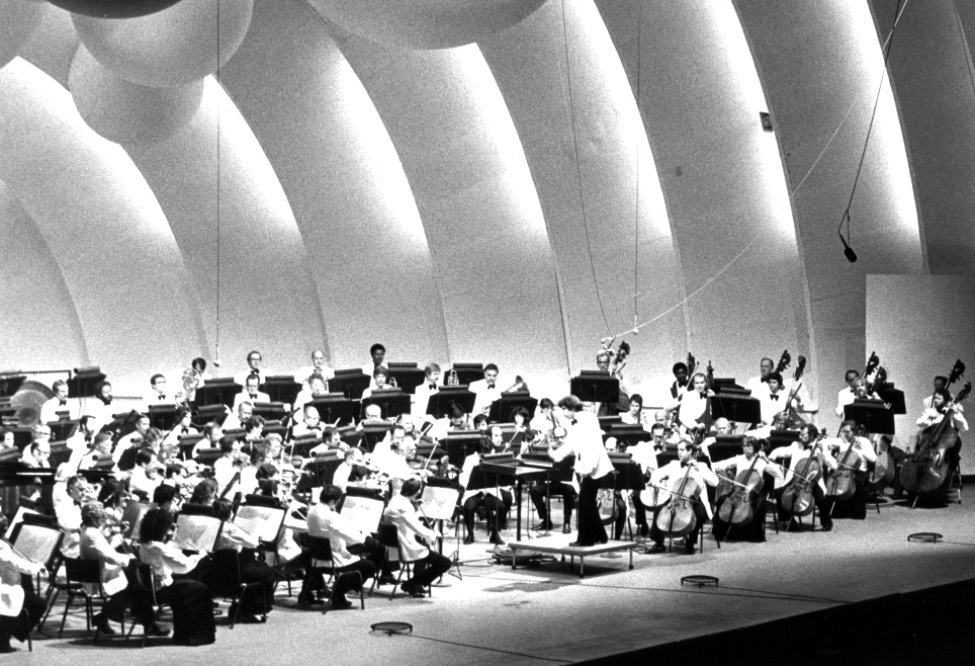 |
|
| (1982)* - Los Angeles Philharmonic Guest Conductor Michael Tilson Thomas conducts Michel Beroff in Stravinsky’s Movements for Piano and Orchestra as part of a two week Stravinsky Centenary Festival at the Bowl. |
Historical Notes The Hollywood Bowl is known for its band shell, a distinctive set of concentric arches that graced the site from 1929 through 2003, before being replaced with a somewhat larger one beginning in the 2004 season. |
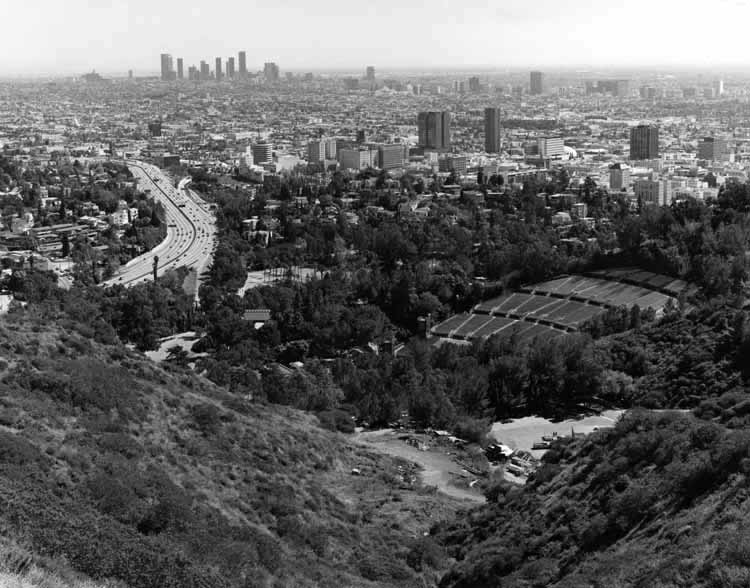 |
|
| (1989)* - View of the Hollywood Bowl as seen from Mulholland Drive. In the background can be seen Hollywood, the Wilshire corridor and Downtown Los Angeles. |
* * * * * |
2004 Shell (Current Shell)
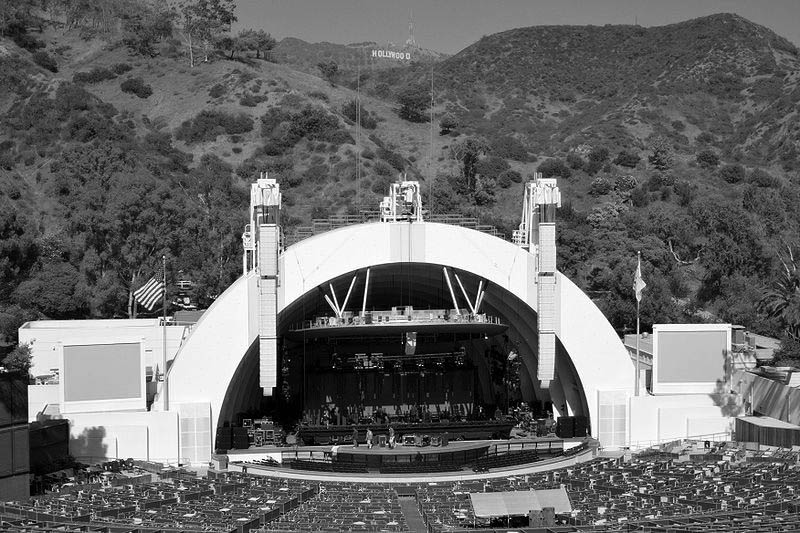 |
|
| (2005)* - View of the newly completed Hollywood Bowl shell and acoustic canopy, unveiled in 2004 after a major renovation. The Hollywood Sign can be seen in the background. |
Historical Notes After nearly a decade of planning and nine months of construction, the Hollywood Bowl unveiled its new shell in 2004. Designed to retain the Bowl’s classic silhouette while vastly improving acoustics, the new structure incorporates a state-of-the-art canopy and advanced sound system. Two large video screens near the stage, along with two more set farther back in the seating area, were added to enhance visibility for all concertgoers. Though its look evokes the iconic 1929 shell, the design was engineered to meet the demands of 21st-century performances, ensuring an improved experience for both audiences and artists. |
Then and Now
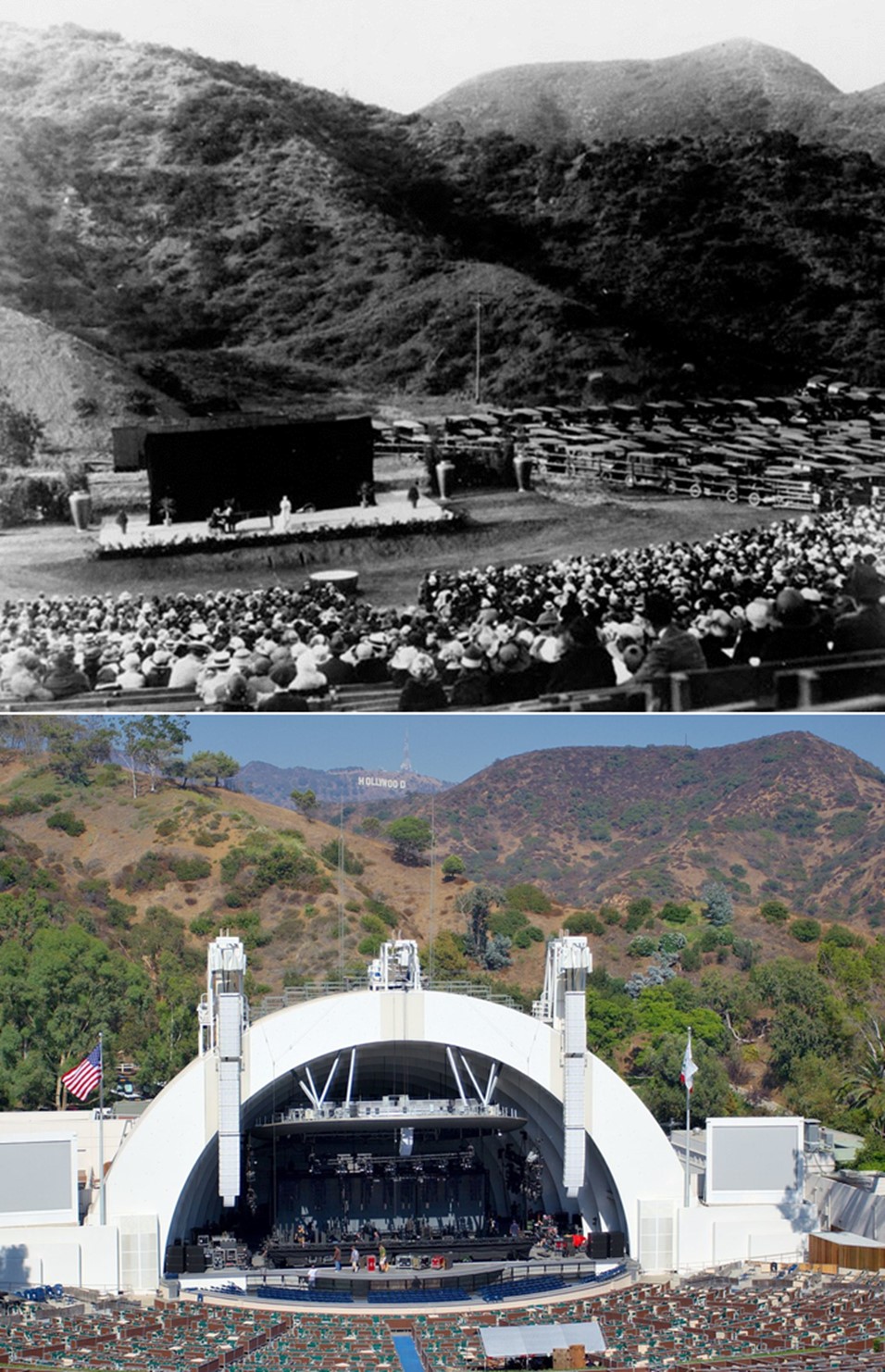 |
|
| (1922 vs 2005)* - A ‘Then and Now’ view of the Hollywood Bowl: from its humble wooden platform in 1922 to the redesigned shell completed in 2004. Photo comparison by Jack Feldman. |
Historical Notes This side-by-side comparison spans more than 80 years of transformation at the Hollywood Bowl. In 1922, the venue was little more than a natural hillside amphitheater with a wooden stage. Over the decades, the Bowl underwent successive upgrades in stage design, acoustics, and amenities, culminating in the sweeping modern shell of 2004. Despite these changes, the Bowl has preserved its essential spirit: a world-famous outdoor cultural landmark set against the dramatic Hollywood Hills, watched over by the Hollywood Sign. |
Hollywood Bowl Shells: Then and Now (1926–Present)
 |
|
| (1926 - 2004)* - Nearly a century of music under five evolving shells, from wooden beginnings to today’s modern acoustic landmark. |
Historical Notes
*The last Hollywood Bowl shell was completed in 2004, making it the fifth in the venue’s history. |
* * * * * |
Please Support Our CauseWater and Power Associates, Inc. is a non-profit, public service organization dedicated to preserving historical records and photos. Your generosity allows us to continue to disseminate knowledge of the rich and diverse multicultural history of the greater Los Angeles area; to serve as a resource of historical information; and to assist in the preservation of the city's historic records. |
More Historical Early Views
Newest Additions
Early LA Buildings and City Views
History of Water and Electricity in Los Angeles
* * * * * |
References and Credits
* LA Public Library Image Archive
^ About.com: Hollywood Bowl - Kate Deioma
^^LAPHIL.com: 100 Most Noteworthy, Interesting, and Remarkable Hollywood Bowl Moments
*# LA Times: The Los Angeles Philharmonic Through the Years
#* Facebook: Early Views of the Hollywood Bowl
*^*Forum.Skyscraperpage: Life Magazine - Hollywood Bowl; Gruen Sign
^#*94.7-The-Wave: Rehearsal at the Hollywood Bowl
*#^Flickr.com: Michael Ryerson
^**Facebook: San Fernando Valley Relics
^^#Huntington Digital Library Archive
^*#Calisphere: University of California Image Archive
^*^Pinterest: Art Deco - Los Angeles
^^*Pinterest: Hollywood HIstory
^^^California State Library Image Archive
**^Noirish Los Angeles - forum.skyscraperpage.com; Rehearsal Blind
*^^KCET - Inventing LA: Hollywood Bowl
**#iandimusic.com: Hollywood Bowl
*##Facebook.com: Garden of Allah Novels – Martin Turnbull
#^^Framework LATimes.com: Hollywood Bowl
*^*#Facebook.com: Classic Hollywood-Los Angeles-SFV
^*^^Pomona Public Library Poscard Collection
*^ Wikipedia: Hollywood Bowl; Christine Weatherill Stevenson; Hollywood Freeway; Julius Caesar Play; The Beatles at the Hollywood Bowl; Hollywood Freeway; John Anson Ford Theatre
< Back
Menu
- Home
- Mission
- Museum
- Major Efforts
- Recent Newsletters
- Historical Op Ed Pieces
- Board Officers and Directors
- Mulholland/McCarthy Service Awards
- Positions on Owens Valley and the City of Los Angeles Issues
- Legislative Positions on
Water Issues
- Legislative Positions on
Energy Issues
- Membership
- Contact Us
- Search Index